Chicony Electronics Co KT-1572 HP ZBOOK X2 KEYBOARD User Manual User Guide
Chicony Electronics Co Ltd HP ZBOOK X2 KEYBOARD User Guide
Contents
- 1. User Manual rev.pdf
- 2. User Manual (Statement) rev 6.pdf
User Manual rev.pdf
User Guide

© Copyright 2017 HP Development Company,
L.P.
Adobe Photoshop and Illustrator are either
registered trademarks or trademarks of Adobe
Systems Incorporated in the United States
and/or other coutnries. Bluetooth is a
trademark owned by its proprietor and used by
HP Inc. under license. Intel and Thunderbolt are
trademarks of Intel Corporation in the U.S. and
other countries. Windows is either a registered
trademark or trademark of Microsoft
Corporation in the United States and/or other
countries.
The information contained herein is subject to
change without notice. The only warranties for
HP products and services are set forth in the
express warranty statements accompanying
such products and services. Nothing herein
should be construed as constituting an
additional warranty. HP shall not be liable for
technical or editorial errors or omissions
contained herein.
First Edition: July 2017
Document Part Number: 913263–001
Product notice
This user guide describes features that are
common to most models. Some features may
not be available on your computer.
Not all features are available in all editions or
versions of Windows. Systems may require
upgraded and/or separately purchased
hardware, drivers, software or BIOS update to
take full advantage of Windows functionality.
Windows 10 is automatically updated, which is
always enabled. ISP fees may apply and
additional requirements may apply over time
for updates. See http://www.microsoft.com.
To access the latest user guides or manuals for
your product, go to http://www.hp.com/
support. Select Find your product, and then
follow the on-screen instructions.
Software terms
By installing, copying, downloading, or
otherwise using any software product
preinstalled on this computer, you agree to be
bound by the terms of the HP End User License
Agreement (EULA). If you do not accept these
license terms, your sole remedy is to return the
entire unused product (hardware and software)
within 14 days for a full refund subject to the
refund policy of your seller.
For any further information or to request a full
refund of the price of the computer, please
contact your seller.
Your product does not support Windows 8 or
Windows 7. In accordance with Microsoft’s
support policy, HP does not support the
Windows 8 or Windows 7 operating system on
this product or provide any Windows 8 or
Windows 7 drivers on http://support.hp.com.

Safety warning notice
WARNING! To reduce the possibility of heat-related injuries or of overheating the computer, do not place
the computer directly on your lap or obstruct the computer air vents. Use the computer only on a hard, at
surface. Do not allow another hard surface, such as an adjoining optional printer, or a soft surface, such as
pillows or rugs or clothing, to block airow. Also, do not allow the AC adapter to come into contact with the
skin or a soft surface, such as pillows or rugs or clothing, during operation. The computer and the AC adapter
comply with the user-accessible surface temperature limits dened by the International Standard for Safety
of Information Technology Equipment (IEC 60950).
iii
iv Safety warning notice

Table of contents
1 Welcome ....................................................................................................................................................... 1
Finding information ............................................................................................................................................... 2
2 Components .................................................................................................................................................. 4
Locating hardware ................................................................................................................................................. 4
Locating software .................................................................................................................................................. 4
Right ....................................................................................................................................................................... 4
Left ......................................................................................................................................................................... 6
Front ....................................................................................................................................................................... 7
Keyboard base components ................................................................................................................................ 10
TouchPad ........................................................................................................................................... 10
Lights ................................................................................................................................................. 11
Keyboard connectors, button, and status light ................................................................................ 11
Special keys ....................................................................................................................................... 13
Action keys ........................................................................................................................................ 14
Hot keys ............................................................................................................................................. 15
USB port and smart card reader/pen holder slot (select products only) .......................................... 15
Connecting the tablet to the keyboard base ..................................................................................... 16
Removing the tablet from the keyboard base .................................................................................. 17
Using the keyboard wirelessly ........................................................................................ 17
Setting the Bluetooth pairing automatically ............................................... 17
Setting the Bluetooth pairing manually ....................................................... 18
Top ........................................................................................................................................................................ 19
Bottom ................................................................................................................................................................. 19
Rear ...................................................................................................................................................................... 19
Labels ................................................................................................................................................................... 20
Optional pen ........................................................................................................................................................ 21
3 Network connections ................................................................................................................................... 23
Connecting to a wireless network ....................................................................................................................... 23
Using the wireless controls ............................................................................................................... 23
Wireless button ............................................................................................................... 23
Operating system controls ............................................................................................. 23
Connecting to a WLAN ....................................................................................................................... 24
Using HP Mobile Broadband (select products only) .......................................................................... 24
Using HP Mobile Connect Pro (select products only) ........................................................................ 25
v
Using GPS (select products only) ...................................................................................................... 25
Using Bluetooth wireless devices (select products only) ................................................................. 25
Connecting Bluetooth devices ........................................................................................ 25
Using NFC to share information (select products only) .................................................................... 25
Sharing ............................................................................................................................ 26
Connecting to a wired network ............................................................................................................................ 27
Connecting to a local area network (LAN) (select products only) .................................................... 27
Using HP LAN-WLAN Protection (select products only) .................................................................... 28
Turning on and customizing HP LAN-WLAN Protection ................................................. 28
Using HP MAC Address Manager to identify your computer on a network (select products only) ..................... 28
Turning on and customizing the system MAC address ..................................................................... 28
4 Navigating the screen .................................................................................................................................. 30
Using TouchPad and touch screen gestures ........................................................................................................ 30
Tap ..................................................................................................................................................... 30
Two-nger pinch zoom ..................................................................................................................... 31
Two-nger slide (TouchPad only) ..................................................................................................... 31
Two-nger tap (TouchPad only) ........................................................................................................ 31
Four-nger tap (TouchPad only) ....................................................................................................... 31
Three-nger swipe (TouchPad only) ................................................................................................. 32
One-nger slide (touch screen only) ................................................................................................. 33
Using an optional keyboard or mouse ................................................................................................................. 33
Using an on-screen keyboard (select products only) .......................................................................................... 33
5 HP ZBook x2 Control software ...................................................................................................................... 34
Installing the HP ZBook x2 Control software ...................................................................................................... 34
Starting the HP ZBook x2 Control software ........................................................................................................ 34
Customizing tools ................................................................................................................................................ 34
Programming the Quick Keys ............................................................................................................ 34
Customizing the optional pen ........................................................................................................... 35
Advanced customizing for the pen ................................................................................. 35
Customizing the eraser ................................................................................................... 36
Button functions ............................................................................................................. 36
Calibrating the pen .......................................................................................................... 38
Setting advanced options ............................................................................................... 38
Adding applications ............................................................................................................................................. 38
Customizing the on-screen control menu ........................................................................................................... 39
Adding devices ..................................................................................................................................................... 40
Adding tools ......................................................................................................................................................... 40
Viewing button mappings .................................................................................................................................... 40
Backing up and restoring settings ....................................................................................................................... 41
vi
Importing expert settings ................................................................................................................................... 41
Updating the HP ZBook x2 Control software ...................................................................................................... 42
Determining the software version .................................................................................................... 42
Downloading a software update ....................................................................................................... 42
Troubleshooting ................................................................................................................................................... 43
6 Entertainment features ............................................................................................................................... 44
Using a camera (select products only) ................................................................................................................ 44
Using audio .......................................................................................................................................................... 44
Connecting speakers ......................................................................................................................... 44
Connecting headphones .................................................................................................................... 44
Connecting headsets ......................................................................................................................... 45
Using sound settings ......................................................................................................................... 45
Using video .......................................................................................................................................................... 45
Connecting video devices using a USB Type-C cable (select products only) .................................... 46
Connecting video devices using an HDMI cable (select products only) ............................................ 47
Setting up HDMI audio .................................................................................................... 47
Discovering and connecting to Miracast-compatible wireless displays (select products only) ...... 48
Discovering and connecting to Intel WiDi certied displays (select Intel products only) ................ 48
7 Managing power .......................................................................................................................................... 49
Using Sleep and Hibernation ............................................................................................................................... 49
Initiating and exiting Sleep ............................................................................................................... 49
Initiating and exiting Hibernation (select products only) ................................................................. 50
Shutting down (turning o) the computer .......................................................................................................... 50
Using the Power icon and Power Options ............................................................................................................ 51
Running on battery power ................................................................................................................................... 51
Using HP Fast Charge (select products only) .................................................................................... 51
Displaying battery charge ................................................................................................................. 52
Finding battery information in HP Support Assistant (select products only) .................................. 52
Conserving battery power ................................................................................................................. 52
Identifying low battery levels ........................................................................................................... 52
Resolving a low battery level ............................................................................................................ 53
Resolving a low battery level when external power is available ................................... 53
Resolving a low battery level when no power source is available ................................. 53
Resolving a low battery level when the computer cannot exit Hibernation .................. 53
Factory-sealed battery ...................................................................................................................... 53
Running on external power ................................................................................................................................. 53
Managing power for the keyboard base .............................................................................................................. 54
Viewing battery charge ..................................................................................................................... 54
Resolving a keyboard low battery level ............................................................................................ 54
vii
8 Security ...................................................................................................................................................... 55
Protecting the computer ..................................................................................................................................... 55
Using passwords .................................................................................................................................................. 55
Setting passwords in Windows ......................................................................................................... 56
Setting passwords in Computer Setup ............................................................................................. 57
Managing a BIOS administrator password ........................................................................................ 57
Entering a BIOS administrator password ....................................................................... 59
Using DriveLock Security Options ..................................................................................................... 59
Selecting Automatic DriveLock (select products only) ................................................... 59
Enabling Automatic DriveLock ..................................................................... 59
Disabling Automatic DriveLock .................................................................... 60
Entering an Automatic DriveLock password ................................................ 60
Selecting manual DriveLock ........................................................................................... 60
Setting a DriveLock master password ......................................................... 61
Enabling DriveLock and setting a DriveLock user password ......................................... 61
Disabling DriveLock ........................................................................................................ 62
Entering a DriveLock password ...................................................................................... 62
Changing a DriveLock password ..................................................................................... 62
Using Windows Hello (select products only) ....................................................................................................... 63
Using antivirus software ...................................................................................................................................... 63
Using rewall software ........................................................................................................................................ 63
Installing software updates ................................................................................................................................. 64
Using HP Client Security (select products only) .................................................................................................. 64
Using HP Touchpoint Manager (select products only) ........................................................................................ 64
Using an optional security cable (select products only) ..................................................................................... 64
Using a ngerprint reader (select products only) ............................................................................................... 65
Locating the ngerprint reader ......................................................................................................... 65
9 Maintenance ............................................................................................................................................... 66
Improving performance ....................................................................................................................................... 66
Using Disk Defragmenter .................................................................................................................. 66
Using Disk Cleanup ............................................................................................................................ 66
Using HP 3D DriveGuard (select products only) ................................................................................ 66
Identifying HP 3D DriveGuard status .............................................................................. 67
Updating programs and drivers .......................................................................................................................... 67
Cleaning your computer ...................................................................................................................................... 67
Cleaning procedures .......................................................................................................................... 67
Cleaning the display ........................................................................................................ 68
Cleaning the sides or cover ............................................................................................. 68
Cleaning the TouchPad, keyboard, or mouse (select products only) ............................. 68
viii
Traveling with or shipping your computer .......................................................................................................... 68
10 Backing up, restoring, and recovering ......................................................................................................... 70
Creating recovery media and backups ................................................................................................................ 70
Creating HP Recovery media (select products only) ......................................................................... 70
Using Windows tools ........................................................................................................................................... 71
Restore and recovery ........................................................................................................................................... 72
Recovering using HP Recovery Manager ........................................................................................... 72
What you need to know before you get started ............................................................. 72
Using the HP Recovery partition (select products only) ................................................. 73
Using HP Recovery media to recover .............................................................................. 73
Changing the computer boot order ................................................................................ 74
Removing the HP Recovery partition (select products only) ......................................... 74
11 Computer Setup (BIOS), TPM, and HP Sure Start ........................................................................................... 75
Using Computer Setup ......................................................................................................................................... 75
Starting Computer Setup .................................................................................................................. 75
Navigating and selecting in Computer Setup ................................................................................... 75
Restoring factory settings in Computer Setup ................................................................................. 75
Updating the BIOS ............................................................................................................................. 77
Determining the BIOS version ......................................................................................... 77
Downloading a BIOS update ........................................................................................... 77
Changing the boot order using the f9 prompt .................................................................................. 78
TPM BIOS settings (select products only) ........................................................................................................... 78
Using HP Sure Start (select products only) ......................................................................................................... 78
12 Using HP PC Hardware Diagnostics (UEFI) ..................................................................................................... 80
Downloading HP PC Hardware Diagnostics (UEFI) to a USB device .................................................................... 80
13 Specications ............................................................................................................................................ 82
Input power .......................................................................................................................................................... 82
Operating environment ....................................................................................................................................... 82
14 Electrostatic Discharge .............................................................................................................................. 83
15 Accessibility .............................................................................................................................................. 84
Supported assistive technologies ....................................................................................................................... 84
Contacting support .............................................................................................................................................. 84
Index ............................................................................................................................................................. 85
ix
x
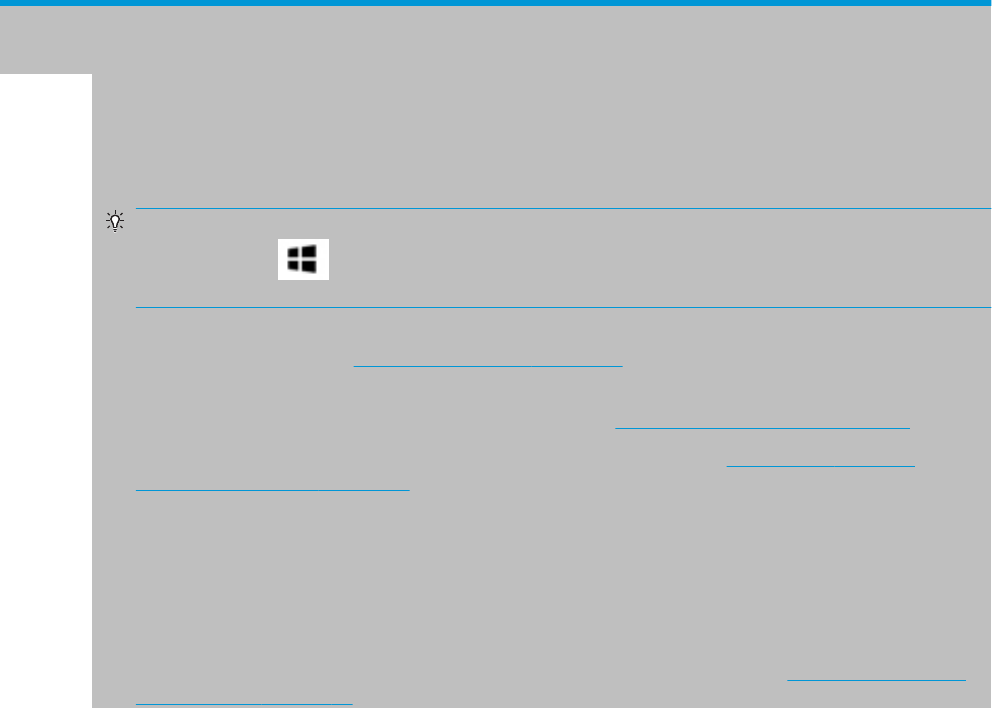
1 Welcome
After you set up and register the computer, we recommend the following steps to get the most out of your
smart investment:
●TIP: To quickly return to the computer Start screen from an open app or the Windows desktop, press
the Windows key on your keyboard. Pressing the Windows key again will return you to the
previous screen.
●Connect to the Internet—Set up your wired or wireless network so that you can connect to the Internet.
For more information, see Network connections on page 23.
●Update your antivirus software—Protect your computer from damage caused by viruses. The software
is preinstalled on the computer. For more information, see Using antivirus software on page 63.
●Get to know your computer—Learn about your computer features. See Components on page 4 and
Navigating the screen on page 30 for additional information.
●Find installed software—Access a list of the software preinstalled on the computer:
Select the Start button.
‒ or –
Right-click the Start button, and then select Apps and Features.
●Back up your hard drive by creating recovery discs or a recovery ash drive. See Backing up, restoring,
and recovering on page 70.
1

Finding information
To locate resources that provide product details, how-to information, and more, use this table.
Resource Contents
Setup Instructions ●Overview of computer setup and features
HP support
For HP support, go to http://www.hp.com/support.
●Online chat with an HP technician
●Support telephone numbers
●Replacement parts videos (select products only)
●Maintenance and service guides
●HP service center locations
Safety & Comfort Guide
To access this guide:
▲Select the Start button, select HP Help and Support,
and then select HP Documentation.
‒ or –
▲Select the Start button, select HP, and then select HP
Documentation.
‒ or –
▲Go to http://www.hp.com/ergo.
IMPORTANT: You must be connected to the Internet
to access the latest version of the user guide.
●Proper workstation setup
●Guidelines for posture and work habits that increase your comfort
and decrease your risk of injury
●Electrical and mechanical safety information
Regulatory, Safety and Environmental Notices
To access this document:
▲Select the Start button, select HP Help and Support,
and then select HP Documentation.
‒ or –
▲Select the Start button, select HP, and then select HP
Documentation.
●Important regulatory notices, including information about proper
battery disposal, if needed.
Limited Warranty*
To access this document:
▲Select the Start button, select HP Help and Support,
and then select HP Documentation.
‒ or –
▲Select the Start button, select HP, and then select HP
Documentation.
‒ or –
▲Go to http://www.hp.com/go/orderdocuments.
IMPORTANT: You must be connected to the Internet
to access the latest version of the user guide.
●Specic warranty information about this computer
*You can nd your HP Limited Warranty located with the user guides on your product and/or on the CD or DVD provided in the box. In
some countries or regions, HP may provide a printed warranty in the box. For countries or regions where the warranty is not provided
in printed format, you can request a copy from http://www.hp.com/go/orderdocuments. For products purchased in Asia Pacic, you can
2 Chapter 1 Welcome

Resource Contents
write to HP at POD, PO Box 161, Kitchener Road Post Oce, Singapore 912006. Include your product name, and your name, phone
number, and postal address.
Finding information 3
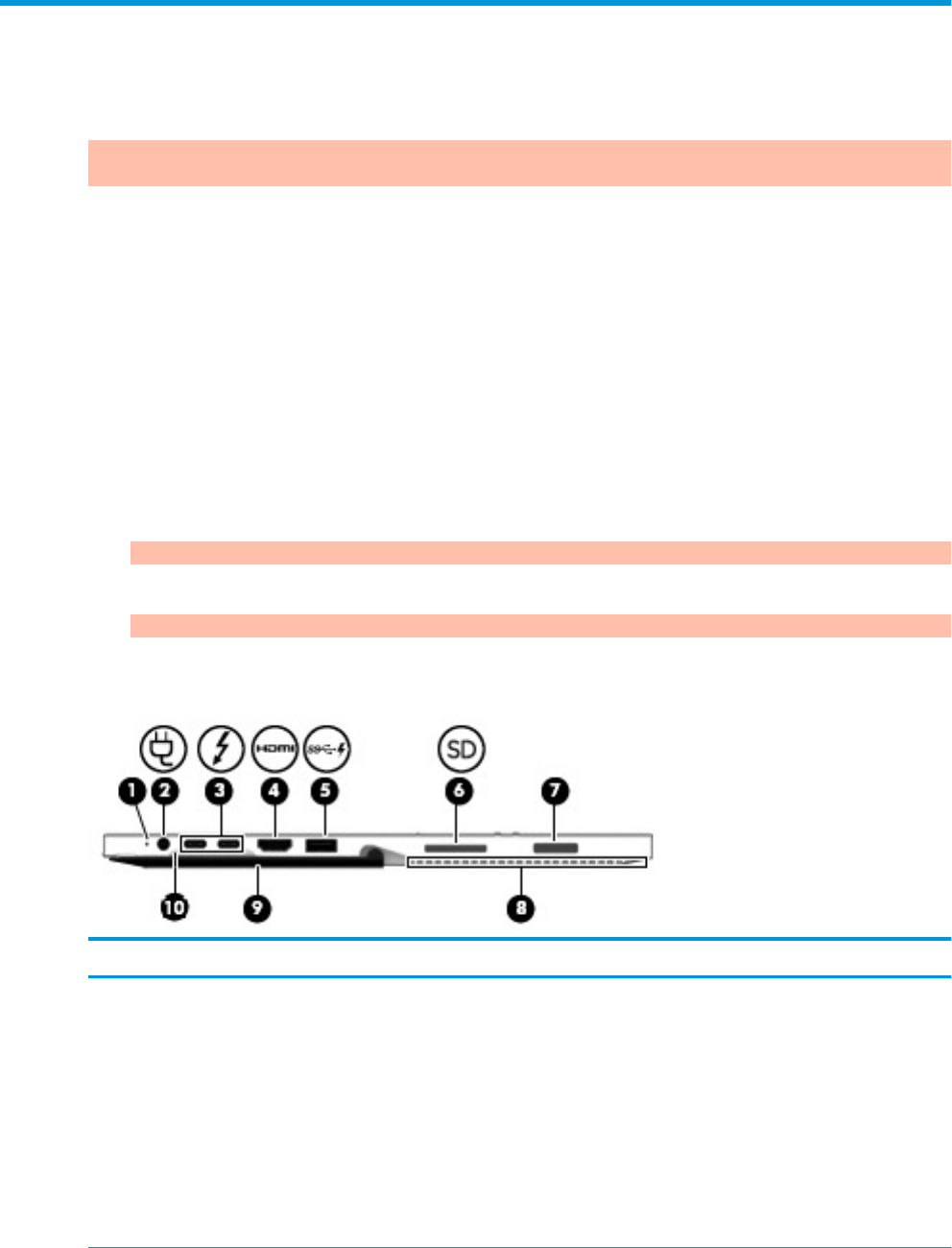
2 Components
Your computer features top-rated components. This chapter provides details about your components, where
they're located, and how they work.
Locating hardware
To nd out what hardware is installed on your computer:
▲Type device manager in the taskbar search box, and then select the Device Manager app.
A list displays all the devices installed on your computer.
For information about system hardware components and the system BIOS version number, press fn+esc
(select products only).
Locating software
To nd out what software is installed on your computer:
▲Select the Start button.
‒ or –
Right-click the Start button, and then select Apps and Features.
Right
Component Description
(1) Battery light When AC power is connected:
●White: The battery charge is greater than 90 percent.
●Amber: The battery charge is from 0 to 90 percent.
●O: The battery is not charging.
When AC power is disconnected (battery not charging):
●Blinking amber: The battery has reached a low battery
level. When the battery has reached a critical battery level,
the battery light begins blinking rapidly.
●O: The battery is not charging.
4 Chapter 2 Components
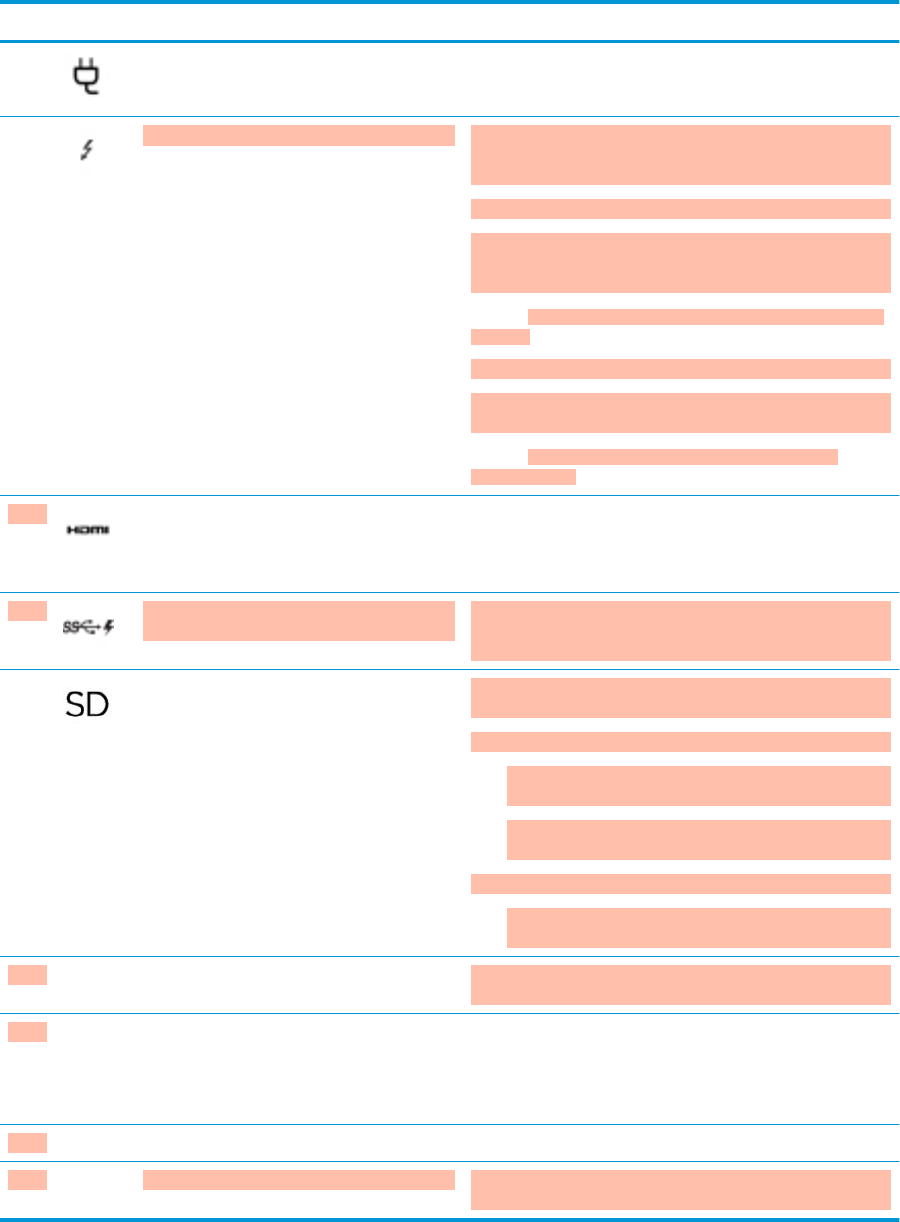
Component Description
(2) Power connector Connects an AC adapter.
(3) USB Type-C ThunderboltTM ports (2) Connect an AC adapter that has a USB Type-C connector,
supplying power to the computer and, if needed, charging the
computer battery.
– and –
Connect and charge most USB devices that have a Type-C
connector, such as a cell phone, camera, activity tracker, or
smartwatch, and provides high-speed data transfer.
NOTE: Cables and/or adapters (purchased separately) may be
required.
– and –
Connect a display device that has a USB Type-C connector,
providing DisplayPort output.
NOTE: Your computer may also support a Thunderbolt
docking station.
(4) HDMI port Connects an optional video or audio device, such as a high-
denition television, any compatible digital or audio
component, or a high-speed High Denition Multimedia
Interface (HDMI) device.
(5) USB 3.x SuperSpeed port with HP Sleep and
Charge
Connects a USB device, provides high-speed data transfer, and
even when the computer is o, charges most products such as a
cell phone, camera, activity tracker, or smartwatch.
(6) Memory card reader Reads optional memory cards that store, manage, share, or
access information.
To insert a card:
1. Hold the card label-side up, with the connectors facing the
computer.
2. Insert the card into the memory card reader, and then
press in on the card until it is rmly seated.
To remove a card:
▲Press in on the card, and then remove it from the memory
card reader.
(7) Fingerprint reader (select products only) Allows a ngerprint logon to Windows®, instead of a password
logon.
(8) Vents Enable airow to cool internal components.
NOTE: The computer fan starts up automatically to cool
internal components and prevent overheating. It is normal for
the internal fan to cycle on and o during routine operation.
(9) Kickstand Provides stability and a variety of viewing angles.
(10) Kickstand access tab Provides access to lift the kickstand away from the back of the
computer.
Right 5
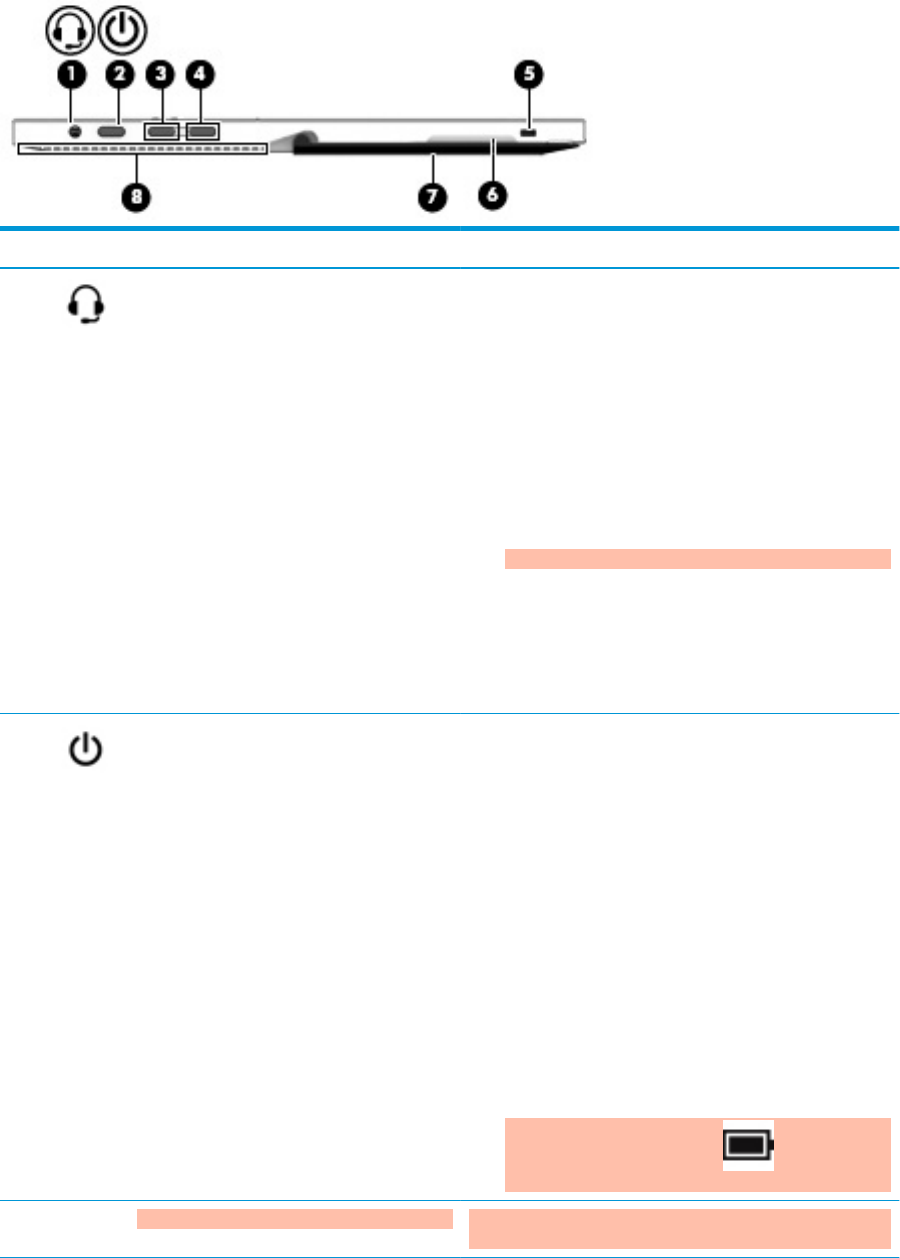
Left
Component Description
(1) Audio-out (headphone)/Audio-in (microphone)
combo jack
Connects optional powered stereo speakers, headphones,
earbuds, a headset, or a television audio cable. Also connects an
optional headset microphone. This jack does not support
optional standalone microphones.
WARNING! To reduce the risk of personal injury, adjust the
volume before putting on headphones, earbuds, or a headset.
For additional safety information, refer to the Regulatory,
Safety, and Environmental Notices.
To access this guide:
1. Type support in the taskbar search box, and then select
the HP Support Assistant app.
‒ or –
Click the question mark icon in the taskbar.
2. Select My PC, select the Specications tab, and then
select User Guides.
NOTE: When a device is connected to the jack, the computer
speakers are disabled.
(2) Power button ●When the computer is o, press the button to turn on the
computer.
●When the computer is on, press the button briey to
initiate Sleep.
●When the computer is in the Sleep state, press the button
briey to exit Sleep.
●When the computer is in Hibernation, press the button
briey to exit Hibernation.
CAUTION: Pressing and holding down the power button results
in the loss of unsaved information.
If the computer has stopped responding and shutdown
procedures are ineective, press and hold the power button for
at least 5 seconds to turn o the computer.
To learn more about your power settings, see your power
options.
▲
Right-click the Power meter icon and then select
Power Options.
(3) Volume up button Increases speaker volume incrementally while you hold down
the button.
6 Chapter 2 Components
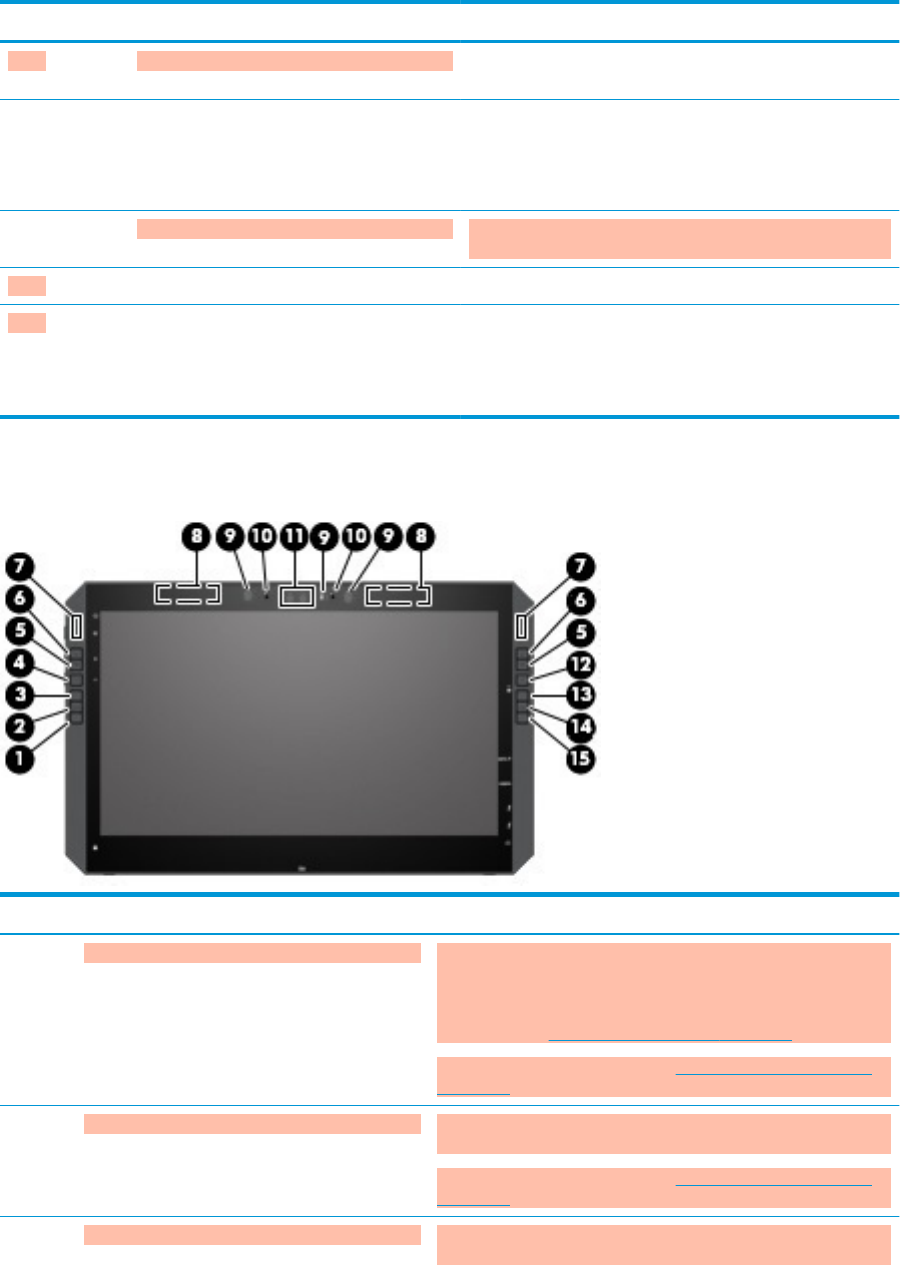
Component Description
(4) Volume down button Decreases speaker volume incrementally while you hold down
the key.
(5) Security cable slot Attaches an optional security cable to the computer.
NOTE: The security cable is designed to act as a deterrent, but
it may not prevent the computer from being mishandled or
stolen.
(6) Kickstand access tab Provides access to lift the kickstand away from the back of the
computer.
(7) Kickstand Provides stability and a variety of viewing angles.
(8) Vents Enable airow to cool internal components.
NOTE: The computer fan starts up automatically to cool
internal components and prevent overheating. It is normal for
the internal fan to cycle on and o during routine operation.
Front
Component Description
(1) Quick Key programmable button Press the button for a programmed action. The default action is
Button Info, which displays the interactive Virtual Desktop overlay
for the programmable buttons and optional pen. The overlay
displays what function each button is mapped to perform. For more
information, see Viewing button mappings on page 40.
To program the button settings, see HP ZBook x2 Control software
on page 34.
(2) Quick Key programmable button Press the button for a programmed action. The default action is
Undo.
To program the button settings, see HP ZBook x2 Control software
on page 34.
(3) Quick Key programmable button Press the button for a programmed action. The default action is
Touch On/O, which toggles the touch option on or o.
Front 7

Component Description
To program the button settings, see HP ZBook x2 Control software
on page 34.
(4) Left Quick Key Mode select button Press the button to cycle through the three Mode options for the
Quick Key Mode change buttons. The Quick Key Mode lights display
which of the three Modes are active.
The default setting controls only the left buttons. The left and right
can be changed to mirror selections; see HP ZBook x2 Control
software on page 34.
This button also works like a mouse click; use it to make a selection.
(5) Quick Key Mode change down button Press the button to execute the Mode action. There are three actions,
which depend on the Mode selected. Use the Quick Key Mode select
button to choose the mode. The Quick Key Mode lights show which
Mode is active. The default actions are:
●Switch the Virtual Desktop left
●Snap the current window left
●Display File Explorer
To program the Mode settings, see HP ZBook x2 Control software
on page 34.
(6) Quick Key Mode change mode up button Press the button to execute the Mode action. There are three actions,
which depend on the Mode selected. Use the Quick Key Mode select
button to choose the mode. The Quick Key Mode lights show which
Mode is active. The default actions are:
●Switch the Virtual Desktop right
●Snap the current window right
●Display Desktop
To program the Mode settings, see HP ZBook x2 Control software
on page 34.
(7) Quick Key Mode lights On: The Mode is in use. In the default setting, the left Mode light
displays when the left Quick Key Mode select button is used, and the
right mode light displays when the right Quick Key Mode select
button is used. The lights cycle to the next light each time the button
is pressed, which corresponds to the function the Quick Key Mode
button is set to perform.
(8) WLAN antennas* Send and receive wireless signals to communicate with wireless local
area networks (WLANs).
(9) Camera lights (select products only) On: One or more cameras are in use.
(10) Internal microphones Record sound.
(11) Cameras (select products only) Allow you to video chat, record video, and record still images. To use
your camera, see Using a camera (select products only) on page 44.
Some cameras also allow a facial recognition logon to Windows,
instead of a password logon. For more information, see Using
Windows Hello (select products only) on page 63.
NOTE: Camera functions vary depending on the camera hardware
and software installed on your product.
(12) Right Quick Key Mode select button Press the button to cycle through the three Mode options for the
Quick Key Mode change buttons. The Quick Key Mode lights display
which of the three Modes are active.
8 Chapter 2 Components
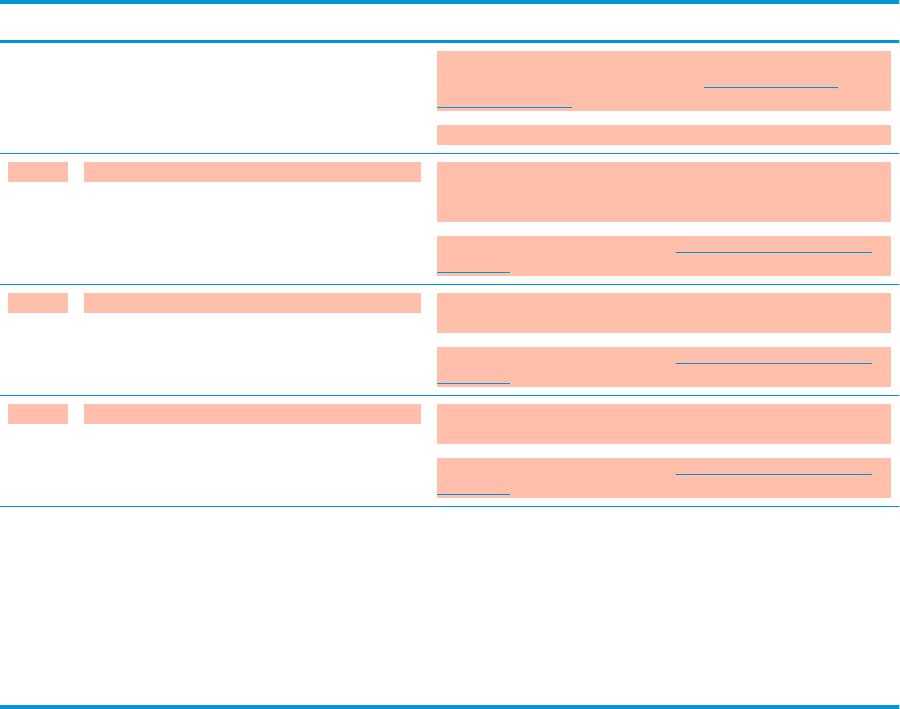
Component Description
The default setting controls only the right buttons. The left and right
can be changed to mirror selections; see HP ZBook x2 Control
software on page 34.
This button also works like a mouse click; use it to make a selection.
(13) Quick Key programmable button Press the button to execute the programmed action. The default
action is Screen Rotation Lock, which toggles screen rotation on or
o.
To program the button settings, see HP ZBook x2 Control software
on page 34.
(14) Quick Key programmable button Press the button to execute the programmed action. The default is
Action Center, which displays the Windows Action Center.
To program the button settings, see HP ZBook x2 Control software
on page 34.
(15) Quick Key programmable button Press the button to execute the programmed action. The default
action is Cortana Voice, which starts the Windows personal assistant.
To program the button settings, see HP ZBook x2 Control software
on page 34.
*The antennas are not visible from the outside of the computer, and antenna location varies. For optimal transmission, keep the areas
immediately around the antennas free from obstructions.
For wireless regulatory notices, see the section of the Regulatory, Safety, and Environmental Notices that applies to your country or
region.
To access this guide:
▲Select the Start button, select All apps (required on some products), select HP Help and Support, and then select HP
Documentation.
Front 9
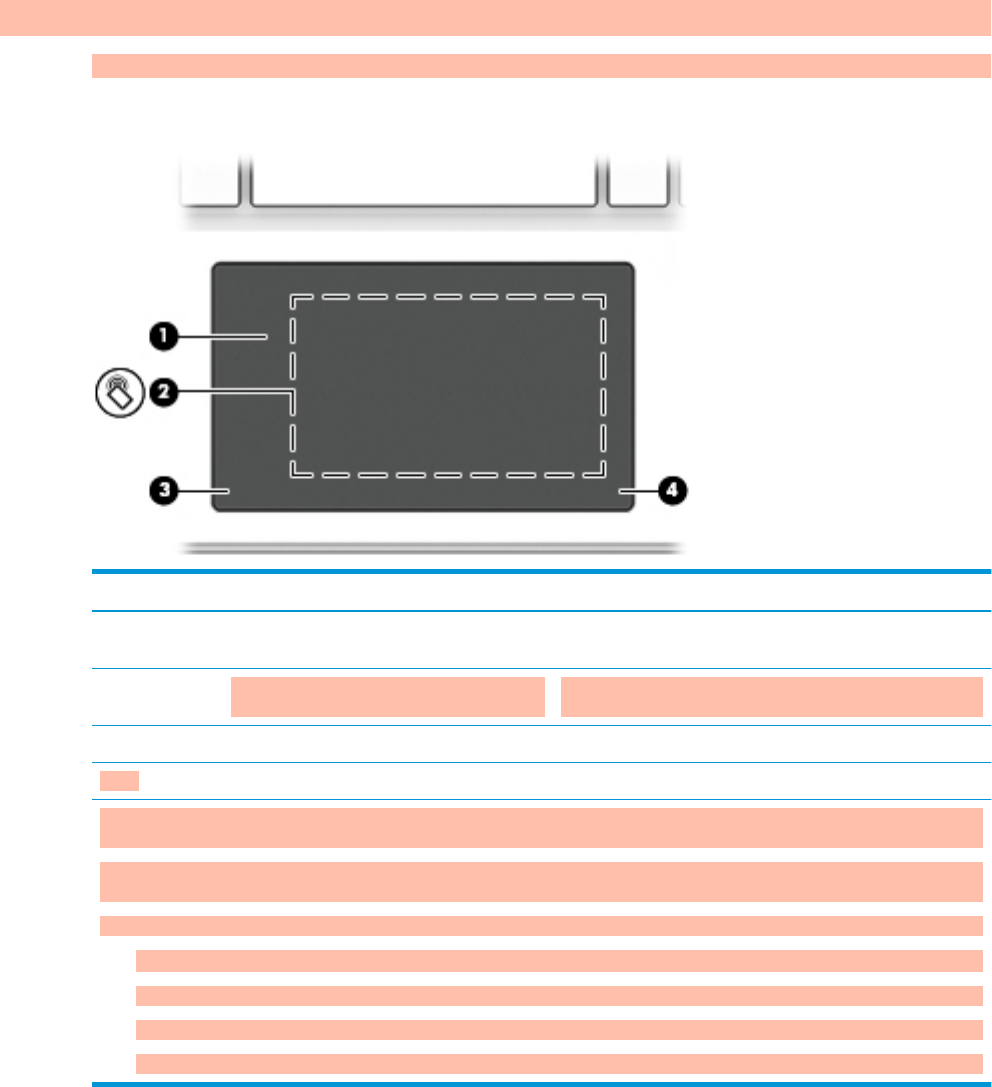
Keyboard base components
Your tablet supports a keyboard. This section provides information about the features of the keyboard.
TouchPad
Component Description
(1) TouchPad zone Reads your nger gestures to move the pointer or activate items
on the screen.
(2) Near Field Communications (NFC) tapping area
and antenna*
Allows you to wirelessly share information when you tap it with
an NFC-enabled device.
(3) Left TouchPad click area Functions like the left button on an external mouse.
(4) Right TouchPad click area Functions like the right button on an external mouse.
*The antenna is not visible from the outside of the computer. For optimal transmission, keep the area immediately around the antenna
free from obstructions.
For wireless regulatory notices, see the section of the Regulatory, Safety, and Environmental Notices that applies to your country or
region.
To access this guide:
1. Type support in the taskbar search box, and then select the HP Support Assistant app.
‒ or –
Click the question mark icon in the taskbar.
2. Select My PC, select the Specications tab, and then select User Guides.
10 Chapter 2 Components
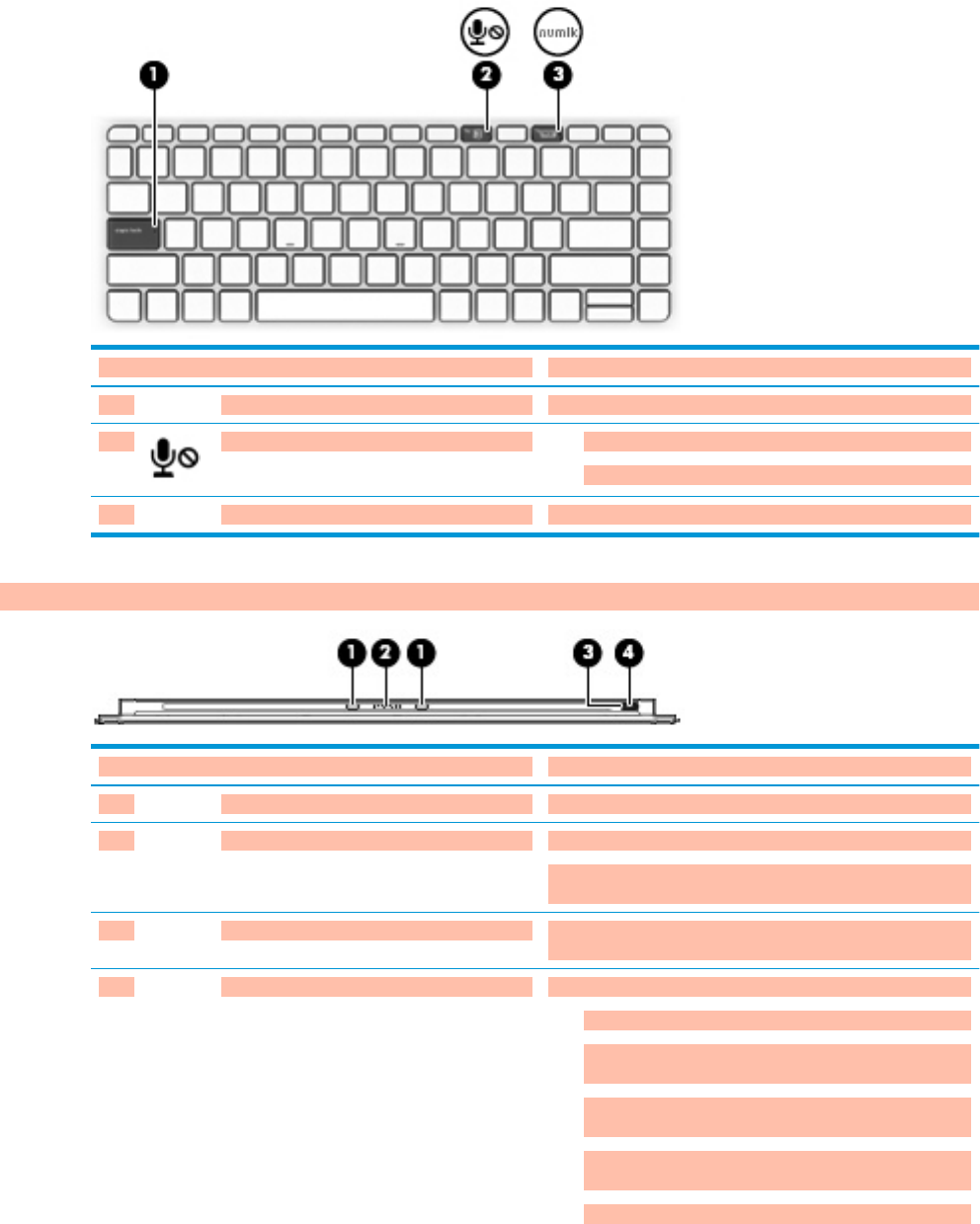
Lights
Component Description
(1) Caps lock light On: Caps lock is on, which switches the keys to all capital letters.
(2) Microphone mute light ●Amber: Microphone sound is o.
●O: Microphone sound is on.
(3) Num lock light On: Num lock is on.
Keyboard connectors, button, and status light
Component Description
(1) Alignment posts (2) Connect to the alignment connectors on the tablet.
(2) Docking connector Connects the keyboard to the tablet.
The keyboard battery charges automatically when it is connected
to the tablet using this connector.
(3) Keyboard button Turns the keyboard on or o. The button is also used for manual
Bluetooth® pairing.
(4) Keyboard status light When AC power is connected:
●Red: The keyboard battery charge is less than 10 percent.
●White: The keyboard battery is charging using the micro-
USB port, and the battery charge is from 10 to 99 percent.
●Blue: The keyboard is connected to the tablet using
Bluetooth, and the battery charge is 100 percent.
●Blinking blue: The keyboard is pairing using Bluetooth, and
the battery charge is 100 percent.
●O: The keyboard is o.
Keyboard base components 11

Component Description
When AC power is disconnected (the battery is not charging):
●Red: The keyboard battery charge is less than 10 percent.
●Blinking red: The keyboard battery charge is less than 5
percent.
●Blue: The keyboard is connected to the tablet using
Bluetooth, and the keyboard battery charge is from 10 to
100 percent.
●Blinking blue: The keyboard is pairing using Bluetooth, and
the keyboard battery charge is from 10 to 100 percent.
●O: The keyboard is o.
NOTE: If the keyboard does not have enough power to start
when the keyboard button is pressed, the light will blink red
several times and then turn o.
12 Chapter 2 Components
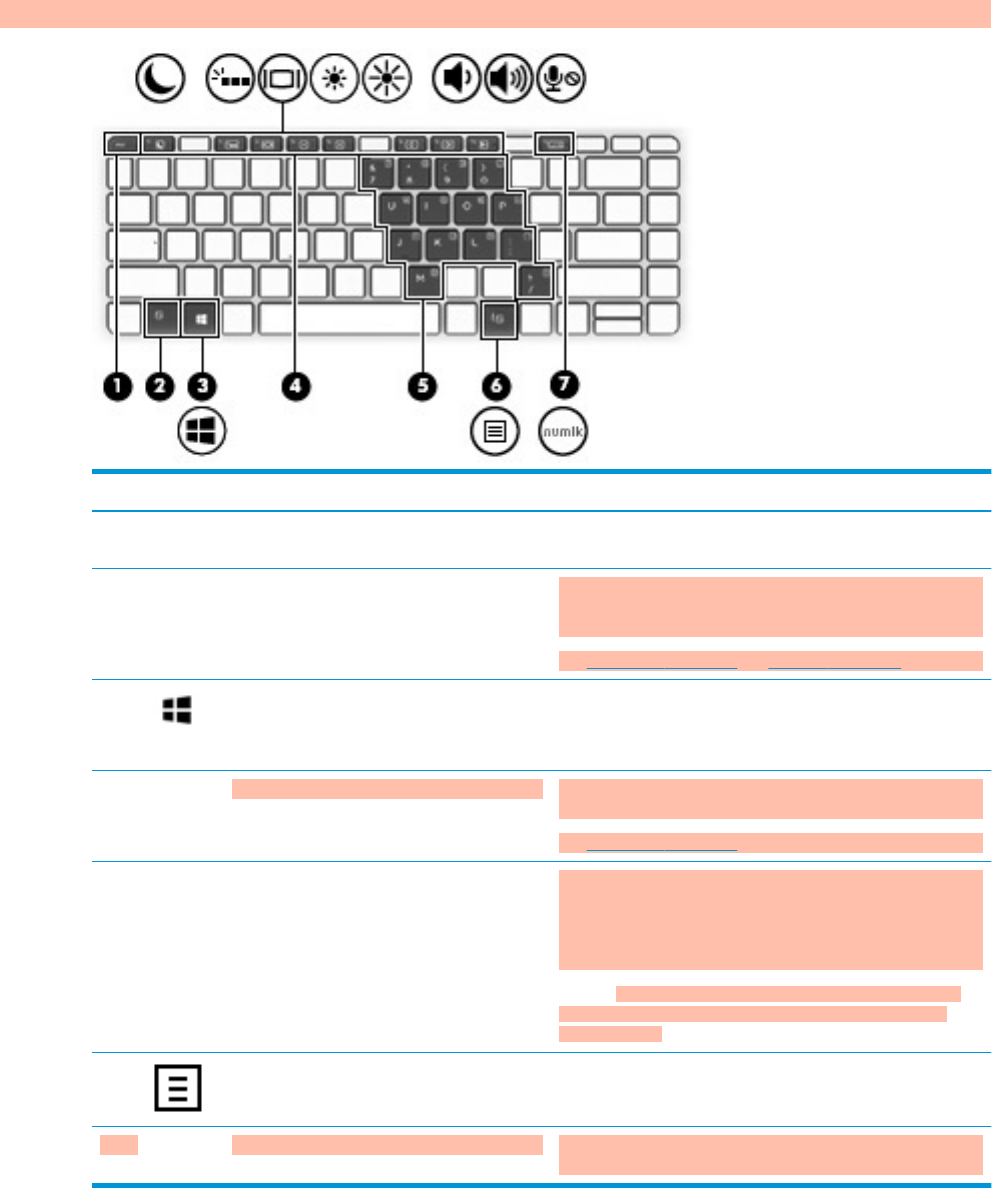
Special keys
Component Description
(1) esc key Displays system information when pressed in combination with
the fn key.
(2) fn key Executes frequently used system functions when pressed in
combination with another key. Such key combinations are called
action keys and hot keys.
See Action keys on page 14 and Hot keys on page 15.
(3) Windows key Opens the Start menu.
NOTE: Pressing the Windows key again will close the Start
menu.
(4) Action keys Execute frequently used system functions, when pressed in
combination with the fn key.
See Action keys on page 14.
(5) Embedded numeric keypad A numeric keypad superimposed over the keyboard alphabet
keys. When fn+num lk is pressed, the keypad can be used like an
external numeric keypad. Each key on the keypad performs the
function indicated by the icon in the upper-right corner of the
key.
NOTE: If the keypad function is active when the computer is
turned o, that function is reinstated when the computer is
turned back on.
(6) Windows application key Displays options for a selected object.
(7) num lk key Turns the embedded numeric keypad on and o when pressed in
combination with the fn key.
Keyboard base components 13

Action keys
An action key performs the function indicated by the icon on the key. To determine which keys are on your
product, see Special keys on page 13.
▲To use an action key, press and hold the fn key and then press the action key.
Icon Description
Initiates Sleep, which saves your information in system memory. The display and other system components
turn o and power is conserved. To exit Sleep, briey press the power button.
CAUTION: To reduce the risk of information loss, save your work before initiating Sleep.
Turns the keyboard backlight o, on high, or on low.
NOTE: To conserve battery power, turn o this feature.
Switches the screen image among display devices connected to the system. For example, if a monitor is
connected to the computer, repeatedly pressing the key alternates the screen image from computer display
to monitor display to simultaneous display on both the computer and monitor.
Decreases the screen brightness incrementally as long as you hold down the key.
Increases the screen brightness incrementally as long as you hold down the key.
Decreases speaker volume incrementally while you hold down the key.
Increases speaker volume incrementally while you hold down the key.
Mutes the microphone.
14 Chapter 2 Components
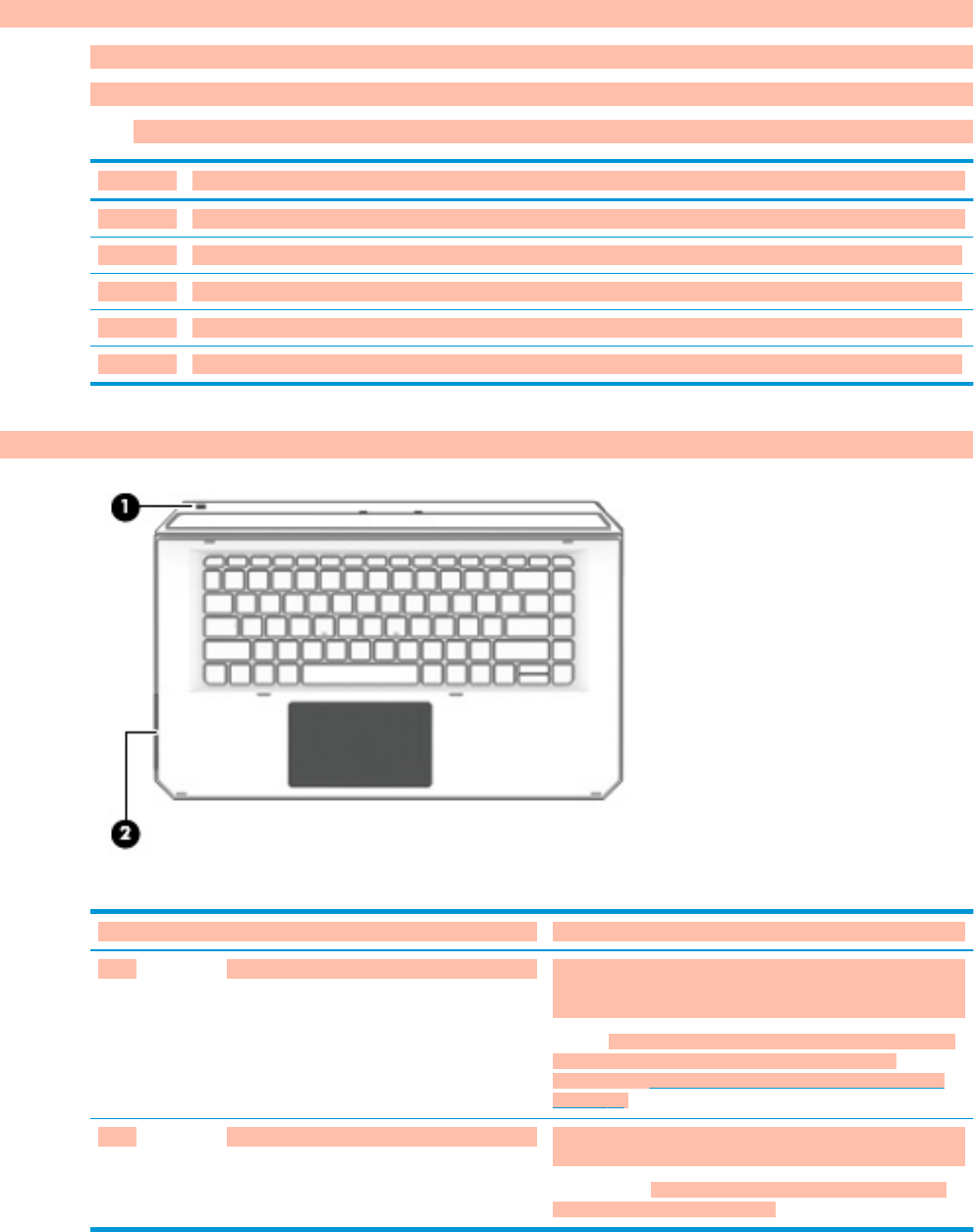
Hot keys
A hot key is the combination of the fn key and another key.
To use a hot key:
▲Press and hold the fn key, and then press one of the keys listed in the following table.
Key Description
C Turns on scroll lock.
E Turns on the insert function.
R Breaks the operation.
S Sends a programing query.
W Pauses the operation.
USB port and smart card reader/pen holder slot (select products only)
Component Description
(1) Micro USB port Connects a micro USB cable (purchased separately), that can be
used to supply power to the keyboard and, if needed, charge the
keyboard battery.
NOTE: The keyboard battery charges automatically when the
keyboard is connected to the tablet using the docking
connector. See Keyboard connectors, button, and status light
on page 11.
(2) Smart card reader/pen holder slot Supports optional smart cards or provides a slot for the pen
holder insert.
IMPORTANT: The keyboard must be connected to the tablet
for the smart card feature to work.
Keyboard base components 15
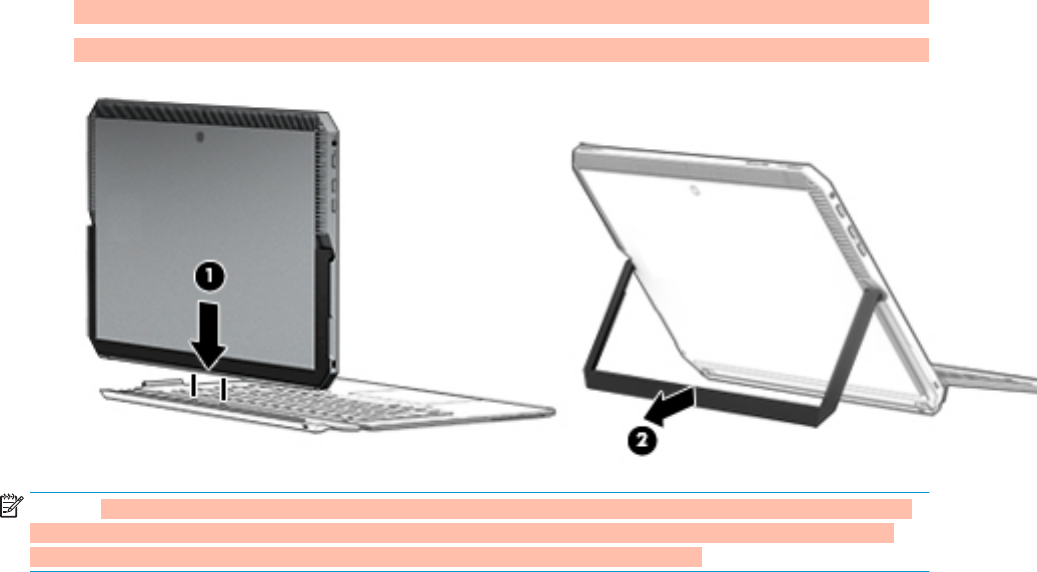
Connecting the tablet to the keyboard base
To connect the tablet to the keyboard base, follow these steps:
1. Lower the tablet (1) onto the alignment posts on the keyboard base.
2. Position the kickstand (2) at the desired angle.
NOTE: If you close the kickstand, you can leave the keyboard attached and rotate the keyboard so that the
back of the keyboard rests against the back of the behind the tablet. The keyboard keys and TouchPad are
locked to prevent you from accidently typing while the keyboard is in this position.
16 Chapter 2 Components
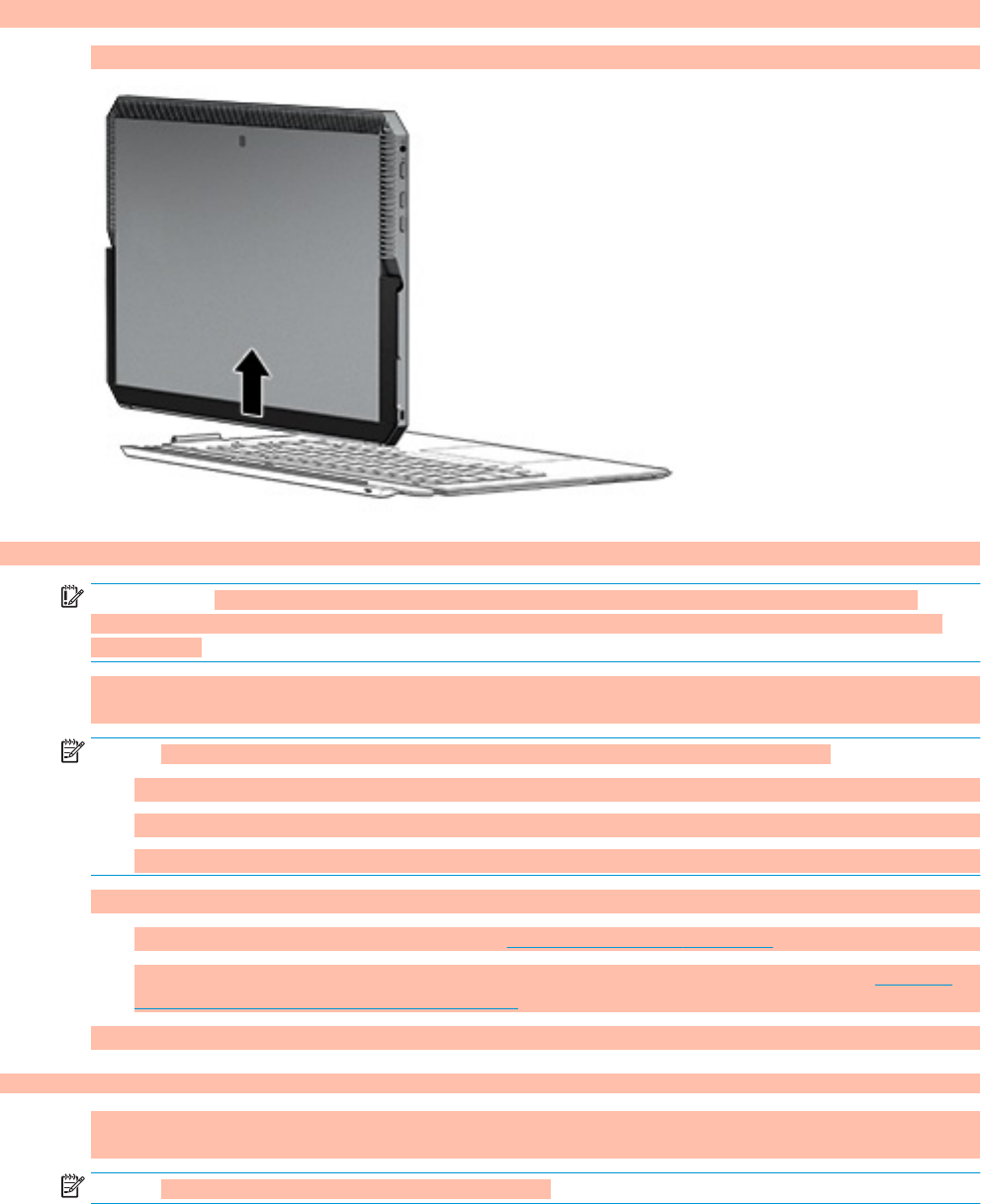
Removing the tablet from the keyboard base
To remove the tablet from the keyboard, pull the tablet away from the keyboard.
Using the keyboard wirelessly
IMPORTANT: The keyboard ships connected to the tablet. During the initial startup, the software will
prompt you to pair the keyboard with the tablet. Refer to the Setup Instructions for information about the
initial pairing.
After your keyboard is paired to the tablet, you can use the keyboard when it is not connected to the tablet.
Using the keyboard wirelessly expands your options for use.
NOTE: The keyboard must be connected to the tablet when you are using these functions:
●Computer Setup, or Basic Input/Output System (BIOS)
●HP PC Hardware Diagnostics
●Back up, restore, and recovery
If the keyboard cannot communicate with the tablet, conrm the following:
●The tablet Bluetooth setting is turned on. See Network connections on page 23.
●The keyboard Bluetooth setting is turned on. The keyboard button light should be blue. See Keyboard
connectors, button, and status light on page 11.
If needed, set the Bluetooth pairing again.
Setting the Bluetooth pairing automatically
If the keyboard cannot communicate with the tablet, follow these steps to automatically set the Bluetooth
pairing:
NOTE: The tablet Bluetooth feature must be turned on.
Keyboard base components 17

1. Attach the keyboard to the tablet.
The Keyboard Pairing Request screen appears.
2. Follow the screen instructions to pair the keyboard to the tablet.
Setting the Bluetooth pairing manually
If the keyboard cannot communicate with the tablet and automatic pairing fails, follow these steps to
manually set the Bluetooth pairing:
1. Remove the keyboard from the tablet.
2. Type blue in the taskbar search box, and then select Bluetooth and other device settings.
3. Turn on Bluetooth, if it is not already turned on.
4. Press the keyboard button for more that 3 seconds. The blue light should begin to blink. For the button
and light location, see Keyboard connectors, button, and status light on page 11.
5. Select Add Bluetooth or other device.
6. Select HP Zbook x2 Bluetooth Keyboard.
7. Select Pair.
A passcode displays on the tablet screen.
8. Type the passcode on the keyboard and press Enter.
The installation continues and the keyboard is connected.
18 Chapter 2 Components
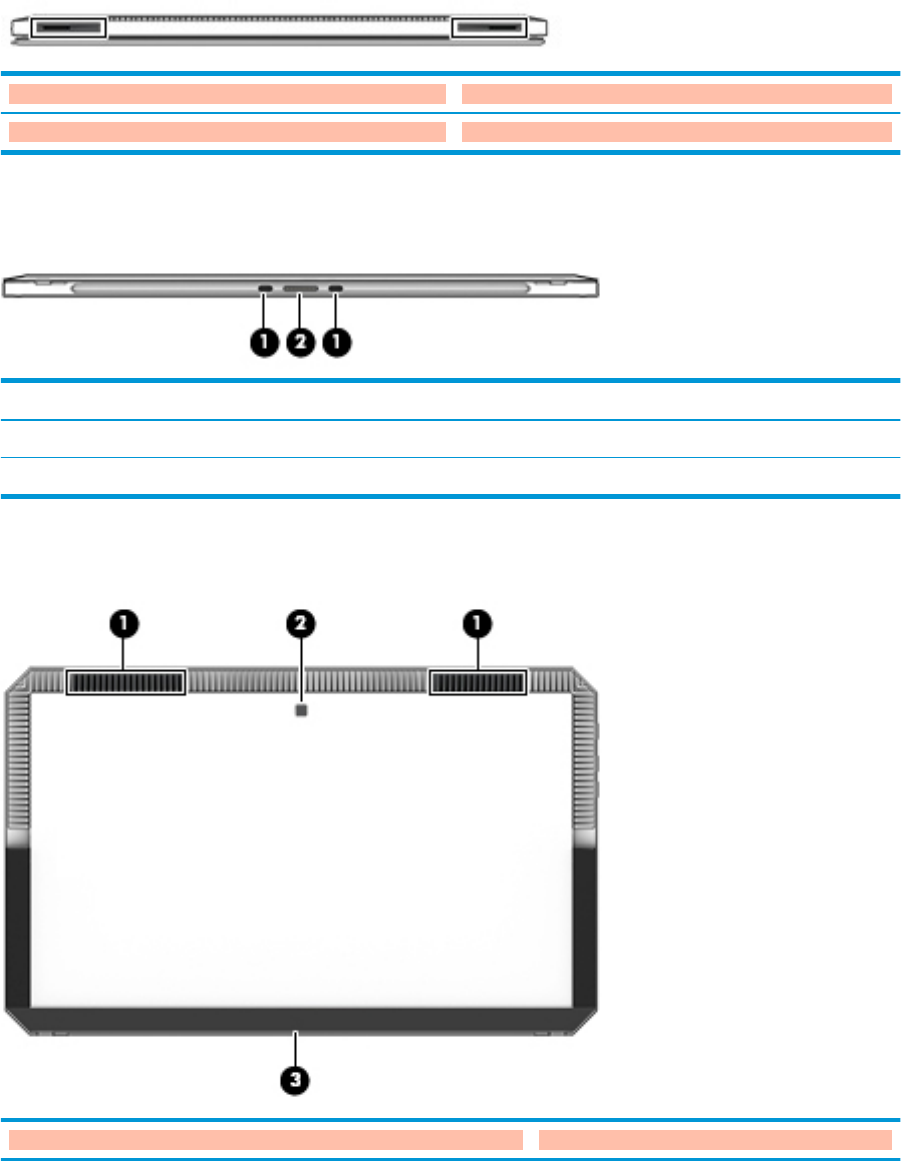
Top
Component Description
Speakers Produce sound.
Bottom
Component Description
(1) Alignment post connectors (2) Connect to the alignment posts on the keyboard.
(2) Docking connector Connects the tablet to the keyboard.
Rear
Component Description
(1) Vents Enable airow to cool internal components.
Top 19
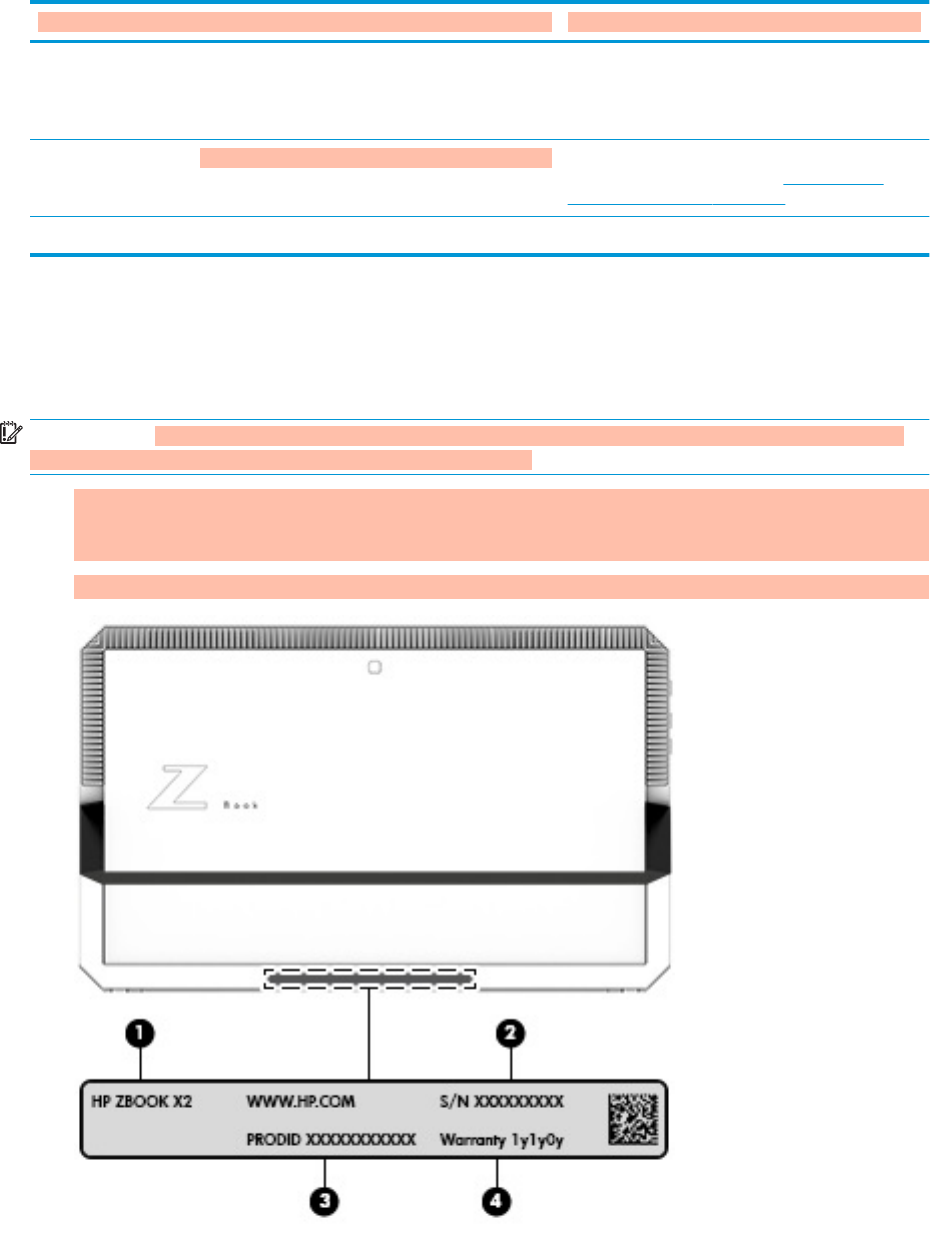
Component Description
NOTE: The computer fan starts up automatically to
cool internal components and prevent overheating. It
is normal for the internal fan to cycle on and o
during routine operation.
(2) Rear camera (select products only) Allows you to video chat, record video, and record still
images. To use your camera, see Using a camera
(select products only) on page 44.
(3) Kickstand Provides stability and a variety of viewing angles.
Labels
The labels axed to the computer provide information you may need when you troubleshoot system
problems or travel internationally with the computer.
IMPORTANT: Check the following locations for the labels described in this section: the back of the display
under the kickstand and the connection area of the keyboard.
●Service label—Provides important information to identify your computer and the keyboard. When
contacting support, you will probably be asked for the serial number, and possibly for the product
number or the model number. Locate these numbers before you contact support.
Your service label will resemble the examples shown below.
20 Chapter 2 Components
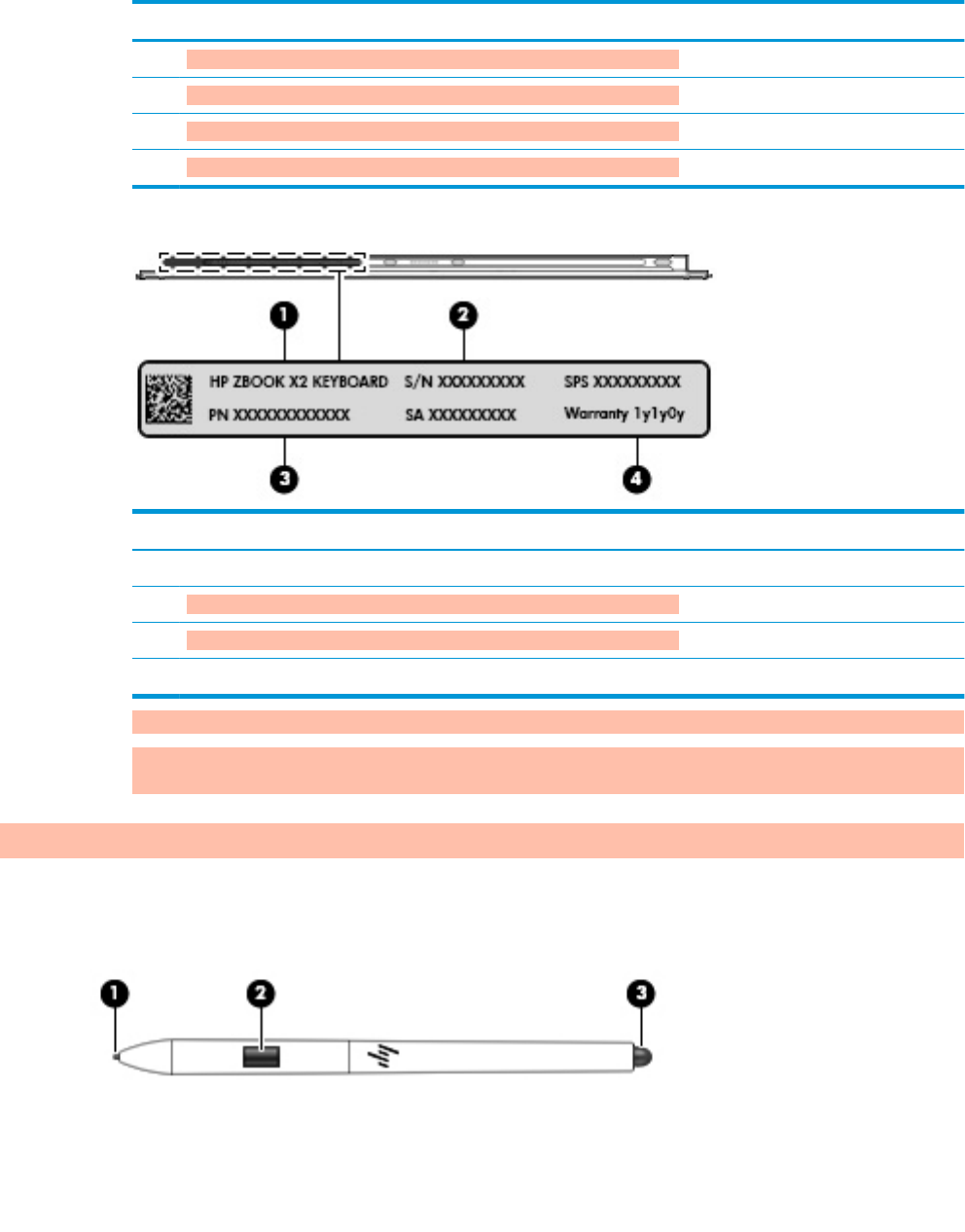
Component
(1) Model name (select products only)
(2) Serial number
(3) Product number
(4) Warranty period
Component
(1) Model name (select products only)
(2) Serial number
(3) Product number
(4) Warranty period
●Regulatory label(s)—Provide(s) regulatory information about the computer.
●Wireless certication label(s)—Provide(s) information about optional wireless devices and the approval
markings for the countries or regions in which the devices have been approved for use.
Optional pen
Optional pen 21
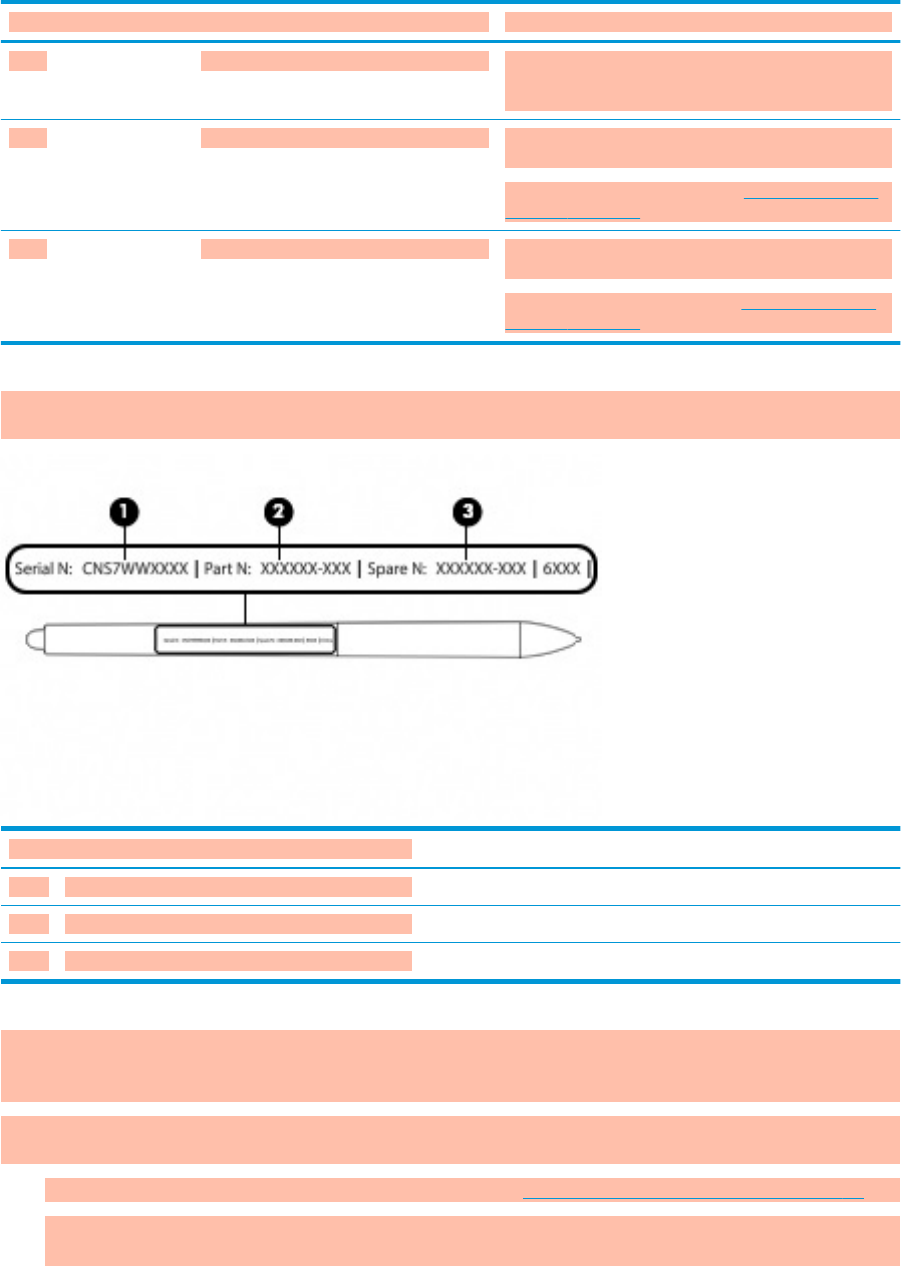
Component Description
(1) Tip/removable nib Draws on the screen. Increased pressure applied to the tip
results in wider or darker lines, depending on the software
app. The nib is removable.
(2) Button Provides additional functions for the pen, depending on
the software app.
To program the button settings, see HP ZBook x2 Control
software on page 34.
(3) Eraser Removes what is drawn on the screen, depending on the
software app.
To program the eraser settings, see HP ZBook x2 Control
software on page 34.
The labels axed to the pen provide information you may need when you troubleshoot problems or replace
the pen.
Component
(1) Serial number
(2) Part number
(3) Spare number
Hold the pen as you would a normal pen or pencil. Adjust your grip so that you can toggle the pen button
easily with your thumb or forenger. Be careful not to accidentally press the button while drawing or
positioning with the pen.
Software provided with your tablet oers the following methods for customizing your pen and button
settings:
●HP ZBook x2 Control software—For more information see HP ZBook x2 Control software on page 34.
●Windows Pen & Windows Ink software settings—To access this setting, type pen settings in the
taskbar search box, select Pen settings, and then select Pen & Windows Ink.
22 Chapter 2 Components

3 Network connections
Your computer can travel with you wherever you go. But even at home, you can explore the globe and access
information from millions of websites using your computer and a wired or wireless network connection. This
chapter will help you get connected to that world.
Connecting to a wireless network
Your computer may be equipped with one or more of the following wireless devices:
●WLAN device—Connects the computer to wireless local area networks (commonly referred to as Wi-Fi
networks, wireless LANs, or WLANs) in corporate oces, your home, and public places such as airports,
restaurants, coee shops, hotels, and universities. In a WLAN, the mobile wireless device in your
computer communicates with a wireless router or a wireless access point.
●HP Mobile Broadband Module (select products only)—A wireless wide area network (WWAN) device that
gives you wireless connectivity over a much larger area. Mobile network operators install base stations
(similar to cell phone towers) throughout large geographic areas, eectively providing coverage across
entire states, regions, or even countries.
●Bluetooth® device—Creates a personal area network (PAN) to connect to other Bluetooth-enabled
devices such as computers, phones, printers, headsets, speakers, and cameras. In a PAN, each device
communicates directly with other devices, and devices must be relatively close together—typically
within 10 meters (approximately 33 feet) of each other.
Using the wireless controls
You can control the wireless devices in your computer using one or more of these features:
●Wireless button (also called airplane mode key or wireless key) (referred to in this chapter as wireless
button)
●Operating system controls
Wireless button
The computer may have a wireless button, one or more wireless devices, and one or two wireless lights. All
the wireless devices on your computer are enabled at the factory.
The wireless light indicates the overall power state of your wireless devices, not the status of individual
devices.
Operating system controls
The Network and Sharing Center allows you to set up a connection or network, connect to a network, and
diagnose and repair network problems.
To use operating system controls:
1. Type control panel in the taskbar search box, and then select Control Panel.
2. Select Network and Internet, and then select Network and Sharing Center.
Connecting to a wireless network 23

Connecting to a WLAN
NOTE: When you are setting up Internet access in your home, you must establish an account with an
Internet service provider (ISP). To purchase Internet service and a modem, contact a local ISP. The ISP will help
set up the modem, install a network cable to connect your wireless router to the modem, and test the Internet
service.
To connect to a WLAN, follow these steps:
1. Be sure that the WLAN device is on.
2. Select the network status icon in the taskbar, and then connect to one of the available networks.
If the WLAN is a security-enabled WLAN, you are prompted to enter a security code. Enter the code, and
then select Next to complete the connection.
NOTE: If no WLANs are listed, you may be out of range of a wireless router or access point.
NOTE: If you do not see the WLAN you want to connect to, right-click the network status icon in the
taskbar, and then select Open Network and Sharing Center. Select Set up a new connection or
network. A list of options is displayed, allowing you to manually search for and connect to a network or
to create a new network connection.
3. Follow the on-screen instructions to complete the connection.
After the connection is made, select the network status icon at the far right of the taskbar, to verify the name
and status of the connection.
NOTE: The functional range (how far your wireless signals travel) depends on WLAN implementation, router
manufacturer, and interference from other electronic devices or structural barriers such as walls and oors.
Using HP Mobile Broadband (select products only)
Your HP Mobile Broadband computer has built-in support for mobile broadband service. Your new computer,
when used with a mobile operator’s network, gives you the freedom to connect to the Internet, send e-mail,
or connect to your corporate network without the need for Wi-Fi hotspots.
NOTE: If your computer includes HP Mobile Connect, the instructions in this section do not apply. See Using
HP Mobile Connect Pro (select products only) on page 25.
You might need the HP Mobile Broadband Module IMEI and/or MEID number to activate mobile broadband
service. The number may be printed on a label located on the bottom of your computer, inside the battery
bay, under the service door, or on the back of the display.
– or –
You can nd the number following these steps:
1. From the taskbar, select the network status icon.
2. Select View Connection Settings.
3. Under the Mobile broadband section, select the network status icon.
Some mobile network operators require the use of a SIM card. A SIM card contains basic information about
you, such as a personal identication number (PIN), as well as network information. Some computers include
a SIM card that is preinstalled. If the SIM card is not preinstalled, it may be provided in the HP Mobile
Broadband information provided with your computer or the mobile network operator may provide it
separately from the computer.
24 Chapter 3 Network connections

For information about HP Mobile Broadband and how to activate service with a preferred mobile network
operator, see the HP Mobile Broadband information included with your computer.
Using HP Mobile Connect Pro (select products only)
HP Mobile Connect Pro is a prepaid, mobile broadband service that provides a cost-eective, secure, simple,
and exible mobile broadband connection for your computer. To use HP Mobile Connect Pro, your computer
must have a SIM card and the HP Mobile Connect app. For more information about HP Mobile Connect Pro and
where it is available, go to http://www.hp.com/go/mobileconnect.
Using GPS (select products only)
Your computer may be equipped with a Global Positioning System (GPS) device. GPS satellites deliver location,
speed, and direction information to GPS-equipped systems.
To enable GPS, make sure location is enabled under the Windows privacy setting.
1. Type location in the taskbar search box, and then select Location privacy settings.
2. Follow the on-screen instructions for using location settings.
Using Bluetooth wireless devices (select products only)
A Bluetooth device provides short-range wireless communications that replace the physical cable connections
that traditionally link electronic devices such as the following:
●Computers (desktop, notebook)
●Phones (cellular, cordless, smartphone)
●Imaging devices (printer, camera)
●Audio devices (headset, speakers)
●Mouse
●External keyboard
Connecting Bluetooth devices
Before you can use a Bluetooth device, you must establish a Bluetooth connection.
1. Type bluetooth in the taskbar search box, and then select Bluetooth and other devices settings.
2. Turn on Bluetooth, if it is not already turned on.
3. Select your device from the list, and then follow the on-screen instructions.
NOTE: If the device requires verication, a pairing code is displayed. On the device you are adding, follow the
on-screen instructions to verify that the code on your device matches the pairing code. For more information,
refer to the documentation provided with the device.
NOTE: If your device does not appear in the list, be sure that Bluetooth on that device is turned on. Some
devices may have additional requirements; refer to the documentation provided with the device.
Using NFC to share information (select products only)
Your computer supports Near Field Communication (NFC), which allows you to wirelessly share information
between two NFC-enabled devices. Information is transferred by tapping the tapping area (antenna) of the
Connecting to a wireless network 25

computer with the antenna of your phone or other device. With NFC and supported apps, you can share
websites, transfer contact information, transfer payments, and print on NFC-enabled printers.
NOTE: To locate the tapping area on your computer, see Components on page 4.
Sharing
1. Conrm that the NFC function is enabled.
a. Type wireless in the taskbar search box, and then select Turn wireless devices on or o.
b. Conrm that the selection for NFC is On.
2. Tap the NFC tapping area with an NFC-enabled device. You may hear a sound when the devices connect.
NOTE: To nd the location of the antenna on the other NFC device, refer to your device instructions.
3. Follow any on-screen instructions to continue.
26 Chapter 3 Network connections
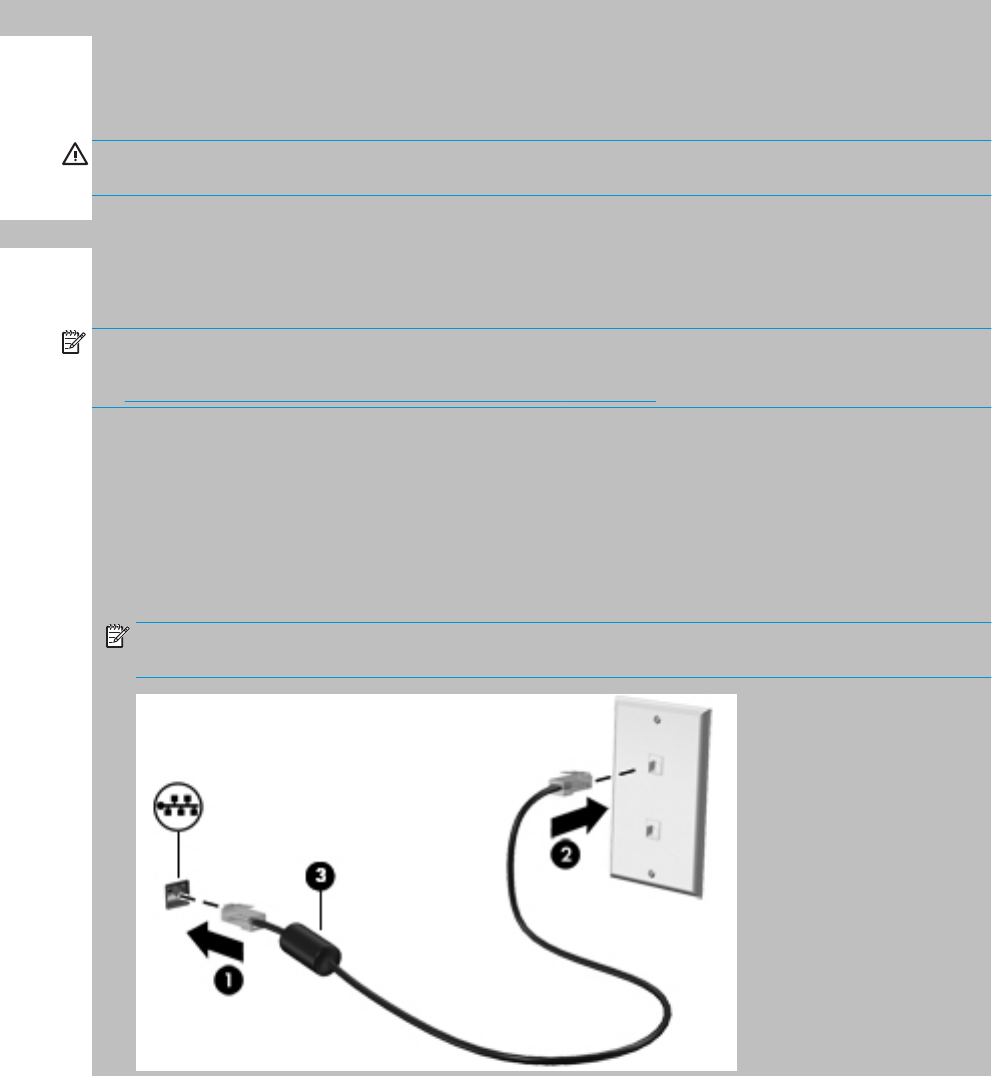
Connecting to a wired network
Select products may allow wired connections: local area network (LAN) and modem connection. A LAN
connection uses a network cable and is much faster than a modem, which uses a telephone cable. Both cables
are sold separately.
WARNING! To reduce the risk of electric shock, re, or damage to the equipment, do not plug a modem
cable or telephone cable into an RJ-45 (network) jack.
Connecting to a local area network (LAN) (select products only)
Use a LAN connection if you want to connect the computer directly to a router in your home (instead of
working wirelessly), or if you want to connect to an existing network at your oce.
NOTE: A feature called HP LAN-WLAN Protection may be enabled on your computer. It closes your wireless
(Wi-Fi) connection when you connect directly to a LAN. For more information about HP LAN-WLAN Protection,
see Using HP LAN-WLAN Protection (select products only) on page 28.
If there is no RJ-45 port on the computer, connecting to a LAN requires an 8-pin, RJ-45 network cable or an
optional docking device or expansion product.
To connect the network cable, follow these steps:
1. Plug the network cable into the network jack (1) on the computer or on an optional docking device or
expansion product.
2. Plug the other end of the network cable into a network wall jack (2) or router.
NOTE: If the network cable contains noise suppression circuitry (3), which prevents interference from
TV and radio reception, orient the circuitry end of the cable toward the computer.
Connecting to a wired network 27

Using HP LAN-WLAN Protection (select products only)
In a LAN environment, you can set HP LAN-WLAN Protection to safeguard your LAN network from
unauthorized wireless access. When HP LAN-WLAN Protection is enabled, the WLAN (Wi-Fi) connection is
turned o when the computer is connected directly to a LAN.
Turning on and customizing HP LAN-WLAN Protection
1. Connect a network cable to the network jack on the computer, or on an optional docking device or
expansion product.
2. Start Computer Setup (BIOS).
●Computers or tablets with keyboards:
▲Turn on or restart the computer, and when the HP logo appears, press f10 to enter Computer
Setup.
●Tablets without keyboards:
▲Turn on or restart the tablet, and then quickly hold down the volume down button until the
Startup menu is displayed. Tap f10 to enter Computer Setup.
3. Select Advanced, and then select Built-in Device Options.
4. Select the check box for LAN/WLAN Auto Switching to turn o WLAN connections when connected to a
LAN network.
5. To save your changes and exit Computer Setup, select the Save icon in the lower-right corner of the
screen, and then follow the on-screen instructions.
‒ or –
Select Main, select Save Changes and Exit, and then press enter.
Your changes go into eect when the computer restarts.
Using HP MAC Address Manager to identify your computer on a
network (select products only)
You can enable a system Media Access Control (MAC) address to provide a customizable way of identifying
your computer and its communications on networks. This system MAC address provides unique identication
even when your computer is connected through an external device, such as a docking station or external
wireless adapter. This address is disabled by default.
Turning on and customizing the system MAC address
1. Connect a network cable to the network jack on the computer, or on an optional docking device or
expansion product.
2. Start Computer Setup (BIOS).
●Computers or tablets with keyboards:
▲Turn on or restart the computer, and when the HP logo appears, press f10 to enter Computer
Setup.
●Tablets without keyboards:
▲Turn on or restart the tablet, and then quickly hold down the volume down button until the
Startup menu is displayed. Tap f10 to enter Computer Setup.
28 Chapter 3 Network connections

3. Select Advanced, and then select Host Based MAC Address.
4. In the box to the right of Host Based MAC Address, select either System to enable the host-based MAC
address or Custom to customize the address.
5. Make selections for boot order and devices supported.
6. If you selected Custom, select MAC ADDRESS, enter your customized system MAC address, and then
press enter to save the address.
7. To save your changes and exit Computer Setup, select the Save icon in the lower-right corner of the
screen, and then follow the on-screen instructions.
‒ or –
Select Main, select Save Changes and Exit, and then press enter.
Your changes go into eect when the computer restarts.
For additional documentation about HP MAC Address Manager and using system MAC addresses, go to
http://www.hp.com/support. Select Find your product, and then follow the on-screen instructions.
Using HP MAC Address Manager to identify your computer on a network (select products only) 29
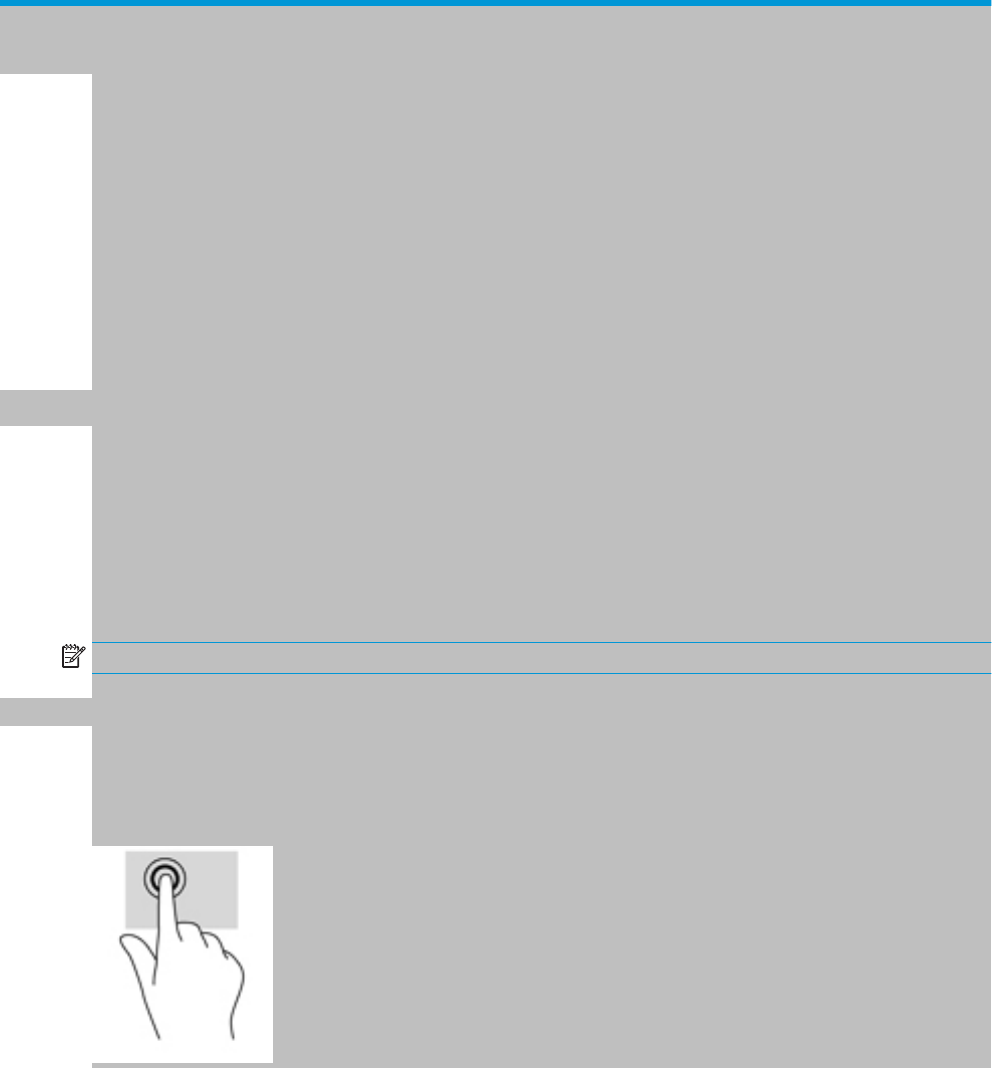
4 Navigating the screen
You can navigate the computer screen in one or more of the following ways:
●Use touch gestures directly on the computer screen
●Use touch gestures on the TouchPad
●Use an optional mouse or keyboard (purchased separately)
●Use an on-screen keyboard
●Use a pointing stick
Using TouchPad and touch screen gestures
The TouchPad helps you navigate the computer screen and control the pointer using simple touch gestures.
You can also use the left and right TouchPad buttons as you would use the corresponding buttons on an
external mouse. To navigate a touch screen (select products only), touch the screen directly using gestures
described in this chapter.
You can also customize gestures and view demonstrations of how they work. Type control panel in the
taskbar search box, select Control Panel, and then select Hardware and Sound. Under Devices and Printers,
select Mouse.
NOTE: Unless noted, gestures can be used on the TouchPad or a touch screen (select products only).
Tap
Use the tap/double-tap gesture to select or open an item on the screen.
●Point to an item on the screen, and then tap one nger on the TouchPad zone or touch screen to select
the item. Double-tap an item to open it.
30 Chapter 4 Navigating the screen

Two-nger pinch zoom
Use the two-nger pinch zoom to zoom out or in on images or text.
●Zoom out by placing two ngers apart on the TouchPad zone or touch screen and then moving your
ngers together.
●Zoom in by placing two ngers together on the TouchPad zone or touch screen and then moving your
ngers apart.
Two-nger slide (TouchPad only)
Use the two-nger slide to move up, down, or sideways on a page or image.
●Place two ngers slightly apart on the TouchPad zone and then drag them up, down, left, or right.
Two-nger tap (TouchPad only)
Use the two-nger tap to open the menu for an object on the screen.
NOTE: The two-nger tap performs the same function as right-clicking with the mouse.
●Tap two ngers on the TouchPad zone to open the options menu for the selected object.
Four-nger tap (TouchPad only)
Use the four-nger tap to open the action center.
Using TouchPad and touch screen gestures 31
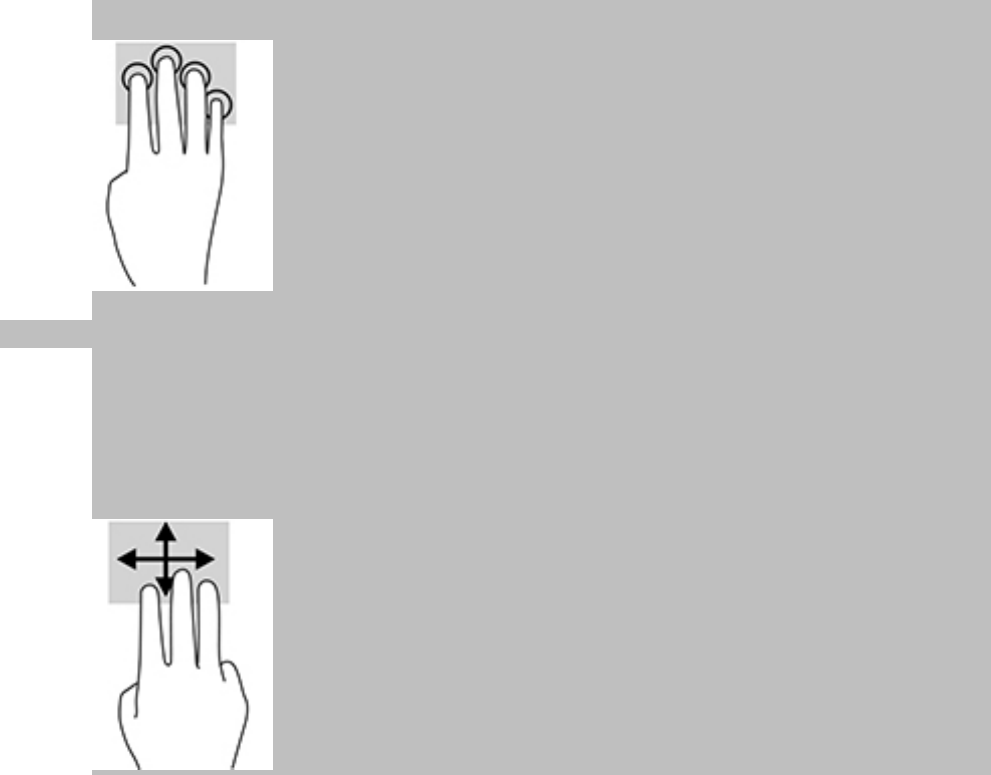
●Tap four ngers on the Touchpad to open the action center and view current settings and notications.
Three-nger swipe (TouchPad only)
Use the three-nger swipe to view open windows and to switch between open windows and the desktop.
●Swipe 3 ngers away from you to see all open windows.
●Swipe 3 ngers toward you to show the desktop.
●Swipe 3 ngers left or right to switch between open windows.
32 Chapter 4 Navigating the screen
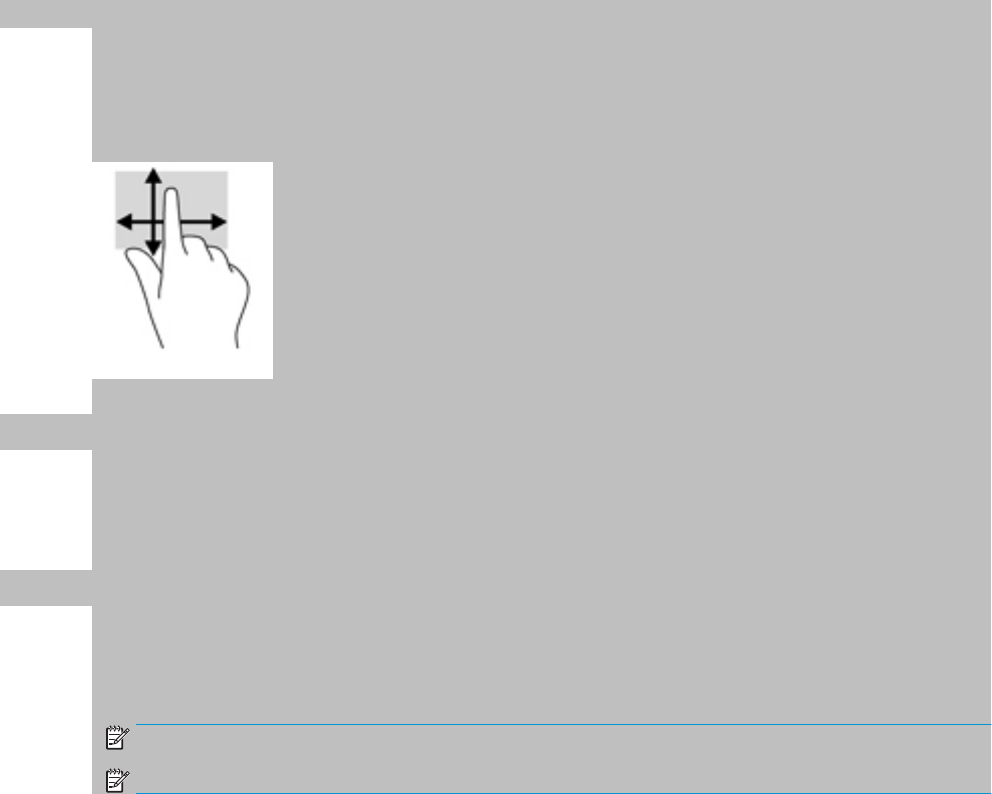
One-nger slide (touch screen only)
Use the one-nger slide to pan or scroll through lists and pages, or to move an object.
●To scroll across the screen, lightly slide one nger across the screen in the direction you want to move.
●To move an object, press and hold your nger on an object, and then drag your nger to move the object.
Using an optional keyboard or mouse
An optional keyboard or mouse allows you to type, select items, scroll, and perform the same functions as
you do using touch gestures. The keyboard also allows you to use action keys and hot keys to perform specic
functions.
Using an on-screen keyboard (select products only)
1. To display an on-screen keyboard, tap the keyboard icon in the notication area, at the far right of the
taskbar.
2. Begin typing.
NOTE: Suggested words may be displayed above the on-screen keyboard. Tap a word to select it.
NOTE: Action keys and hot keys do not display or function on the on-screen keyboard.
Using an optional keyboard or mouse 33

5 HP ZBook x2 Control software
Use HP ZBook x2 Control software to customize your tablet or tools. When you open the software, icons for
all connected computers and all tools that have been used on the tablet display in the Tool list. All settings
apply to the selected computer or pen.
Installing the HP ZBook x2 Control software
1. Select the Start button, and then select HP ZBook x2 Control to begin installation.
2. Follow the on-screen instructions.
After the installation is complete, the HP ZBook x2 Control app appears on the taskbar.
Starting the HP ZBook x2 Control software
▲Select HP ZBook x2 Control app to start the software.
The HP ZBook x2 Control software main panel displays.
Customizing tools
To customize your device, use the controls available on the tabs for Quick Keys, pen, and other features.
Changes will take eect immediately.
Programming the Quick Keys
You can program the Quick Keys to execute the functions that make your work quickest and easiest for you.
Your tablet has 18 Quick Key combinations when used with the three Modes. For the location of the Quick
Keys and Quick Keys Mode lights, see Front on page 7.
To program your Quick Keys:
1. Select the HP ZBook x2 Control app.
2. Select the device you are customizing in the Device section.
NOTE: If you have not added other devices, the default ZBook x2 Tablet is selected.
3. Select Functions in the Tool section.
4. Select All in the Application section to customize settings for all applications.
– or –
Select a specic application.
5. Select the HP Quick Keys tab.
6. Select the Mode you want to customize.
7. Select the down arrow next to the Quick Keys settings, for example next to Keystroke..., to display
program settings. Follow the on-screen instructions. For more information about possible entries, see
Button functions on page 36.
34 Chapter 5 HP ZBook x2 Control software

NOTE: If the Mirror left/right buttons checkbox is selected, the Quick Keys mirror the other side. The
side mirrored depends on how the Windows pen setting for right hand or left hand is set. For example, if
the Windows pen setting is for left hand, then the right side buttons are mirrored to the left side
settings. And if the Windows pen setting is for right hand, then the left side settings are mirrored to the
right side settings.
NOTE: Make sure one of the buttons is assigned to Button Info, so you can easily display the Virtual
Desktop overlay for the tablet and pen button mappings.
Customizing the optional pen
Customize settings for pen tip feel and pressure, eraser feel, side button, and application-specic pen
functions.
To customize your pen:
1. Select the HP ZBook x2 Control app.
2. Select the device you are customizing in the Device section.
NOTE: If you have not added other devices, the default ZBook x2 Tablet is selected.
3. Select Pro Pen in the Tool section.
4. Select All in the Application section to customize settings for all applications.
– or –
Select a specic application.
5. Select the HP Pen tab and choose from the available options.
6. Follow the on-screen instructions. For more information about possible entries, see Button functions
on page 36.
NOTE: The tip must be set to Click to draw in most graphics applications.
NOTE: The Tip Feel slider overrides the advanced pressure settings selected using the Customize
button.
Advanced customizing for the pen
To further customize tip or eraser pressure settings:
1. Select the Pen or Eraser tab.
2. Click on the Customize button.
Options within the Pen Feel Details dialog box let you independently change the tip or eraser pressure
sensitivity and click threshold settings.
3. Use the line on the left to adjust your pen settings. The pressure controls are displayed as symbols on
the line that can be moved to change the outcome.
●Click Threshold determines the amount of force required to register pressure or generate a pen
click.
●Sensitivity changes the slope of the pressure response curve.
●Max Pressure determines how hard you must press the pen tip to reach maximum pressure.
Customizing tools 35

4. Use the Try Here box to test the results of your changes.
5. Select OK to save your changes.
Customizing the eraser
To customize your eraser:
1. Select the HP ZBook x2 Control app.
2. Select the device you are customizing in Device section.
NOTE: If you have not added other devices, the default ZBook x2 Tablet is selected.
3. Select Pro Pen in the Tool section.
4. Select All in the Application section to customize settings for all applications.
– or –
Select a specic application.
5. Select the Eraser tab.
6. Follow the on-screen instructions. For more information about possible entries, see Button functions
on page 36.
NOTE: To determine pressure levels, position the screen cursor over an empty area of the control
panel, and then press down on the Current Pressure bar with the eraser.
NOTE: The Eraser Feel slider overrides the advanced pressure settings selected using the Customize
button.
Button functions
Use HP ZBook x2 Control software to customize the functions that are assigned to tool buttons, Quick Keys,
and other elements of your tablet. Note that button function options may vary.
●Clicks
–Click: Simulates a left mouse button click. Be sure at least one button performs this function so you
can always navigate and click.
–Right click: Simulates a right mouse button click to display a context menu.
–Middle click: Simulates a middle mouse button click.
–Double click: Simulates a double-click. For easier double-clicking, use this function instead of
tapping twice with the pen tip.
–Click lock: Simulates holding down the primary mouse button. Press the tool button once to initiate
click lock, and again to release it. Use Click lock to drag objects or select blocks of text.
–4th click or 5th click: Simulates a fourth or fth mouse button click.
●Keystroke: Displays the Dene Keystroke dialog box to create keystroke combinations for Quick Keys,
mouse, and other functions.
–Enter your keystroke combination in the Keys box. The combinations can include letters, numbers,
function keys, and modier keys. You can also choose combinations from the Add Special list.
–To learn which keystroke shortcuts are supported by a particular application, see the instructions
for the application.
36 Chapter 5 HP ZBook x2 Control software

●Modier: Displays a dialog box that enables you to simulate modier keys: Shift, Alt, or Ctrl. Use the Key
setting to perform modier functions, and a modier to simulate pressing the associated button on a
mouse.
●Radial Menu: Displays the Radial Menu.
●Back and Forward: Simulates the Back or Forward command in browser applications.
●Pan/Scroll: Enables you to position a document or image within the active pane by pressing a pen button
set for Pan/Scroll and then dragging with the pen tip across the tablet active area. Use the Pan/Scroll
slider to set a scrolling speed for use in applications that do not support grabber hand (pixel-level)
panning.
●Scroll Up: Scrolls your active application up.
●Scroll Down: Scrolls your active application down.
●Zoom In: Zooms your active application in.
●Zoom Out: Zooms your active application out.
●Show Desktop: Minimizes all open windows to display a clean desktop.
●Switch Application: Brings up the application-switching dialog box with focus on the next open
application.
●Launchpad: Displays menu where you can start applications.
●Open/Run: Opens a dialog box to select a specic application, le, or a script to launch. Browse to select
the item, and it will appear in the Name box. Click OK to assign the item as your tool button option.
●Pressure Hold: Locks the pressure at the current pressure level until the button is released. For example,
you can paint with pressure sensitivity until you reach the brush size you like. You can then press the
button and continue painting with the same size brush until the button is released.
●Erase: Sets your strokes to erase mode.
●Tablet PC Options: Displays a menu of Tablet PC options.
●Disabled: Disables the button function.
●Application Dened: This is for applications, such as CAD programs, that have built-in tablet support. It
reports only the button number to the application. It may also be used by some integrated applications
for direct control of the Quick Keys.
●Default: Resets the button to its default function.
●Button Function Toggles
–Precision Mode: Use the slider to change the mapping around the current pen tip position. Press
the button again to return to normal mapping.
–Mode Toggle: This setting for pen buttons toggles between Pen mode and Mouse mode. When rst
setting a button to Mode Toggle when in Mouse mode, use the sliders to adjust the screen cursor
acceleration and tracking speed.
–Skip: Sets the Toggle Button to skip a function mode that has been assigned this option in the
toggle sequence.
–Touch On/O: Use Touch On/O when you want to work in Pen mode only. Disable touch by
pressing a Quick Key you have assigned to Touch On/O. Press the Quick Key again to enable touch.
Customizing tools 37

–On Screen Keyboard: Use On Screen Keyboard option to toggle the Windows On Screen Keyboard
for pen or touch keyboard input.
–Button Info: Displays the interactive Virtual Desktop overlay for the programmable buttons and
optional pen.
Calibrating the pen
Your pen is calibrated at the factory. Calibration is required to compensate for viewing angle and to adjust for
parallax. You can also manually recalibrate your pen:
1. Select the HP ZBook x2 Control app.
2. Select the device you are customizing in Device section.
NOTE: If you have not added other devices, the default ZBook x2 Tablet is selected.
3. Select Pro Pen in the Tool section.
4. Select All in the Application area to customize settings for all applications.
– or –
Select a specic application.
5. Select the Calibrate tab.
6. Select down arrow beside Monitor to choose your monitor.
NOTE: If you have not added other devices, use the default HP Z Book x2 Display.
7. Select the Calibrate button, and then follow the on-screen instructions.
Setting advanced options
The Options feature lets you set several use preferences for your pen, such as the type of click supported for
the pen or the pressure compatibility if you are using graphics applications that support a maximum of 1024
levels of pressure.
1. Select the HP ZBook x2 Control app.
2. Select Options, and then follow the on-screen instructions.
Adding applications
1. Select the HP ZBook x2 Control app.
2. Select the + to the right of the Application section.
The Add Application for custom Settings dialog box displays.
3. Select an application you want to create custom settings for, or browse to select the executable le of
any application installed on your computer.
4. Select OK.
NOTE: If you are working with a commonly used application such as Adobe Photoshop® or Illustrator®, your
tablet's software will identify the application and set the Quick Keys to commonly used functions for that
application. Default settings will take eect automatically only if you have not entered your own Quick Key
settings for that application.
NOTE: If two programs have the same executable le name, they will share the same customized settings.
38 Chapter 5 HP ZBook x2 Control software

Integrated applications
Some software applications may directly control Quick Key settings, which may cause them to perform
dierently than the function set in HP ZBook x2 Control software.
●When a Quick Key setting is overridden by an application, the Quick Key automatically updates, using
either Application Dened or the new function name. Some or all of the Quick Keys may be overridden,
depending on the application.
●An integrated application has control only when that application is active and in the foreground. When
you close that application or select a new application to work in, your settings are returned to their
previous state.
●To review settings for the current application, set a Quick Key to Button Info and press the key at any
time.
●Applications that have been integrated typically allow you to disable this functionality when rst using
your tablet with the application. Refer to your application documentation for specic instructions on
how to customize or disable this feature. If that information is not available, use the HP ZBook x2
Control software to create application-specic settings that will override the behavior of the integrated
application.
Customizing the on-screen control menu
Use the software to customize the display of a hierarchical menu (in radial format) for on-screen controls. The
menu is an on-screen extension of the Quick Keys and pen options, using eight slices of the circle to display
shortcuts to various features and options.
For example, if you assign a Quick Key to the Radial Menu, the Radial Menu displays anytime you press that
Quick Key button. You can then tap on the menu slice to perform the function you want.
NOTE: The Radial Menu works for all of the devices set up using the software.
Assigning the option to display the Radial Menu
Before you can customize the Radial Menu, you must assign a Quick Key button or pen button to display the
menu.
1. Select the HP ZBook x2 Control app.
2. To assign a Quick Key button to display the Radial Menu, select Functions in the Tool section.
– or –
To assign the pen button to display the Radial Menu, select Pro Pen in the Tool section.
3. Select the Radial Menu from the list corresponding to the button assignment you want.
Customizing the Radial Menu options
1. Select the HP ZBook x2 Control app.
2. Select the Radial Menu tab.
3. Use the list corresponding to the assignments you want to customize the Radial Menu options displayed.
NOTE: A default set of Key Assignments is provided that you can keep or use as a guide for
customization.
4. Follow the on-screen instructions.
Customizing the on-screen control menu 39

NOTE: When you display the Radial Menu, you can keep the menu open by selecting the Push Pin icon.
You can also open the HP ZBook x2 Control menu from the Radial Menu by clicking the Wrench icon.
Adding devices
You can customize tool and application settings for certain devices connected to your tablet. An icon for each
device will appear in the Device list.
To add a new device:
1. Connect the device to your tablet.
The new device’s icon will appear in the Device list.
NOTE: If an icon for the device does not display, the device is not supported.
2. Click on that icon to customize settings.
NOTE: Settings can only be viewed or changed for an attached device.
NOTE: The eraser function may not work in some applications when using an added device.
Adding tools
You can add a tool simply by using the tool on your tablet. An icon for each tool appears in the Tool list.
●When you select a tool that has been added to the Tool list, the tab settings for that tool are displayed.
Any changes you make to the tab settings will then apply to the tool.
●If a similar tool has been added, the new tool will inherit the settings of that tool. These settings can
then be customized for the newly added tool. Identical tools use the same settings.
To display the Tool list:
1. Select the HP ZBook x2 Control app.
2. An icon for each tool appears in the Tool list.
NOTE: To remove a selected tool from the Tool list, click on the Tool list - button, and then select
Delete. The selected tool is removed from the list, along with any custom settings you may have created
for it.
The - button is inactive when there is only one item in the list. The Functions icon cannot be deleted.
Viewing button mappings
You can view the current button mappings for the Quick Keys and pen by displaying the Virtual Desktop.
●In the HP ZBook x2 Control tab, set a Quick Key to Button Info. See Programming the Quick Keys
on page 34.
●To view the settings on the screen, press that Quick Key.
●To open the Pen settings, select the Pen Setting button on the Virtual Desktop button information
screen.
40 Chapter 5 HP ZBook x2 Control software

●To open the Quick Key settings, click on the Quick Key mappings display area with your mouse or tap it
with your pen.
●To close the Virtual Desktop button information screen, click on it with your mouse, tap it with your pen,
or press the Quick Key again.
NOTE: If you do not want to display the HP ZBook x2 Control software screen, click or tap on
nonselectable area.
NOTE: Some applications can override and control the Quick Key functions.
Backing up and restoring settings
The HP ZBook x2 Preferences app allows you to save your current settings to a le and then restore them if
needed. You can also use the utility to remove your preferences or remove all user preferences.
To back up settings:
1. Select the Start button, and then select the HP ZBook x2 Preferences app.
2. Select Backup.
3. Follow the on-screen instructions.
To restore settings:
1. Select the Start button, and then select the HP ZBook x2 Preferences app.
2. Select Restore.
3. Follow the on-screen instructions.
Importing expert settings
The import expert settings feature enables you to import customized settings that have been specied in an
XML (Extensible Markup Language) le. Some software developers create custom settings les which are
designed to provide optimum performance when using your tablet with their applications.
Each XML le may include customized settings for one or more applications. These settings may apply to the
Quick Keys, On-Screen Controls, pen button or eraser, and other functions.
To import expert settings:
1. Back up any existing settings. See Backing up and restoring settings on page 41.
2. Choose the XML le with settings for use with a particular application. Double-click on your le
selection.
3. Follow the on-screen instructions.
NOTE: When you choose to import settings, only the settings specied in the XML le are imported.
Any corresponding settings are overwritten with the new values. All other existing settings remain
unchanged.
Backing up and restoring settings 41

Updating the HP ZBook x2 Control software
Updated versions of the software may be available on the HP website.
The updates on the HP website are packaged in compressed les called SoftPaqs.
Some download packages contain a le named Readme.txt, which contains information regarding installing
and troubleshooting the le.
Determining the software version
To decide whether you need to update the software, rst determine the software version on your computer.
1. Select the HP ZBook x2 Control app.
2. Select About.
3. Make note of the driver version, and then select OK.
To check for later HP ZBook x2 Control software versions, see Downloading a software update on page 42.
Downloading a software update
CAUTION: To reduce the risk of damage to the computer or an unsuccessful installation, download and
install a software update only when the computer is connected to reliable external power using the AC
adapter. Do not download or install a software update while the computer is running on battery power,
docked in an optional docking device, or connected to an optional power source. During the download and
installation, follow these instructions:
Do not disconnect power on the computer by unplugging the power cord from the AC outlet.
Do not shut down the computer or initiate Sleep.
Do not insert, remove, connect, or disconnect any device, cable, or cord.
1. Type support in the taskbar search box, and then select the HP Support Assistant app.
– or –
Select the question mark icon in the taskbar.
2. Select Updates, and then select Check for updates and messages.
3. Follow the on-screen instructions.
4. At the download area, follow these steps:
a. Identify the most recent HP ZBook x2 Control software update and compare it to the HP ZBook x2
Control software version currently installed on your computer. Make a note of the version number.
You may need this information to locate the update later, after it has been downloaded to your
hard drive.
b. Follow the on-screen instructions to download your selection to the hard drive.
Make a note of the path to the location on your hard drive where the HP ZBook x2 Control software
update is downloaded. You will need to access this path when you are ready to install the update.
NOTE: If you connect your computer to a network, consult the network administrator before installing
any software updates.
42 Chapter 5 HP ZBook x2 Control software

HP ZBook x2 Control software installation procedures vary. Follow any instructions that are displayed on the
screen after the download is complete. If no instructions are displayed, follow these steps:
1. Type file in the taskbar search box, and then select File Explorer.
2. Select your hard drive designation. The hard drive designation is typically Local Disk (C:).
3. Using the hard drive path you recorded earlier, open the folder that contains the update.
4. Double-click the le that has an .exe extension (for example, lename.exe).
The HP ZBook x2 Control software installation begins.
5. Complete the installation by following the on-screen instructions.
NOTE: After a message on the screen reports a successful installation, you can delete the downloaded le
from your hard drive.
Troubleshooting
If you have problems with the software, buttons, or pen, use the Diagnose tool.
1. Select the HP ZBook x2 Control app.
2. Select About.
3. Select Diagnose, and then follow the on-screen instructions.
Troubleshooting 43

6 Entertainment features
Use your HP computer for business or pleasure to meet with others via the webcam, mix audio and video, or
connect external devices like a projector, monitor, TV, or speakers. See Components on page 4 to locate the
audio, video and camera features on your computer.
Using a camera (select products only)
Your computer has a camera (integrated camera) that records video and captures photographs. Some models
allow you to video conference and chat online using streaming video.
▲To access the camera, type camera in the taskbar search box, and then select Camera from the list of
applications.
Using audio
You can download and listen to music, stream audio content (including radio) from the web, record audio, or
mix audio and video to create multimedia. You can also play music CDs on the computer (on select models) or
attach an external optical drive to play CDs. To enhance your listening enjoyment, attach headphones or
speakers.
Connecting speakers
You can attach wired speakers to your computer by connecting them to a USB port or to the audio-out
(headphone)/audio-in (microphone) combo jack on your computer or on a docking station.
To connect wireless speakers to your computer, follow the device manufacturer's instructions. To connect
high-denition speakers to the computer, see Setting up HDMI audio on page 47. Before connecting
speakers, lower the volume setting.
Connecting headphones
WARNING! To reduce the risk of personal injury, lower the volume setting before putting on headphones,
earbuds, or a headset. For additional safety information, see the Regulatory, Safety and Environmental
Notices.
To access this document:
1. Type support in the taskbar search box, and then select the HP Support Assistant app.
– or –
Click the question mark icon in the taskbar.
2. Select My PC, select the Specications tab, and then select User Guides.
You can connect wired headphones to the headphone jack or to the audio-out (headphone)/audio-in
(microphone) combo jack on your computer.
To connect wireless headphones to your computer, follow the device manufacturer's instructions.
44 Chapter 6 Entertainment features

Connecting headsets
WARNING! To reduce the risk of personal injury, lower the volume setting before putting on headphones,
earbuds, or a headset. For additional safety information, see the Regulatory, Safety and Environmental
Notices.
To access this document:
1. Type support in the taskbar search box, and then select the HP Support Assistant app.
– or –
Click the question mark icon in the taskbar.
2. Select My PC, select the Specications tab, and then select User Guides.
Headphones combined with a microphone are called headsets. You can connect wired headsets to the audio-
out (headphone)/audio-in (microphone) combo jack on your computer.
To connect wireless headsets to your computer, follow the device manufacturer's instructions.
Using sound settings
Use sound settings to adjust system volume, change system sounds, or manage audio devices.
To view or change sound settings:
▲Type control panel in the taskbar search box, select Control Panel, select Hardware and Sound,
and then select Sound.
– or –
Right-click the Start button, select Control Panel, select Hardware and Sound, and then select Sound.
Your computer may include an enhanced sound system by Bang & Olufsen, DTS, Beats audio, or another
provider. As a result, your computer may include advanced audio features that can be controlled through an
audio control panel specic to your audio system.
Use the audio control panel to view and control audio settings.
▲Type control panel in the taskbar search box, select Control Panel, select Hardware and Sound,
and then select the audio control panel specic to your system.
– or –
Right-click the Start button, select Control Panel, select Hardware and Sound, and then select the
audio control panel specic to your system.
Using video
Your computer is a powerful video device that enables you to watch streaming video from your favorite
websites and download video and movies to watch on your computer when you are not connected to a
network.
To enhance your viewing enjoyment, use one of the video ports on the computer to connect an external
monitor, projector, or TV.
IMPORTANT: Be sure that the external device is connected to the correct port on the computer, using the
correct cable. Follow the device manufacturer's instructions.
For information on using your video features, refer to HP Support Assistant.
Using video 45
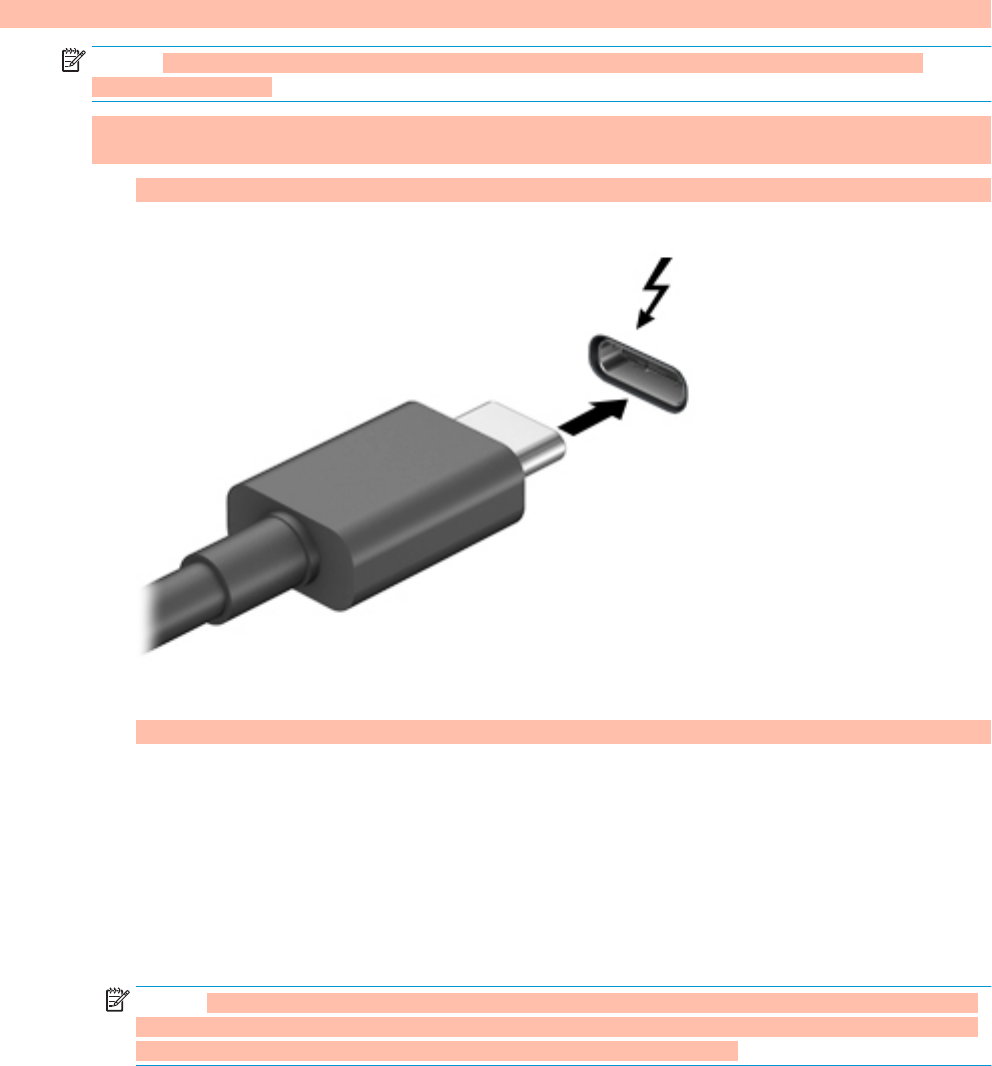
Connecting video devices using a USB Type-C cable (select products only)
NOTE: To connect a USB Type-C Thunderbolt device to your computer, you need a USB Type-C cable,
purchased separately.
To see video or high-resolution display output on an external Thunderbolt device, connect the Thunderbolt
device according to the following instructions:
1. Connect one end of the USB Type-C cable to the USB Type-C Thunderbolt port on the computer.
2. Connect the other end of the cable to the external Thunderbolt device.
3. Press fn+f4 to alternate the computer screen image between 4 display states.
●PC screen only: View the screen image on the computer only.
●Duplicate: View the screen image simultaneously on both the computer and external device.
●Extend: View the screen image extended across both the computer and external device.
●Second screen only: View the screen image on the external device only.
Each time you press fn+f4 the display state changes.
NOTE: For best results, especially if you choose the "Extend" option, increase the screen resolution of
the external device, as follows. Select the Start button, select Settings, and then select System. Under
Display, select the appropriate resolution, and then select Keep changes.
46 Chapter 6 Entertainment features
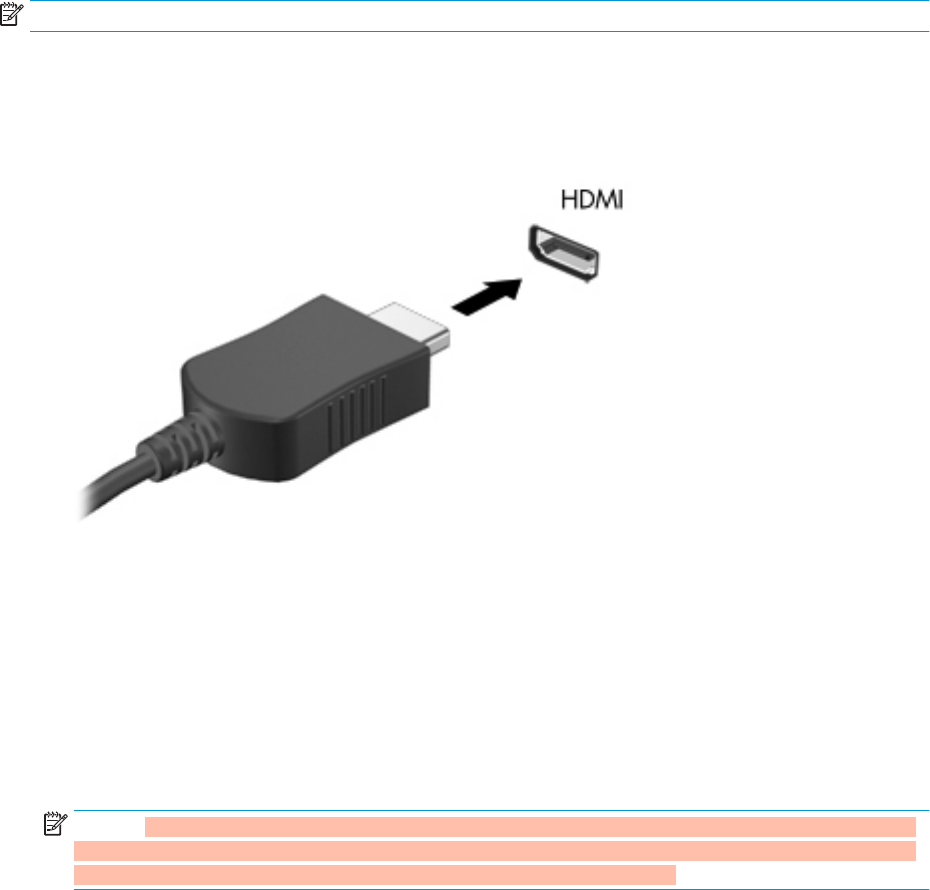
Connecting video devices using an HDMI cable (select products only)
NOTE: To connect an HDMI device to your computer, you need an HDMI cable, purchased separately.
To see the computer screen image on a high-denition TV or monitor, connect the high-denition device
according to the following instructions:
1. Connect one end of the HDMI cable to the HDMI port on the computer.
2. Connect the other end of the cable to the high-denition TV or monitor.
3. Press fn+f4 to alternate the computer screen image between 4 display states:
●PC screen only: View the screen image on the computer only.
●Duplicate: View the screen image simultaneously on both the computer and the external device.
●Extend: View the screen image extended across both the computer and the external device.
●Second screen only: View the screen image on the external device only.
Each time you press fn+f4, the display state changes.
NOTE: For best results, especially if you choose the "Extend" option, increase the screen resolution of
the external device, as follows. Select the Start button, select Settings, and then select System. Under
Display, select the appropriate resolution, and then select Keep changes.
Setting up HDMI audio
HDMI is the only video interface that supports high-denition video and audio. After you connect an HDMI TV
to the computer, you can then turn on HDMI audio by following these steps:
1. Right-click the Speakers icon in the notication area, at the far right of the taskbar, and then select
Playback devices.
2. On the Playback tab, select the name of the digital output device.
3. Click Set Default, and then click OK.
Using video 47

To return the audio stream to the computer speakers:
1. Right-click the Speakers icon in the notication area, at the far right of the taskbar, and then click
Playback devices.
2. On the Playback tab, click Speakers.
3. Click Set Default, and then click OK.
Discovering and connecting to Miracast-compatible wireless displays (select
products only)
NOTE: To learn what type of display you have (Miracast-compatible or Intel® WiDi), refer to the
documentation that came with your TV or secondary display.
To discover and connect to Miracast-compatible wireless displays without leaving your current apps, follow
the steps below.
To open Miracast:
▲Type project in the taskbar search box, and then click Project to a second screen. Click Connect to a
wireless display, and then follow the on-screen instructions.
Discovering and connecting to Intel WiDi certied displays (select Intel products
only)
Use Intel WiDi to wirelessly project individual les such as photos, music, or videos, or to duplicate your entire
computer screen to a TV or a secondary display device.
Intel WiDi, a premium Miracast solution, makes it easy and seamless to pair your secondary display device;
provides for full-screen duplication; and improves speed, quality, and scaling.
To connect to Intel WiDi certied displays:
▲Type project in the taskbar search box, and then click Project to a second screen. Click Connect to a
wireless display, and then follow the on-screen instructions.
To open Intel WiDi:
▲Type Intel WiDi in the taskbar search box, and then click Intel WiDi.
48 Chapter 6 Entertainment features

7 Managing power
Your computer can operate on either battery power or external power. When the computer is running on
battery power and an external power source is not available to charge the battery, it is important to monitor
and conserve the battery charge.
Some power management features described in this chapter may not be available on your computer.
Using Sleep and Hibernation
CAUTION: Several well-known vulnerabilities exist when a computer is in the Sleep state. To prevent an
unauthorized user from accessing data on your computer, even encrypted data, HP recommends that you
always initiate Hibernation instead of Sleep anytime the computer will be out of your physical possession.
This practice is particularly important when you travel with your computer.
CAUTION: To reduce the risk of possible audio and video degradation, loss of audio or video playback
functionality, or loss of information, do not initiate Sleep while reading from or writing to a disc or an external
media card.
Windows has two power-saving states, Sleep and Hibernation.
●Sleep—The Sleep state is automatically initiated after a period of inactivity. Your work is saved to
memory, allowing you to resume your work very quickly. You can also initiate Sleep manually. For more
information, see Initiating and exiting Sleep on page 49.
●Hibernation—The Hibernation state is automatically initiated if the battery reaches a critical level. In the
Hibernation state, your work is saved to a hibernation le and the computer powers down. You can also
initiate Hibernation manually. For more information, see Initiating and exiting Hibernation (select
products only) on page 50.
Initiating and exiting Sleep
You can initiate Sleep in any of the following ways:
●Close the display (select products only).
●Select the Start button, select the Power icon, and then select Sleep.
●Press the Sleep hot key; for example, fn+ f1
You can exit Sleep in any of the following ways:
●Briey press the power button.
●If the computer is closed, raise the display (select products only).
●Press a key on the keyboard (select products only).
●Tap the TouchPad (select products only).
When the computer exits Sleep, your work returns to the screen.
NOTE: If you have set a password to be required on exiting Sleep, you must enter your Windows password
before your work returns to the screen.
Using Sleep and Hibernation 49

Initiating and exiting Hibernation (select products only)
You can enable user-initiated Hibernation and change other power settings and timeouts using Power
Options.
1. Right-click the Power icon , and then select Power Options.
2. In the left pane, select Choose what the power buttons do (wording may vary by product).
3. Depending on your product, you can enable Hibernation for battery power or external power in any of
the following ways:
●Power button—Under Power and sleep buttons and lid settings (wording may vary by product),
select When I press the power button, and then select Hibernate.
●Sleep button (select products only)—Under Power and sleep buttons and lid settings (wording
may vary by product), select When I press the sleep button, and then select Hibernate.
●Lid (select products only)—Under Power and sleep buttons and lid settings (wording may vary by
product), select When I close the lid, and then select Hibernate.
●Power menu—Select Change Settings that are currently unavailable, and then, under Shutdown
settings, select the Hibernate check box.
The Power menu can be accessed by selecting the Start button.
4. Select Save changes.
▲To initiate Hibernation, use the method that you enabled in step 3.
▲To exit Hibernation, briey press the power button.
NOTE: If you have set a password to be required on exiting Hibernation, you must enter your Windows
password before your work returns to the screen.
Shutting down (turning o) the computer
CAUTION: Unsaved information is lost when the computer shuts down. Be sure to save your work before
shutting down the computer.
The Shut down command closes all open programs, including the operating system, and then turns o the
display and the computer.
Shut down the computer when it will be unused and disconnected from external power for an extended
period.
The recommended procedure is to use the Windows Shut down command.
NOTE: If the computer is in the Sleep state or in Hibernation, rst exit Sleep or Hibernation by briey
pressing the power button.
1. Save your work and close all open programs.
2. Select the Start button, select the Power icon, and then select Shut down.
50 Chapter 7 Managing power

If the computer is unresponsive and you are unable to use the preceding shutdown procedures, try the
following emergency procedures in the sequence provided:
●Press ctrl+alt+delete, select the Power icon, and then select Shut down.
●Press and hold the power button for at least 10 seconds.
●If your computer has a user-replaceable battery (select products only), disconnect the computer from
external power, and then remove the battery.
Using the Power icon and Power Options
The Power icon is located on the Windows taskbar. The Power icon allows you to quickly access power
settings and view the remaining battery charge.
●To view the percentage of remaining battery charge and the current power plan, place the mouse
pointer over the Power icon .
●To use Power Options, right–click the Power icon , and then select Power Options.
Dierent Power icons indicate whether the computer is running on battery or external power. Placing the
mouse pointer over the icon reveals a message if the battery has reached a low or critical battery level.
Running on battery power
WARNING! To reduce potential safety issues, use only the battery provided with the computer, a
replacement battery provided by HP, or a compatible battery purchased from HP.
When a charged battery is in the computer and the computer is not plugged into external power, the
computer runs on battery power. When the computer is o and unplugged from external power, the battery in
the computer slowly discharges. The computer displays a message when the battery reaches a low or critical
battery level.
Computer battery life varies, depending on power management settings, programs running on the computer,
screen brightness, external devices connected to the computer, and other factors.
NOTE: When you disconnect external power, the display brightness is automatically decreased to conserve
battery charge. Select computer products can switch between graphic modes to conserve battery charge.
Using HP Fast Charge (select products only)
The HP Fast Charge feature allows you to quickly charge your computer battery. Charging time may vary by
+/- 10%. Depending on your computer model and the HP AC adapter provided with your computer, HP Fast
Charge operates in one of the following ways:
●When the remaining battery charge is between zero and 50%, the battery will charge to 50% of full
capacity in no more than 30 minutes.
●When the remaining battery charge is between zero and 90%, the battery will charge to 90% of full
capacity in no more than 90 minutes.
To use HP Fast Charge, shut down your computer, and then connect the AC adapter to your computer and to
external power.
Using the Power icon and Power Options 51

Displaying battery charge
To view the percentage of remaining battery charge and the current power plan, place the mouse pointer over
the Power icon .
Finding battery information in HP Support Assistant (select products only)
To access battery information:
1. Type support in the taskbar search box, and then select the HP Support Assistant app.
‒ or –
Select the question mark icon in the taskbar.
2. Select My PC, select the Diagnostics and tools tab, and then select HP Battery Check. If HP Battery
Check indicates that your battery should be replaced, contact support.
HP Support Assistant provides the following tools and information about the battery:
●HP Battery Check
●Information about battery types, specications, life cycles, and capacity
Conserving battery power
To conserve battery power and maximize battery life:
●Lower the brightness of the display.
●Select the Power saver setting in Power Options.
●Turn o wireless devices when you are not using them.
●Disconnect unused external devices that are not plugged into an external power source, such as an
external hard drive connected to a USB port.
●Stop, disable, or remove any external media cards that you are not using.
●Before you leave your work, initiate Sleep or shut down the computer.
Identifying low battery levels
When a battery that is the sole power source for the computer reaches a low or critical battery level, the
following behavior occurs:
●The battery light (select products only) indicates a low or critical battery level.
– or –
●The Power icon shows a low or critical battery notication.
NOTE: For additional information about the Power icon, see Using the Power icon and Power Options
on page 51.
52 Chapter 7 Managing power

The computer takes the following actions for a critical battery level:
●If Hibernation is disabled and the computer is on or in the Sleep state, the computer remains briey in
the Sleep state and then shuts down and loses any unsaved information.
●If Hibernation is enabled and the computer is on or in the Sleep state, the computer initiates
Hibernation.
Resolving a low battery level
Resolving a low battery level when external power is available
Connect one of the following to the computer and to external power:
●AC adapter
●Optional docking device or expansion product
●Optional power adapter purchased as an accessory from HP
Resolving a low battery level when no power source is available
Save your work and shut down the computer.
Resolving a low battery level when the computer cannot exit Hibernation
1. Connect the AC adapter to the computer and to external power.
2. Exit Hibernation by pressing the power button.
Factory-sealed battery
To monitor the status of the battery, or if the battery is no longer holding a charge, run HP Battery Check in
the HP Support Assistant app (select products only).
1. Type support in the taskbar search box, and then select the HP Support Assistant app.
– or –
Select the question mark icon in the taskbar.
2. Select My PC, select the Diagnostics and tools tab, and then select HP Battery Check. If HP Battery
Check indicates that your battery should be replaced, contact support.
The battery[ies] in this product cannot be easily replaced by users themselves. Removing or replacing the
battery could aect your warranty coverage. If a battery is no longer holding a charge, contact support.
When a battery has reached the end of its useful life, do not dispose of the battery in general household
waste. Follow the local laws and regulations in your area for battery disposal.
Running on external power
For information about connecting to external power, refer to the Setup Instructions poster provided in the
computer box.
The computer does not use battery power when the computer is connected to external power with an
approved AC adapter or an optional docking device or expansion product.
WARNING! To reduce potential safety issues, use only the AC adapter provided with the computer, a
replacement AC adapter provided by HP, or a compatible AC adapter purchased from HP.
Running on external power 53

WARNING! Do not charge the computer battery while you are aboard aircraft.
Connect the computer to external power under any of the following conditions:
●When charging or calibrating a battery
●When installing or updating system software
●When updating the system BIOS
●When writing information to a disc (select products only)
●When running Disk Defragmenter on computers with internal hard drives
●When performing a backup or recovery
When you connect the computer to external power:
●The battery begins to charge.
●The screen brightness increases.
●The Power icon changes appearance.
When you disconnect external power:
●The computer switches to battery power.
●The screen brightness automatically decreases to conserve battery charge.
●The Power icon changes appearance.
Managing power for the keyboard base
The keyboard base runs on battery power whenever it is not plugged into external AC power. Battery life
varies, depending on use and whether the backlight is used. The keyboard supports sleep state after being
idle for 30 minutes.
Viewing battery charge
The Keyboard battery icon is located on the Windows taskbar. The icon allows you to quickly view the
remaining battery charge.
To view the percentage of remaining battery charge, select the Keyboard battery icon .
NOTE: The keyboard button light also provides information about battery status. See Keyboard connectors,
button, and status light on page 11.
Resolving a keyboard low battery level
To charge the keyboard, use one of these options:
●Connect the keyboard to the tablet. See Connecting the tablet to the keyboard base on page 16.
●Connect the keyboard to external AC power using the USB port on the keyboard and a USB adapter
(purchased separately). To locate the USB port on the keyboard, see USB port and smart card reader/pen
holder slot (select products only) on page 15.
54 Chapter 7 Managing power

8 Security
Protecting the computer
Standard security features provided by the Windows operating system and the Windows Computer Setup
utility (BIOS, which runs under any operating system) can protect your personal settings and data from a
variety of risks.
NOTE: Security solutions are designed to act as deterrents. These deterrents may not prevent a product
from being mishandled or stolen.
NOTE: Before you send your computer for service, back up and delete condential les, and remove all
password settings.
NOTE: Some features listed in this chapter may not be available on your computer.
NOTE: Your computer supports Computrace, which is an online security-based tracking and recovery service
available in select regions. If the computer is stolen, Computrace can track the computer if the unauthorized
user accesses the Internet. You must purchase the software and subscribe to the service in order to use
Computrace. For information about ordering the Computrace software, go to http://www.hp.com.
Computer risk Security feature
Unauthorized use of the computer ●HP Client Security software, in combination with a password,
smart card, contactless card, registered ngerprints, or
other authentication credential
●BIOS power-on password
Unauthorized access to Computer Setup (BIOS) BIOS administrator password in Computer Setup*
Unauthorized access to the contents of a hard drive DriveLock password (select products only) in Computer Setup*
Unauthorized startup from an optional external optical drive
(select products only), optional external hard drive (select
products only), or internal network adapter
Boot options feature in Computer Setup*
Unauthorized access to a Windows user account Windows user password
Unauthorized access to data Windows BitLocker
Unauthorized removal of the computer Security cable slot (used with an optional security cable on select
products only)
*Computer Setup is an embedded, ROM-based utility that can be used even when the operating system is not working or will not load.
You can use a pointing device (TouchPad, pointing stick, or USB mouse) or the keyboard to navigate and make selections in Computer
Setup.
NOTE: On tablets without keyboards, you can use the touch screen.
Using passwords
A password is a group of characters that you choose to secure your computer information. Several types of
passwords can be set, depending on how you want to control access to your information. Passwords can be
set in Windows or in Computer Setup, which is preinstalled on the computer.
Protecting the computer 55

●BIOS administrator, power-on, and DriveLock passwords are set in Computer Setup and are managed by
the system BIOS.
●Windows passwords are set only in the Windows operating system.
●If you forget both the DriveLock user password and the DriveLock master password set in Computer
Setup, the hard drive that is protected by the passwords is permanently locked and can no longer be
used.
You can use the same password for a Computer Setup feature and for a Windows security feature.
Use the following tips for creating and saving passwords:
●When creating passwords, follow requirements set by the program.
●Do not use the same password for multiple applications or websites, and do not reuse your Windows
password for any other application or website.
●Use the Password Manager feature of HP Client Security to store your user names and passwords for
your websites and applications. You can securely read them in the future if they cannot be remembered.
●Do not store passwords in a le on the computer.
The following tables list commonly used Windows and BIOS administrator passwords and describe their
functions.
Setting passwords in Windows
Password Function
Administrator password* Protects access to a Windows administrator-level account.
NOTE: Setting the Windows administrator password does not
set the BIOS administrator password.
User password* Protects access to a Windows user account.
*For information about setting a Windows administrator password or a Windows user password, type support in the taskbar search
box, and then select the HP Support Assistant app.
56 Chapter 8 Security

Setting passwords in Computer Setup
Password Function
BIOS administrator password* Protects access to Computer Setup.
NOTE: If features have been enabled to prevent removing the
BIOS administrator password, you may not be able to remove it
until those features have been disabled.
Power-on password ●Must be entered each time you turn on or restart the
computer.
●If you forget your power-on password, you cannot turn on or
restart the computer.
DriveLock master password* Protects access to the internal hard drive that is protected by
DriveLock, and is set under DriveLock Passwords during the
enable process. This password is also used to remove DriveLock
protection.
DriveLock user password* Protects access to the internal hard drive that is protected by
DriveLock, and is set under DriveLock Passwords during the
enable process.
*For details about each of these passwords, see the following topics.
Managing a BIOS administrator password
To set, change, or delete this password, follow these steps:
Setting a new BIOS administrator password
1. Start Computer Setup.
●Computers or tablets with keyboards:
▲Turn on or restart the computer, and when the HP logo appears, press f10 to enter Computer
Setup.
●Tablets without keyboards:
▲Turn o the tablet. Press the power button in combination with the volume down button until
the Startup menu is displayed, and then tap f10 to enter Computer Setup.
2. Select Security, select Create BIOS administrator password or Set Up BIOS administrator Password
(select products only), and then press enter.
3. When prompted, type a password.
4. When prompted, type the new password again to conrm.
5. To save your changes and exit Computer Setup, select the Save icon and then follow the on-screen
instructions.
– or –
Select Main, select Save Changes and Exit, and then press enter.
Your changes go into eect when the computer restarts.
Changing a BIOS administrator password
1. Start Computer Setup.
Using passwords 57

●Computers or tablets with keyboards:
▲Turn on or restart the computer, and when the HP logo appears, press f10 to enter Computer
Setup.
●Tablets without keyboards:
▲Turn o the tablet. Press the power button in combination with the volume down button until
the Startup menu is displayed, and then tap f10 to enter Computer Setup.
2. Enter your current BIOS administrator password.
3. Select Security, select Change BIOS administrator Password or Change Password (select products
only), and then press enter.
4. When prompted, type your current password.
5. When prompted, type your new password.
6. When prompted, type your new password again to conrm.
7. To save your changes and exit Computer Setup, select the Save icon, and then follow the on-screen
instructions.
– or –
Select Main, select Save Changes and Exit, and then press enter.
Your changes go into eect when the computer restarts.
Deleting a BIOS administrator password
1. Start Computer Setup.
●Computers or tablets with keyboards:
▲Turn on or restart the computer, and when the HP logo appears, press f10 to enter Computer
Setup.
●Tablets without keyboards:
▲Turn o the tablet. Press the power button in combination with the volume down button until
the Startup menu is displayed, and then tap f10 to enter Computer Setup.
2. Enter your current BIOS administrator password.
3. Select Security, select Change BIOS administrator Password or Change Password (select products
only), and then press enter.
4. When prompted, type your current password.
5. When prompted for the new password, leave the eld empty, and then press enter.
6. When prompted to type your new password again, leave the eld empty, and then press enter.
7. To save your changes and exit Computer Setup, select the Save icon, and then follow the on-screen
instructions.
– or –
Select Main, select Save Changes and Exit, and then press enter.
Your changes go into eect when the computer restarts.
58 Chapter 8 Security

Entering a BIOS administrator password
At the BIOS administrator password prompt, type your password (using the same kind of keys you used to
set the password), and then press enter. After two unsuccessful attempts to enter the BIOS administrator
password, you must restart the computer and try again.
Using DriveLock Security Options
DriveLock protection prevents unauthorized access to the contents of a hard drive. DriveLock can be applied
only to the internal hard drive(s) of the computer. After DriveLock protection is applied to a drive, the
appropriate password must be entered to access the drive. The drive must be inserted into the computer or an
advanced port replicator in order for it to be unlocked.
DriveLock Security Options oers the following features:
●Automatic DriveLock—See Selecting Automatic DriveLock (select products only) on page 59.
●Set DriveLock Master Password—See Selecting manual DriveLock on page 60.
●Enable DriveLock—See Enabling DriveLock and setting a DriveLock user password on page 61.
Selecting Automatic DriveLock (select products only)
A BIOS administrator password must be set before you can enable Automatic DriveLock. When Automatic
DriveLock is enabled, a random DriveLock user password and a DriveLock master password derived from the
BIOS administrator password are created. When the computer is turned on, the random user password
automatically unlocks the drive. If the drive is moved to another computer, you must enter the BIOS
administrator password for the original computer at the DriveLock password prompt to unlock the drive.
Enabling Automatic DriveLock
To enable Automatic DriveLock, follow these steps:
1. Start Computer Setup.
●Computers or tablets with keyboards:
1. Turn o the computer.
2. Press the power button, and when the HP logo appears, press f10 to enter Computer Setup.
●Tablets without keyboards:
1. Turn o the tablet.
2. Press the power button in combination with the volume down button until the Startup menu
is displayed, and then tap f10 to enter Computer Setup.
2. At the BIOS administrator password prompt, enter the BIOS administrator password, and then press
enter.
3. Select Security, select Hard Drive Utilities, select DriveLock/Automatic DriveLock, and then press
enter.
4. Use the enter key, left mouse click, or touch screen to select the Automatic DriveLock check box.
5. To save your changes and exit Computer Setup, select the Save icon and then follow the on-screen
instructions.
– or –
Select Main, select Save Changes and Exit, and then press enter.
Using passwords 59

Disabling Automatic DriveLock
To disable Automatic DriveLock, follow these steps:
1. Start Computer Setup.
●Computers or tablets with keyboards:
1. Turn o the computer.
2. Press the power button, and when the HP logo appears, press f10 to enter Computer Setup.
●Tablets without keyboards:
1. Turn o the tablet.
2. Press the power button in combination with the volume down button until the Startup menu
is displayed, and then tap f10 to enter Computer Setup.
2. At the BIOS administrator password prompt, enter the BIOS administrator password, and then press
enter.
3. Select Security, select Hard Drive Utilities, select DriveLock/Automatic DriveLock, and then press
enter.
4. Select an internal hard drive, and then press enter.
5. Use the enter key, left mouse click, or touch screen to clear the Automatic DriveLock check box.
6. To save your changes and exit Computer Setup, select the Save icon, and then follow the on-screen
instructions.
– or –
Select Main, select Save Changes and Exit, and then press enter.
Entering an Automatic DriveLock password
While Automatic DriveLock is enabled and the drive remains attached to the original computer, you will not be
prompted to enter a DriveLock password to unlock the drive. However, if the drive is moved to another
computer, or the system board is replaced on the original computer, you will be prompted to provide the
DriveLock password.
If this happens, at the DriveLock Password prompt, type the BIOS administrator password for the original
computer (using the same kind of keys you used to set the password), and then press enter to unlock the
drive.
After three incorrect attempts to enter the password, you must shut down the computer and try again.
Selecting manual DriveLock
CAUTION: To prevent a DriveLock-protected hard drive from becoming permanently unusable, record the
DriveLock user password and the DriveLock master password in a safe place away from your computer. If you
forget both DriveLock passwords, the hard drive will be permanently locked and can no longer be used.
60 Chapter 8 Security

To manually apply DriveLock protection to an internal hard drive, a master password must be set, and
DriveLock must be enabled in Computer Setup. Note the following considerations about using DriveLock
protection:
●After DriveLock protection is applied to a hard drive, the hard drive can be accessed only by entering
either the DriveLock user password or the master password.
●The owner of the DriveLock user password should be the day-to-day user of the protected hard drive.
The owner of the DriveLock master password may be either a system administrator or the day-to-day
user.
●The DriveLock user password and the DriveLock master password can be identical.
Setting a DriveLock master password
To set a DriveLock master password, follow these steps:
1. Start Computer Setup.
●Computers or tablets with keyboards:
1. Turn o the computer.
2. Press the power button, and when the HP logo appears, press f10 to enter Computer Setup.
●Tablets without keyboards:
1. Turn o the tablet.
2. Press the power button in combination with the volume down button until the Startup menu
is displayed, and then tap f10 to enter Computer Setup.
2. Select Security, make the selection for Hard Drive Utilities, select DriveLock/Automatic DriveLock,
and then press enter.
3. Select the hard drive you want to protect, and then press enter.
4. Select Set DriveLock Master Password, and then press enter.
5. Carefully read the warning.
6. Follow the on-screen instructions to set a DriveLock master password.
NOTE: You can enable DriveLock and set a DriveLock user password before exiting from Computer
Setup. For more information, see Enabling DriveLock and setting a DriveLock user password
on page 61.
7. To exit Computer Setup, select Main, select Save Changes and Exit, and then select Yes.
Enabling DriveLock and setting a DriveLock user password
To enable DriveLock, and set a DriveLock user password, follow these steps:
1. Start Computer Setup.
●Computers or tablets with keyboards:
1. Turn o the computer.
2. Press the power button, and when the HP logo appears, press f10 to enter Computer Setup.
●Tablets without keyboards:
Using passwords 61

1. Turn o the tablet.
2. Press the power button in combination with the volume down button until the Startup menu
is displayed, and then tap f10 to enter Computer Setup.
2. Select Security, select Hard Drive Utilities, select DriveLock/Automatic DriveLock, and then press
enter.
3. Select the hard drive you want to protect, and then press enter.
4. Select Enable DriveLock and then press enter.
5. Carefully read the warning.
6. Follow the on-screen instructions to set a DriveLock user password and enable DriveLock.
7. To exit Computer Setup, select Main, select Save Changes and Exit, and then select Yes.
Disabling DriveLock
1. Start Computer Setup.
●Computers or tablets with keyboards:
1. Turn o the computer.
2. Press the power button, and when the HP logo appears, press f10 to enter Computer Setup.
●Tablets without keyboards:
1. Turn o the tablet.
2. Press the power button in combination with the volume down button until the Startup menu
is displayed, and then tap f10 to enter Computer Setup.
2. Select Security, select Hard Drive Utilities, select DriveLock/Automatic DriveLock, and then press
enter.
3. Select the hard drive you want to manage, and then press enter.
4. Select Disable DriveLock, and then press enter.
5. Follow the on-screen instructions to disable DriveLock.
6. To exit Computer Setup, select Main, select Save Changes and Exit, and then select Yes.
Entering a DriveLock password
Be sure that the hard drive is inserted into the computer (not into an optional docking device or external
MultiBay).
At the DriveLock Password prompt, type your DriveLock user or master password (using the same kind of
keys you used to set the password), and then press enter.
After three incorrect attempts to enter the password, you must shut down the computer and try again.
Changing a DriveLock password
To change a DriveLock password in Computer Setup, follow these steps:
1. Turn o the computer.
2. Press the power button.
62 Chapter 8 Security

3. At the DriveLock Password prompt, type the current DriveLock user password or master password that
you are changing, press enter, and then press or tap f10 to enter Computer Setup.
4. Select Security, select Hard Drive Utilities, select DriveLock/Automatic DriveLock, and then press
enter.
5. Select the hard drive you want to manage, and then press enter.
6. Make the selection for the DriveLock password that you want to change, and then follow the on-screen
instructions to enter passwords.
NOTE: The Change DriveLock Master Password option is visible only if the DriveLock master
password was provided at the DriveLock Password prompt in step 3.
7. To exit Computer Setup, select Main, select Save Changes and Exit, and then follow the on-screen
instructions.
Using Windows Hello (select products only)
On products equipped with a ngerprint reader or an infrared camera, you can use Windows Hello to sign in by
swiping your nger or looking at the camera.
To set up Windows Hello, follow these steps:
1. Select the Start button, select Settings, select Accounts, and then select Sign-in options.
2. Under Windows Hello, follow the on-screen instructions to add both a password and a numeric PIN, and
then enroll your ngerprint or facial ID.
NOTE: The PIN is not limited in length, but it must consist of numbers only. No alphabetic or special
characters are allowed.
Using antivirus software
When you use the computer to access e-mail, a network, or the Internet, you potentially expose it to
computer viruses. Computer viruses can disable the operating system, programs, or utilities, or cause them to
function abnormally.
Antivirus software can detect most viruses, destroy them, and, in most cases, repair any damage they have
caused. To provide ongoing protection against newly discovered viruses, antivirus software must be kept up
to date.
Windows Defender is preinstalled on your computer. It is strongly recommended that you continue to use an
antivirus program in order to fully protect your computer.
For more information about computer viruses, access the HP Support Assistant.
Using rewall software
Firewalls are designed to prevent unauthorized access to a system or network. A rewall can be a software
program you install on your computer and/or network, or it can be a solution made up of both hardware and
software.
There are two types of rewalls to consider:
●Host-based rewalls—Software that protects only the computer it is installed on.
●Network-based rewalls—Installed between your DSL or cable modem and your home network to
protect all the computers on the network.
Using Windows Hello (select products only) 63

When a rewall is installed on a system, all data sent to and from the system is monitored and compared with
a set of user-dened security criteria. Any data that does not meet those criteria is blocked.
Your computer or networking equipment may already have a rewall installed. If not, rewall software
solutions are available.
NOTE: Under some circumstances a rewall can block access to Internet games, interfere with printer or le
sharing on a network, or block authorized e-mail attachments. To temporarily resolve the problem, disable
the rewall, perform the task that you want to perform, and then reenable the rewall. To permanently
resolve the problem, recongure the rewall.
Installing software updates
HP, Windows, and third-party software installed on your computer should be regularly updated to correct
security problems and improve software performance.
IMPORTANT: Microsoft sends out alerts regarding Windows updates, which may include security updates.
To protect the computer from security breaches and computer viruses, install all updates from Microsoft as
soon as you receive an alert.
You can install these updates automatically.
To view or change the settings:
1. Select the Start button, select Settings, and then select Update & Security.
2. Select Windows Update, and then follow the on-screen instructions.
3. To schedule a time for installing updates, select Advanced Options, and then follow the on-screen
instructions.
Using HP Client Security (select products only)
HP Client Security software is preinstalled on your computer. This software can be accessed through the HP
Client Security icon at the far right of the taskbar or Windows Control Panel. It provides security features that
help protect against unauthorized access to the computer, networks, and critical data. For more information,
see the HP Client Security software Help.
Using HP Touchpoint Manager (select products only)
HP Touchpoint Manager is a cloud-based IT solution that enables businesses to eectively manage and secure
their company assets. HP Touchpoint Manager helps protect devices against malware and other attacks,
monitors device health, and enables customers to reduce time spent solving end-user device and security
issues. Customers can quickly download and install the software, which is highly cost eective relative to
traditional in-house solutions. For more information, see http://www.hptouchpointmanager.com.
Using an optional security cable (select products only)
A security cable (purchased separately) is designed to act as a deterrent, but it may not prevent the computer
from being mishandled or stolen. To connect a security cable to your computer, follow the device
manufacturer's instructions.
64 Chapter 8 Security

Using a ngerprint reader (select products only)
Integrated ngerprint readers are available on select products. In order to use the ngerprint reader, you
must enroll your ngerprints in HP Client Security's Credential Manager. Refer to the HP Client Security
software Help.
After you enroll your ngerprints in Credential Manager, you can use HP Client Security's Password Manager
to store and ll in your user names and passwords in supported websites and applications.
Locating the ngerprint reader
The ngerprint reader is a small metallic sensor that is located in one of the following areas of your computer:
●Near the bottom of the TouchPad
●On the right side of the keyboard
●On the upper-right side of the display
●On the left side of the display
●On the back of the display
Depending on your product, the reader may be oriented horizontally or vertically.
Using a ngerprint reader (select products only) 65

9 Maintenance
It is important to perform regular maintenance to keep your computer in optimal condition. This chapter
explains how to use tools like Disk Defragmenter and Disk Cleanup. It also provides instructions for updating
programs and drivers, steps to clean the computer, and tips for traveling with (or shipping) the computer.
Improving performance
You can improve the performance of your computer by performing regular maintenance tasks with tools such
as Disk Defragmenter and Disk Cleanup.
Using Disk Defragmenter
HP recommends using Disk Defragmenter to defragment your hard drive at least once a month.
NOTE: It is not necessary to run Disk Defragmenter on solid-state drives.
To run Disk Defragmenter:
1. Connect the computer to AC power.
2. Type defragment in the taskbar search box, and then select Defragment and optimize your drives.
3. Follow the on-screen instructions.
For additional information, access the Disk Defragmenter software Help.
Using Disk Cleanup
Use Disk Cleanup to search the hard drive for unnecessary les that you can safely delete to free up disk space
and help the computer run more eciently.
To run Disk Cleanup:
1. Type disk in the taskbar search box, and then select Disk Cleanup.
2. Follow the on-screen instructions.
Using HP 3D DriveGuard (select products only)
HP 3D DriveGuard protects a hard drive by parking the drive and halting data requests under either of the
following conditions:
●You drop the computer.
●You move the computer with the display closed while the computer is running on battery power.
A short time after the end of one of these events, HP 3D DriveGuard returns the hard drive to normal
operation.
NOTE: Only internal hard drives are protected by HP 3D DriveGuard. A hard drive installed in an optional
docking device or connected to a USB port is not protected by HP 3D DriveGuard.
NOTE: Because solid-state drives (SSDs) lack moving parts, HP 3D DriveGuard is unnecessary for these
drives.
66 Chapter 9 Maintenance

For more information, see the HP 3D DriveGuard software Help.
Identifying HP 3D DriveGuard status
The hard drive light on the computer changes color to show that the drive in a primary hard drive bay and/or
the drive in a secondary hard drive bay (select products only) is parked. To determine whether a drive is
currently protected or whether it is parked, view the icon on the Windows desktop in the notication area, at
the far right of the taskbar.
Updating programs and drivers
HP recommends that you update your programs and drivers on a regular basis. Updates can resolve issues
and bring new features and options to your computer. For example, older graphics components might not
work well with the most recent gaming software. Without the latest driver, you would not be getting the most
out of your equipment.
Go to http://www.hp.com/support to download the latest versions of HP programs and drivers. In addition,
register to receive automatic notications when updates become available.
If you would like to update your programs and drivers, follow these instructions:
1. Type support in the taskbar search box, and then select the HP Support Assistant app.
‒ or –
Click the question mark icon in the taskbar.
2. Select My PC, select the Updates tab, and then select Check for updates and messages.
3. Follow the on-screen instructions.
Cleaning your computer
Use the following products to safely clean your computer:
●Dimethyl benzyl ammonium chloride 0.3 percent maximum concentration (for example, disposable
wipes, which come in a variety of brands)
●Alcohol-free glass-cleaning uid
●Solution of water and mild soap
●Dry microber cleaning cloth or a chamois (static-free cloth without oil)
●Static-free cloth wipes
CAUTION: Avoid strong cleaning solvents that can permanently damage your computer. If you are not sure
that a cleaning product is safe for your computer, check the product contents to make sure that ingredients
such as alcohol, acetone, ammonium chloride, methylene chloride, and hydrocarbons are not included in the
product.
Fibrous materials, such as paper towels, can scratch the computer. Over time, dirt particles and cleaning
agents can get trapped in the scratches.
Cleaning procedures
Follow the procedures in this section to safely clean your computer.
Updating programs and drivers 67
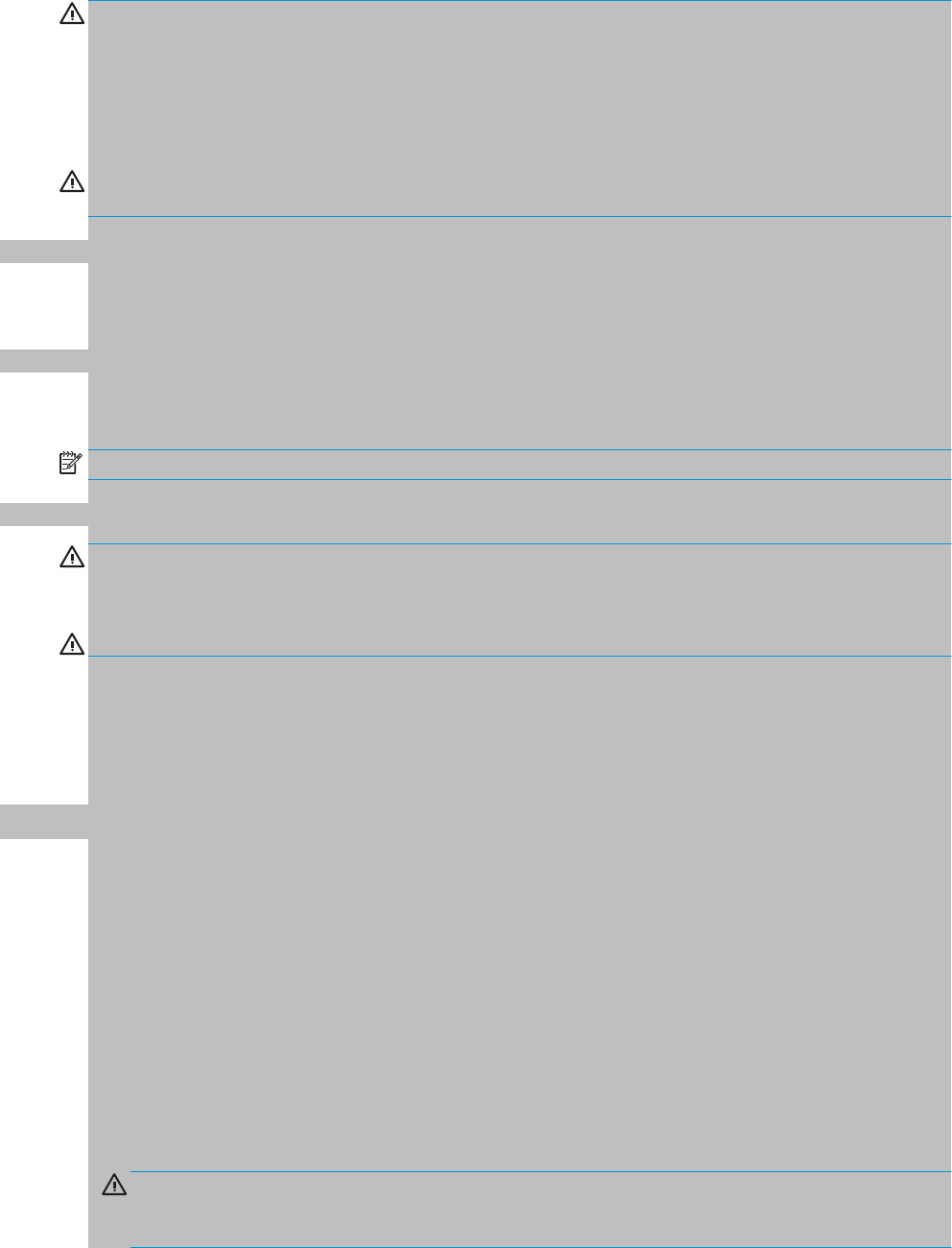
WARNING! To prevent electric shock or damage to components, do not attempt to clean your computer
while it is on.
1. Turn o the computer.
2. Disconnect AC power.
3. Disconnect all powered external devices.
CAUTION: To prevent damage to internal components, do not spray cleaning agents or liquids directly on
any computer surface. Liquids dripped on the surface can permanently damage internal components.
Cleaning the display
Gently wipe the display using a soft, lint-free cloth moistened with an alcohol-free glass cleaner. Be sure that
a display is dry before you close the computer.
Cleaning the sides or cover
To clean the sides or cover, use a soft microber cloth or chamois moistened with one of the cleaning
solutions listed previously, or use an acceptable disposable wipe.
NOTE: When cleaning the cover of the computer, use a circular motion to aid in removing dirt and debris.
Cleaning the TouchPad, keyboard, or mouse (select products only)
WARNING! To reduce the risk of electric shock or damage to internal components, do not use a vacuum
cleaner attachment to clean the keyboard. A vacuum cleaner can deposit household debris on the keyboard
surface.
CAUTION: To prevent damage to internal components, do not allow liquids to drip between the keys.
●To clean the TouchPad, keyboard, or mouse, use a soft microber cloth or a chamois moistened with one
of the cleaning solutions listed previously or use an acceptable disposable wipe.
●To prevent keys from sticking and to remove dust, lint, and particles from the keyboard, use a can of
compressed air with a straw extension.
Traveling with or shipping your computer
If you have to travel with or ship your computer, follow these tips to keep your equipment safe.
●Prepare the computer for traveling or shipping:
–Back up your information to an external drive.
–Remove all discs and all external media cards, such as memory cards.
–Turn o and then disconnect all external devices.
–Shut down the computer.
●Take along a backup of your information. Keep the backup separate from the computer.
●When traveling by air, carry the computer as hand luggage; do not check it in with the rest of your
luggage.
CAUTION: Avoid exposing a drive to magnetic elds. Security devices with magnetic elds include
airport walk-through devices and security wands. Airport conveyer belts and similar security devices
that check carry-on baggage use X-rays instead of magnetism and do not damage drives.
68 Chapter 9 Maintenance

●If you plan to use the computer during a ight, listen for the in-ight announcement that tells you when
you are allowed to use your computer. In-ight computer use is at the discretion of the airline.
●If you are shipping the computer or a drive, use suitable protective packaging and label the package
“FRAGILE.”
●The use of wireless devices may be restricted in some environments. Such restrictions may apply aboard
aircraft, in hospitals, near explosives, and in hazardous locations. If you are uncertain of the policy that
applies to the use of a wireless device in your computer, ask for authorization to use your computer
before you turn it on.
●If you are traveling internationally, follow these suggestions:
–Check the computer-related customs regulations for each country or region on your itinerary.
–Check the power cord and adapter requirements for each location in which you plan to use the
computer. Voltage, frequency, and plug congurations vary.
WARNING! To reduce the risk of electric shock, re, or damage to the equipment, do not attempt
to power the computer with a voltage converter kit sold for appliances.
Traveling with or shipping your computer 69

10 Backing up, restoring, and recovering
This chapter provides information about the following processes. The information in the chapter is standard
procedure for most products.
●Creating recovery media and backups
●Restoring and recovering your system
For additional information, refer to the HP Support Assistant app.
▲Type support in the taskbar search box, and then select the HP Support Assistant app.
‒ or –
Select the question mark icon in the taskbar.
IMPORTANT: If you will be performing recovery procedures on a tablet, the tablet battery must be at least
70% charged before you start the recovery process.
IMPORTANT: For a tablet with a detachable keyboard, connect the tablet to the keyboard base before
beginning any recovery process.
Creating recovery media and backups
The following methods of creating recovery media and backups are available on select products only. Choose
the available method according to your computer model.
●Use HP Recovery Manager to create HP Recovery media after you successfully set up the computer. This
step creates a backup of the HP Recovery partition on the computer. The backup can be used to reinstall
the original operating system in cases where the hard drive is corrupted or has been replaced. For
information on creating recovery media, see Creating HP Recovery media (select products only)
on page 70. For information on the recovery options that are available using the recovery media, see
Using Windows tools on page 71.
●Use Windows tools to create system restore points and create backups of personal information.
For more information, see Recovering using HP Recovery Manager on page 72.
NOTE: If storage is 32 GB or less, Microsoft System Restore is disabled by default.
●On select products, use the HP Cloud Recovery Download Tool to create a bootable USB drive for your HP
recovery media. Go to https://support.hp.com/us-en/document/c05115630?openCLC=true, select your
country or region, and follow the on-screen instructions.
Creating HP Recovery media (select products only)
If possible, check for the presence of the Recovery partition and the Windows partition. Right-click the Start
menu, select File Explorer, and then select This PC.
●If your computer does not list the Windows partition and the Recovery partition, you can obtain recovery
media for your system from support. You can nd contact information on the HP website. Go to
http://www.hp.com/support, select your country or region, and follow the on-screen instructions.
70 Chapter 10 Backing up, restoring, and recovering

You can use Windows tools to create system restore points and create backups of personal information,
see Using Windows tools on page 71.
●If your computer does list the Recovery partition and the Windows partition, you can use HP Recovery
Manager to create recovery media after you successfully set up the computer. HP Recovery media can be
used to perform system recovery if the hard drive becomes corrupted. System recovery reinstalls the
original operating system and software programs that were installed at the factory and then congures
the settings for the programs. HP Recovery media can also be used to customize the system or restore
the factory image if you replace the hard drive.
–Only one set of recovery media can be created. Handle these recovery tools carefully, and keep
them in a safe place.
–HP Recovery Manager examines the computer and determines the required storage capacity for
the media that will be required.
–To create recovery discs, your computer must have an optical drive with DVD writer capability, and
you must use only high-quality blank DVD-R, DVD+R, DVD-R DL, or DVD+R DL discs. Do not use
rewritable discs such as CD±RW, DVD±RW, double-layer DVD±RW, or BD-RE (rewritable Blu-ray)
discs; they are not compatible with HP Recovery Manager software. Or, instead, you can use a high-
quality blank USB ash drive.
–If your computer does not include an integrated optical drive with DVD writer capability, but you
would like to create DVD recovery media, you can use an external optical drive (purchased
separately) to create recovery discs. If you use an external optical drive, it must be connected
directly to a USB port on the computer; the drive cannot be connected to a USB port on an external
device, such as a USB hub. If you cannot create DVD media yourself, you can obtain recovery discs
for your computer from HP. You can nd contact information on the HP website. Go to
http://www.hp.com/support, select your country or region, and follow the on-screen instructions.
–Be sure that the computer is connected to AC power before you begin creating the recovery media.
–The creation process can take an hour or more. Do not interrupt the creation process.
–If necessary, you can exit the program before you have nished creating all of the recovery DVDs.
HP Recovery Manager will nish burning the current DVD. The next time you start HP Recovery
Manager, you will be prompted to continue.
To create HP Recovery media:
IMPORTANT: For a tablet with a detachable keyboard, connect the tablet to the keyboard base before
beginning these steps.
1. Type recovery in the taskbar search box, and then select HP Recovery Manager.
2. Select Create recovery media, and then follow the on-screen instructions.
If you ever need to recover the system, see Recovering using HP Recovery Manager on page 72.
Using Windows tools
You can create recovery media, system restore points, and backups of personal information using Windows
tools.
NOTE: If storage is 32 GB or less, Microsoft System Restore is disabled by default.
For more information and steps, see the Get help app.
▲Select the Start button, and then select the Get Help app.
Using Windows tools 71

NOTE: You must be connected to the Internet to access the Get help app.
Restore and recovery
There are several options for recovering your system. Choose the method that best matches your situation
and level of expertise:
IMPORTANT: Not all methods are available on all products.
●Windows oers several options for restoring from backup, refreshing the computer, and resetting the
computer to its original state. For more information see the Get help app.
▲Select the Start button, and then select the Get Help app.
NOTE: You must be connected to the Internet to access the Get help app.
●If you need to correct a problem with a preinstalled application or driver, use the Reinstall drivers and/or
applications option (select products only) of HP Recovery Manager to reinstall the individual application
or driver.
▲Type recovery in the taskbar search box, select HP Recovery Manager, select Reinstall drivers
and/or applications, and then follow the on-screen instructions.
●If you want to recover the Windows partition to original factory content, you can choose the System
Recovery option from the HP Recovery partition (select products only) or use the HP Recovery media.
For more information, see Recovering using HP Recovery Manager on page 72. If you have not already
created recovery media, see Creating HP Recovery media (select products only) on page 70.
●On select products, if you want to recover the computer's original factory partition and content, or if you
have replaced the hard drive, you can use the Factory Reset option of HP Recovery media. For more
information, see Recovering using HP Recovery Manager on page 72.
●On select products, if you want to remove the Recovery partition to reclaim hard drive space, HP
Recovery Manager oers the Remove Recovery Partition option.
For more information, see Removing the HP Recovery partition (select products only) on page 74.
Recovering using HP Recovery Manager
HP Recovery Manager software allows you to recover the computer to its original factory state by using the
HP Recovery media that you either created or that you obtained from HP, or by using the HP Recovery
partition (select products only). If you have not already created recovery media, see Creating HP Recovery
media (select products only) on page 70.
What you need to know before you get started
●HP Recovery Manager recovers only software that was installed at the factory. For software not provided
with this computer, you must either download the software from the manufacturer's website or reinstall
the software from the media provided by the manufacturer.
IMPORTANT: Recovery through HP Recovery Manager should be used as a nal attempt to correct
computer issues.
●HP Recovery media must be used if the computer hard drive fails. If you have not already created
recovery media, see Creating HP Recovery media (select products only) on page 70.
72 Chapter 10 Backing up, restoring, and recovering

●To use the Factory Reset option (select products only), you must use HP Recovery media. If you have not
already created recovery media, see Creating HP Recovery media (select products only) on page 70.
●If your computer does not allow the creation of HP Recovery media or if the HP Recovery media does not
work, you can obtain recovery media for your system from support. You can nd contact information
from the HP website. Go to http://www.hp.com/support, select your country or region, and follow the
on-screen instructions.
IMPORTANT: HP Recovery Manager does not automatically provide backups of your personal data. Before
beginning recovery, back up any personal data you want to retain.
Using HP Recovery media, you can choose from one of the following recovery options:
NOTE: Only the options available for your computer display when you start the recovery process.
●System Recovery—Reinstalls the original operating system, and then congures the settings for the
programs that were installed at the factory.
●Factory Reset—Restores the computer to its original factory state by deleting all information from the
hard drive and re-creating the partitions. Then it reinstalls the operating system and the software that
was installed at the factory.
The HP Recovery partition (select products only) allows System Recovery only.
Using the HP Recovery partition (select products only)
The HP Recovery partition allows you to perform a system recovery without the need for recovery discs or a
recovery USB ash drive. This type of recovery can be used only if the hard drive is still working.
To start HP Recovery Manager from the HP Recovery partition:
IMPORTANT: For a tablet with a detachable keyboard, connect the tablet to the keyboard base before
beginning these steps (select products only).
1. Type recovery in the taskbar search box, select HP Recovery Manager, and then select Windows
Recovery Environment.
‒ or –
For computers or tablets with keyboards attached, press f11 while the computer boots, or press and
hold f11 as you press the power button.
For tablets without keyboards:
●Turn on or restart the tablet, and then quickly hold down the volume up button; then select f11.
‒ or –
●Turn on or restart the tablet, and then quickly hold down the volume down button; then select f11.
2. Select Troubleshoot from the boot options menu.
3. Select Recovery Manager, and then follow the on-screen instructions.
Using HP Recovery media to recover
You can use HP Recovery media to recover the original system. This method can be used if your system does
not have an HP Recovery partition or if the hard drive is not working properly.
Restore and recovery 73

1. If possible, back up all personal les.
2. Insert the HP Recovery media, and then restart the computer.
NOTE: If the computer does not automatically restart in HP Recovery Manager, change the computer
boot order. See Changing the computer boot order on page 74.
3. Follow the on-screen instructions.
Changing the computer boot order
If your computer does not restart in HP Recovery Manager, you can change the computer boot order, which is
the order of devices listed in BIOS where the computer looks for startup information. You can change the
selection to an optical drive or a USB ash drive.
To change the boot order:
IMPORTANT: For a tablet with a detachable keyboard, connect the tablet to the keyboard base before
beginning these steps.
1. Insert the HP Recovery media.
2. Access the system Startup menu.
For computers or tablets with keyboards attached:
▲Turn on or restart the computer or tablet, quickly press esc, and then press f9 for boot options.
For tablets without keyboards:
▲Turn on or restart the tablet, and then quickly hold down the volume up button; then select f9.
‒ or –
Turn on or restart the tablet, and then quickly hold down the volume down button; then select f9.
3. Select the optical drive or USB ash drive from which you want to boot.
4. Follow the on-screen instructions.
Removing the HP Recovery partition (select products only)
HP Recovery Manager software allows you to remove the HP Recovery partition to free up hard drive space.
IMPORTANT: After you remove the HP Recovery partition, you will not be able to perform System Recovery
or create HP Recovery media from the HP Recovery partition. So before you remove the Recovery partition,
create HP Recovery media; see Creating HP Recovery media (select products only) on page 70.
NOTE: The Remove Recovery Partition option is only available on products that support this function.
Follow these steps to remove the HP Recovery partition:
1. Type recovery in the taskbar search box, and then select HP Recovery Manager.
2. Select Remove Recovery Partition, and then follow the on-screen instructions.
74 Chapter 10 Backing up, restoring, and recovering

11 Computer Setup (BIOS), TPM, and HP Sure
Start
Using Computer Setup
Computer Setup, or Basic Input/Output System (BIOS), controls communication between all the input and
output devices on the system (such as disk drives, display, keyboard, mouse, and printer). Computer Setup
includes settings for the types of devices installed, the startup sequence of the computer, and the amount of
system and extended memory.
NOTE: Use extreme care when making changes in Computer Setup. Errors can prevent the computer from
operating properly.
Starting Computer Setup
IMPORTANT: The keyboard must be attached to the tablet.
▲Turn on or restart the computer, and when the HP logo appears, press f10 to enter Computer Setup.
Navigating and selecting in Computer Setup
●To select a menu or a menu item, use the tab key and the keyboard arrow keys and then press enter, or
use a pointing device to select the item.
●To scroll up and down, select the up arrow or the down arrow in the upper-right corner of the screen, or
use the up arrow key or the down arrow key on the keyboard.
●To close open dialog boxes and return to the main Computer Setup screen, press esc, and then follow
the on-screen instructions.
To exit Computer Setup menus, choose one of the following methods:
●To exit Computer Setup menus without saving your changes:
Select the Exit icon in the lower-right corner of the screen, and then follow the on-screen instructions.
– or –
Select Main, select Ignore Changes and Exit, and then press enter.
●To save your changes and exit Computer Setup menus:
Select the Save icon in the lower-right corner of the screen, and then follow the on-screen instructions.
– or –
Select Main, select Save Changes and Exit, and then press enter.
Your changes go into eect when the computer restarts.
Restoring factory settings in Computer Setup
NOTE: Restoring defaults will not change the hard drive mode.
Using Computer Setup 75

To return all settings in Computer Setup to the values that were set at the factory, follow these steps:
1. Start Computer Setup. See Starting Computer Setup on page 75.
2. Select Main, and then select Apply Factory Defaults and Exit.
NOTE: On select products, the selections may display Restore Defaults instead of Apply Factory
Defaults and Exit.
3. Follow the on-screen instructions.
4. To save your changes and exit, select the Save icon in the lower-right corner of the screen, and then
follow the on-screen instructions.
– or –
Select Main, select Save Changes and Exit, and then press enter.
Your changes go into eect when the computer restarts.
NOTE: Your password settings and security settings are not changed when you restore the factory settings.
76 Chapter 11 Computer Setup (BIOS), TPM, and HP Sure Start

Updating the BIOS
Updated versions of the BIOS may be available on the HP website.
Most BIOS updates on the HP website are packaged in compressed les called SoftPaqs.
Some download packages contain a le named Readme.txt, which contains information regarding installing
and troubleshooting the le.
Determining the BIOS version
To decide whether you need to update Computer Setup (BIOS), rst determine the BIOS version on your
computer.
BIOS version information (also known as ROM date and System BIOS) can be accessed by pressing fn+esc (if
you are already in Windows) or by using Computer Setup.
1. Start Computer Setup. See Starting Computer Setup on page 75.
2. Select Main, and then select System Information.
3. To exit Computer Setup without saving your changes, select the Exit icon in the lower-right corner of the
screen, and then follow the on-screen instructions.
– or –
Select Main, select Ignore Changes and Exit, and then press enter.
To check for later BIOS versions, see Downloading a BIOS update on page 77.
Downloading a BIOS update
CAUTION: To reduce the risk of damage to the computer or an unsuccessful installation, download and
install a BIOS update only when the computer is connected to reliable external power using the AC adapter. Do
not download or install a BIOS update while the computer is running on battery power, docked in an optional
docking device, or connected to an optional power source. During the download and installation, follow these
instructions:
Do not disconnect power on the computer by unplugging the power cord from the AC outlet.
Do not shut down the computer or initiate Sleep.
Do not insert, remove, connect, or disconnect any device, cable, or cord.
1. Type support in the taskbar search box, and then select the HP Support Assistant app.
– or –
Select the question mark icon in the taskbar.
2. Select Updates, and then select Check for updates and messages.
3. Follow the on-screen instructions.
4. At the download area, follow these steps:
a. Identify the most recent BIOS update and compare it to the BIOS version currently installed on your
computer. Make a note of the date, name, or other identier. You may need this information to
locate the update later, after it has been downloaded to your hard drive.
b. Follow the on-screen instructions to download your selection to the hard drive.
Make a note of the path to the location on your hard drive where the BIOS update is downloaded.
You will need to access this path when you are ready to install the update.
Using Computer Setup 77

NOTE: If you connect your computer to a network, consult the network administrator before installing
any software updates, especially system BIOS updates.
BIOS installation procedures vary. Follow any instructions that are displayed on the screen after the download
is complete. If no instructions are displayed, follow these steps:
1. Type file in the taskbar search box, and then select File Explorer.
2. Select your hard drive designation. The hard drive designation is typically Local Disk (C:).
3. Using the hard drive path you recorded earlier, open the folder that contains the update.
4. Double-click the le that has an .exe extension (for example, lename.exe).
The BIOS installation begins.
5. Complete the installation by following the on-screen instructions.
NOTE: After a message on the screen reports a successful installation, you can delete the downloaded le
from your hard drive.
Changing the boot order using the f9 prompt
To dynamically choose a boot device for the current startup sequence, follow these steps:
IMPORTANT: The keyboard must be attached to the tablet.
1. Turn on or restart the computer, and when the HP logo appears, press f9 to enter the Boot Device
Options menu.
2. Select a boot device, press enter, and then follow the on-screen instructions.
TPM BIOS settings (select products only)
IMPORTANT: Before enabling Trusted Platform Module (TPM) functionality on this system, you must ensure
that your intended use of TPM complies with relevant local laws, regulations and policies, and approvals or
licenses must be obtained if applicable. For any compliance issues arising from your operation/usage of TPM
which violates the above mentioned requirement, you shall bear all the liabilities wholly and solely. HP will
not be responsible for any related liabilities.
TPM provides additional security for your computer. You can modify the TPM settings in Computer Setup
(BIOS).
NOTE: If you change the TPM setting to Hidden, TPM is not visible in the operating system.
To access TPM settings in Computer Setup:
1. Start Computer Setup. See Starting Computer Setup on page 75.
2. Select Security, select TPM Embedded Security, and then follow the on-screen instructions.
Using HP Sure Start (select products only)
Select computer models are congured with HP Sure Start, a technology that monitors the computer's BIOS
for attacks or corruption. If the BIOS becomes corrupted or is attacked, HP Sure Start automatically restores
the BIOS to its previously safe state, without user intervention.
HP Sure Start is congured and already enabled so that most users can use the HP Sure Start default
conguration. The default conguration can be customized by advanced users.
78 Chapter 11 Computer Setup (BIOS), TPM, and HP Sure Start

12 Using HP PC Hardware Diagnostics (UEFI)
HP PC Hardware Diagnostics is a Unied Extensible Firmware Interface (UEFI) that allows you to run diagnostic
tests to determine whether the computer hardware is functioning properly. The tool runs outside the
operating system so that it can isolate hardware failures from issues that are caused by the operating system
or other software components.
When HP PC Hardware Diagnostics UEFI detects a failure that requires hardware replacement, a 24-digit
Failure ID code is generated. This ID code can then be provided to support to help determine how to correct
the problem.
To start HP PC Hardware Diagnostics (UEFI), follow these steps:
IMPORTANT: The keyboard must be attached to the tablet.
1. Turn on or restart the computer, and quickly press esc.
2. Press or tap f2.
The BIOS searches three places for the diagnostic tools, in the following order:
a. Connected USB drive
NOTE: To download the HP PC Hardware Diagnostics (UEFI) tool to a USB drive, see Downloading
HP PC Hardware Diagnostics (UEFI) to a USB device on page 80.
b. Hard drive
c. BIOS
3. When the diagnostic tool opens, select the type of diagnostic test you want to run, and then follow the
on-screen instructions.
NOTE: To stop a test, press the button you used to access UEFI.
Downloading HP PC Hardware Diagnostics (UEFI) to a USB device
NOTE: The HP PC Hardware Diagnostics (UEFI) download instructions are provided in English only, and you
must use a Windows computer to download and create the HP UEFI support environment because only .exe
les are oered.
There are two options to download HP PC Hardware Diagnostics to a USB device.
Download the latest UEFI version
1. Go to http://www.hp.com/go/techcenter/pcdiags. The HP PC Diagnostics home page is displayed.
2. In the HP PC Hardware Diagnostics section, select the Download link, and then select Run.
Download any version of UEFI for a specic product
1. Go to http://www.hp.com/support.
2. Select Get software and drivers.
3. Enter the product name or number.
80 Chapter 12 Using HP PC Hardware Diagnostics (UEFI)
4. Select your computer, and then select your operating system.
5. In the Diagnostic section, follow the on-screen instructions to select and download the UEFI version
you want.
Downloading HP PC Hardware Diagnostics (UEFI) to a USB device 81

13 Specications
Input power
The power information in this section may be helpful if you plan to travel internationally with the computer.
The computer operates on DC power, which can be supplied by an AC or a DC power source. The AC power
source must be rated at 100–240 V, 50–60 Hz. Although the computer can be powered from a standalone DC
power source, it should be powered only with an AC adapter or a DC power source supplied and approved by
HP for use with this computer.
The computer can operate on DC power within the following specications.
Input Power Rating
Operating voltage and current 19.5 V dc @ 3.33 A – 65 W
19.5 V dc @ 4.62 A – 90 W
NOTE: This product is designed for IT power systems in Norway with phase-to-phase voltage not exceeding
240 V rms.
NOTE: The computer operating voltage and current can be found on the system regulatory label.
Operating environment
Factor Metric U.S.
Temperature
Operating (writing to optical disc) 5°C to 35°C 41°F to 95°F
Nonoperating -20°C to 60°C -4°F to 140°F
Relative humidity (noncondensing)
Operating 10% to 90% 10% to 90%
Nonoperating 5% to 95% 5% to 95%
Maximum altitude (unpressurized)
Operating -15 m to 3,048 m -50 ft to 10,000 ft
Nonoperating -15 m to 12,192 m -50 ft to 40,000 ft
82 Chapter 13 Specications

14 Electrostatic Discharge
Electrostatic discharge is the release of static electricity when two objects come into contact—for example,
the shock you receive when you walk across the carpet and touch a metal door knob.
A discharge of static electricity from ngers or other electrostatic conductors may damage electronic
components.
To prevent damage to the computer, damage to a drive, or loss of information, observe these precautions:
●If removal or installation instructions direct you to unplug the computer, rst be sure that it is properly
grounded.
●Keep components in their electrostatic-safe containers until you are ready to install them.
●Avoid touching pins, leads, and circuitry. Handle electronic components as little as possible.
●Use nonmagnetic tools.
●Before handling components, discharge static electricity by touching an unpainted metal surface.
●If you remove a component, place it in an electrostatic-safe container.
83

15 Accessibility
HP designs, produces, and markets products and services that can be used by everyone, including people with
disabilities, either on a stand-alone basis or with appropriate assistive devices.
Supported assistive technologies
HP products support a wide variety of operating system assistive technologies and can be congured to work
with additional assistive technologies. Use the Search feature on your device to locate more information
about assistive features.
NOTE: For additional information about a particular assistive technology product, contact customer support
for that product.
Contacting support
We are constantly rening the accessibility of our products and services and welcome feedback from users. If
you have an issue with a product or would like to tell us about accessibility features that have helped you,
please contact us at +1 (888) 259-5707, Monday through Friday, 6 a.m. to 9 p.m. North American Mountain
Time. If you are deaf or hard-of-hearing and use TRS/VRS/WebCapTel, contact us if you require technical
support or have accessibility questions by calling +1 (877) 656-7058, Monday through Friday, 6 a.m. to 9 p.m.
North American Mountain Time.
NOTE: Support is in English only.
84 Chapter 15 Accessibility

Index
A
accessibility 84
action keys
using 14
administrator password 56
airplane mode key 23
antivirus software 63
Audio 45
audio-out (headphone)/audio-in
(microphone) combo jack,
identifying 6
Automatic DriveLock
disabling 60
enabling 59
Automatic Drivelock 59
Automatic DriveLock password
entering 60
B
backup, graphic software settings
41
backups 70
battery
conserving power 52
discharging 52
factory-sealed 53
nding information 52
low battery levels 52
resolving low battery level 53
battery charge 52
battery information, nding 52
battery light 4
battery power 51
BIOS
determining version 77
downloading an update 77
updating 77
Bluetooth device 23, 25
Bluetooth label 21
boot order
changing 74
bottom 21
button mappings 40
buttons
customizing 34
power 6
volume down 7
volume up 6
C
camera
identifying 8, 20
using 44
caring for your computer 67
change mode down button,
identifying 8
change mode up button,
identifying 8
cleaning your computer 67
click area
left TouchPad 10
right TouchPad 10
components
bottom 19
front 7
keyboard base 10
left side 6
rear 19
right side 4
top 19
Computer Setup
BIOS administrator password 57
navigating and selecting 75
restoring factory settings 75
connecting to a WLAN 24
connector, power 5
corporate WLAN connection 24
critical battery level 53
D
Disk Cleanup software 66
Disk Defragmenter software 66
docking connector, identifying 19
DriveLock
description 60
disabling 62
enabling 61
DriveLock master password
changing 62
DriveLock password
changing 62
entering 62
setting 61
E
electrostatic discharge 83
embedded numeric keypad,
identifying 13
eraser 36
esc key, identifying 13
expert graphic software settings 41
external power, using 53
F
factory-sealed battery 53
ngerprint reader 65
ngerprint reader, identifying 5
ngerprints, registering 63
rewall software 63
fn key, identifying 13
four-nger tap TouchPad gesture
31
function and mode light,
identifying 8
function keys, identifying 13
G
GPS 25
graphics software
customizing 34
H
HDMI port
connecting 47
HDMI port, identifying 5
HDMI, conguring audio 47
headphones, connecting 44
headsets, connecting 45
Hibernation
exiting 50
initiated during critical battery
level 53
initiating 50
Index 85

high-denition devices, connecting
47, 48
hot keys
microphone mute 14
hotkeys, using 15
HP 3D DriveGuard 66
HP Client Security 64
HP Fast Charge 51
HP LAN-WLAN Protection 28
HP MAC Address Manager 28
HP Mobile Connect 25
HP PC Hardware Diagnostics (UEFI)
Failure ID code 80
using 80
HP Recovery Manager
correcting boot problems 74
starting 73
HP Recovery media
creating 70
recovery 73
HP Recovery partition
recovery 73
removing 74
HP resources 2
HP Touchpoint Manager 64
HP ZBook x2 Control software
adding apps 38
adding devices 40
adding tools 40
customizing 34
deleting tools 40
determining version 42
downloading 42
installing 34
troubleshooting 43
updating 42
using 34
view mappings 40
Virtual Desktop 40
I
import expert graphic software
settings 41
infrared camera light, identifying 8
initiating Sleep and Hibernation 49
input power 82
internal microphones, identifying 8
J
jacks
audio-out (headphone)/audio-in
(microphone) combo 6
K
keyboard and optional mouse
using 33
keyboard base
components 10
connecting 16
pairing 17
removing 17
using wirelessly 17
keyboard battery
resolving low battery level 54
keyboard button 11
keyboard status light, identifying
11
keypad
embedded numeric 13
keys
esc 13
fn 13
Windows application 13
Windows key 13
kickstand access tabs, identifying 5,
7
kickstand, identifying 5, 7, 20
L
labels
Bluetooth 21
regulatory 21
serial number 20
service 20
wireless certication 21
WLAN 21
lights
battery 4
keyboard status 11
microphone mute 11
num lock 11
locating information
hardware 4
software 4
low battery level 52
M
maintenance
Disk Cleanup 66
Disk Defragmenter 66
HP 3D DriveGuard 66
updating programs and drivers
67
managing power 49
memory card reader, identifying 5
microphone mute key, identifying
14
microphone mute light, identifying
11
minimized image recovery 73
minimized image, creating 72
Miracast 48
N
NFC 25
NFC tapping area
Near Field Communications 10
num lock light 11
O
on-screen control menu
customizing 39
using 39
one-nger slide touch screen
gesture 33
operating environment 82
original system recovery 72
P
passwords
administrator 56
BIOS administrator 57
user 56
pen 21
advanced options 38
calibrating 35, 38
customizing 34, 35
POGO pin connector, identifying 19
ports
HDMI 5, 47
Miracast 48
USB 3.x SuperSpeed port with HP
Sleep and Charge 5
USB Type-C Thunderbolt 46
USB Type-C Thunderbolt port 5
power
battery 51
external 53
power button, identifying 6
power connector, identifying 5
86 Index

Power icon, using 51, 54
power settings, using 51, 54
product name and number,
computer 20
programmable button, identifying
7, 9
public WLAN connection 24
Q
Quick Key programmable button,
identifying 7, 9
Quick Keys, programming 34
R
Radial Menu
customizing 39
using 39
recover
options 72
recovery
discs 71, 73
HP Recovery Manager 72
media 73
starting 73
supported discs 71
system 72
USB ash drive 73
using HP Recovery media 71
recovery media
creating 70
creating using HP Recovery
Manager 71
recovery partition
removing 74
regulatory information
regulatory label 21
wireless certication labels 21
restore, graphic software settings
41
S
security cable slot, identifying 7
select or conrm button,
identifying 8
serial number 20
serial number, computer 20
service labels, locating 20
setup utility
navigating and selecting 75
restoring factory settings 75
shipping the computer 68
shutdown 50
Sleep
exiting 49
initiating 49
Sleep and Hibernation
initiating 49
slots
pen holder 15
security cable 7
smart card 15
smart card
slot 15
software
antivirus 63
Disk Cleanup 66
Disk Defragmenter 66
rewall 63
HP 3D DriveGuard 66
software updates, installing 64
sound settings, using 45
speakers
connecting 44
speakers, identifying 19
supported discs, recovery 71
Sure Start
using 78
system recovery 72
system restore point
creating 71
system restore point, creating 70
T
Tablet Preference File Utility 41
tap TouchPad and touch screen
gesture 30
three-nger swipe TouchPad
gesture 32
Thunderbolt
connecting USB Type-C 46
identifying USB Type-C 5
touch screen gestures
one-nger slide 33
TouchPad
click area 10
using 30
TouchPad and touch screen gestures
tap 30
two-nger pinch zoom 31
TouchPad gestures
four-nger tap 31
three-nger swipe 32
two-nger slide 31
two-nger tap 31
TouchPad zone
identifying 10
TPM settings 78
traveling with the computer 21, 68
turning o the computer 50
two-nger pinch zoom TouchPad and
touch screen gesture 31
two-nger slide TouchPad gesture
31
two-nger tap TouchPad gesture 31
U
unresponsive system 50
updating programs and drivers 67
USB 3.x SuperSpeed port with HP
Sleep and Charge, identifying 5
USB Type-C port, connecting 46
USB Type-C Thunderbolt port,
identifying 5
user password 56
using external power 53
using Power icon 51, 54
using power settings 51, 54
using sound settings 45
using the keyboard and optional
mouse 33
using the TouchPad 30
V
vents, identifying 5, 7, 19
video 45
Virtual Desktop
view mappings 40
Virtual Desktop overlay
programming 9, 34
volume down button 7
volume up button 6
W
Windows
system restore point 70, 71
Windows application key,
identifying 13
Windows Hello
using 63
Windows key, identifying 13
Windows tools
using 71
Index 87

wireless button 23
wireless certication label 21
wireless controls
button 23
operating system 23
wireless key 23
wireless light 23
wireless network (WLAN)
connecting 24
corporate WLAN connection 24
functional range 24
public WLAN connection 24
WLAN antennas, identifying 8
WLAN device 21
WLAN label 21
WWAN device 23, 24
88 Index
